
production Strider 24

plywood Romany 34

lightweight 14ft Zeta mainhull

Strike 15 trimaran at speed

28ft Skoota in British Columbia

10ft 2 sheet ply Duo dinghy

24ft Strider sailing fast

36ft Mirage open deck catamaran
- All Our Designs
- For new visitors
- About Richard Woods
- Useful Articles
- Testimonials
- Plan Updates
- Links to Owners and Suppliers
- Consultancy Service
- Boats for Sale
- Blog and Facebook Posts
- Our Cruising Blog (updated Jan 26th 2020)
- Download Eclipse logbook (300 page pdf)
- Download Newsletters 1992-2002 (pdf)
- Download Year Reviews 2002-14 (pdf)
- Download FAQs (pdf)
- Download Boat Tests (pdf)

Hull Resistance and Hull Shape Comparisons
Introduction
As I've said elsewhere, I only like to design boats that are fun to sail. I also know from personal experience just how much effort is involved in building even the smallest boat. I've found that it is the psychological effort that's particularly hard, especially if you are a home builder building alone in your spare time. I also know that there are other people, like myself, who's keeness to build is not matched by manual dexterity.
So I try to design boats that are straightforward to build. In simple terms, if I can build it then anyone can! To do this I try to keep to simple shapes and use flat panels where ever possible. Flat decks in particular have many advantages. For a start they are easier to walk on, while coming alongside and boarding from a marina pontoon or dinghy is a lot safer. Flat panel hulls may not offer ultimate speed, but to be honest, few cruising sailors need the fastest boat while I've found that most people don't have either the skill or daring to sail a racing boat to its full potential.
You have to remember that a cruising boat, especially, isn't just for sailing. It has to be a practical floating cottage as well. And the design of that often over rules otherwise desirable sailing features. And also remember that boats have to be usable in harbours and marinas. It's not like the "good old days" when Slocum and even the Pardey's first went to sea - with no engines and few marinas or even cruisers. So all cruising boats MUST maneuver reliably under power and be easy to board from both the dock and from a dinghy.
That is one reason why I don't now like canoe sterns. They make boarding so much harder than a boat with transom steps (the acid test I always use - "could my mother get on board?"). Safe maneuvering in a small harbour is another reason I like small boats. I also find a trimaran much harder to handle than a catamaran when coming alongside, as it is so difficult to reach the outrigger bows to fend off, especially when compared to the big wide decks of a catamaran. Successful designs are ones that work in every situation, not just those that sail or motor fast in a straight line.
I always try to visulise what a particular design would be like when sailing to windward at 2am in the rain. Or when reefing. Or of course when drifting downwind on a very hot humid day.
I tend to own a fleet of multihulls. Sometimes I just go for a day sail, sometimes I race for the weekend, and most years I spend a long time living on board (I spent every Christmas living on board a boat from 2001 - 2009). All this experience means that I have personally faced nearly every situation you can meet when sailing and I use that experience in my designs.
Hull Shapes and Performance
In this article I will talk solely about hull shapes in relation to performance. Comfort, seakindliness and load carrying are also major factors affecting hull shapes and will be discussed in more detail in future articles.
People try to simplify hull design and performance predictions, formulae like the Bruce Number and KSP spring to mind. These coefficients rely only on basic sail area, displacement and length dimensions yet purport to give an accurate indicator of performance. It's easy to show that these formulae cannot be relied on if you consider that a Tornado would have the same rating whether it was sailing forwards or backwards! I suspect the latter is slower! Its probably as accurate as predicting car speed from the kerbside weight and engine horsepower. In fact hull design is a hugely complex subject while different sailing conditions require different solutions. For example, inshore boats can have a flatter rocker while offshore cruisers should be more veed forward to prevent pounding when sailing to windward in waves.
Some factors affecting yacht design are based on scientific principles and are unalterable, so always apply, whatever ones basic design philosophy and regardless of cross section shape (ie whether one uses a Deep V or round bilge hull for example). Everything else is just styling or dressing up the same proven concepts in a slightly different way. As with all moving objects, speed is the result of the combination of resistance to movement (drag) and available power. In sailing boats the power is related to the sail area while in simple terms drag comes in two forms - friction drag and wave making drag.
Frictional drag is primarily dependent on the Wetted Surface Area (WSA). Less is always better than more and WSA is the biggest factor affecting lightwind speed. The minimum WSA for a given displacement (or boat weight) is the hemisphere (eg half an orange). A longer, thinner hull has proportionately more WSA and so in light winds suffers from more drag and thus is slower but conversely is significantly faster as the wind gets up. In fact this is one reason why monohulls - which are much more orange like, do well in light winds. Spray also adds to wetted surface, one reason why powerboats have spray rails. Lots of spray makes a boat look as though it is sailing fast, but it is actually very inefficient. As an example, because of their heel and deeply immersed lee outrigger, trimarans make a lot more spray than catamarans. But we usually find that they are actually slower, particularly reaching, than an upright, low spray producing catamaran. Round bilge hulls have the lowest WSA and deep V hulls the most.
Many people think that, because multihulls have relatively thin hulls, wave making drag is non-existent, but in fact, nothing could be further from the truth. The size of waves that a hull makes depends on several factors. The Slenderness Ratio (SLR) or Displacement Length Ratio (DLR) is a measure of the fineness of a hull and is the technically correct coefficient that naval architects use. However, it is easier to visualise the hull waterline length/hull WL Beam ratio (LWL/BWL), so that is more commonly used. That's acceptable, as for a given cross-section shape, the SLR is directly related to LWL/BWL. Higher ratios result in smaller waves. Typically the LWL/BWL ratio will vary from 10:1 for a good cruising boat to 16:1 for a racing boat. (Team Philips has a LWL/BWL ratio of 35:1!) Finer hulls are more efficient at high speeds, but as we've just seen suffer from more WSA and so for normal cruising catamarans in average conditions a ratio of 11:1 - 13:1 seems optimum.
The Prismatic Coefficient (Cp) is a measure of the fullness of the ends of a boat, the higher the number the fatter the ends and - surprisingly - the more efficient at high speeds. Intuitively you'd think that a diamond shape would cut through the water best, but that's not actually the case. A high Cp also has the advantage of reducing pitching. But to complicate matters, the lower the SLR the lower the Cp can be. Typically a monohull has a figure around .56, while a properly designed multihull will be about .63. Although such a shape is slower than a lower Cp in light winds that is not a problem as one then has the sail carrying power to add extra sail to compensate. It is when sailing fast in strong winds that you need an efficient hull because you then don't have the stability to carry more sail. As an example a 30' boat with a Cp of .63 will be 1/2 knot faster than one with a Cp of .55 when sailing in 25 knot winds for EXACTLY the same sail area (and crew effort etc). Boats with a low Cp try to race faster by keeping too much sail up and it was these types that often used to capsize 25 years ago. Add in the fact that the high Cp boat won't pitch as much and its clear which is going to be the better boat.
In simple terms the Half Angle of Entry is the angle that the waterlines make to the hull CL at the bow. If it is too low then the boat is wet to sail, and, in extremis, if it is hollow there is a pressure build up further aft which slows the boat. If too fat it is also wet to sail as the bow wave goes vertically up the sides of the boat. All sailors, no matter how skillful, sail slower if they can't see where they are going because they are being blinded by spray! In both cases the correct Cp has to be maintained. So a 10 degree angle seems a good compromise. Vertical bows look fast but its actually very difficult to draw a vertical bow on a hull with both the correct Cp and one that has good reserve buoyancy. Read my articles about the Cape to Rio race to discover what I learnt first hand about the perils of vertical bows!
When I was a design student I took the opportunity to do some tank testing on catamaran models and I investigated the drag from the wave interference between the hulls. I found that this interference caused significant drag at certain speeds - in fact up to 20% when compared to hulls at an infinite spacing. So it's vital to reduce this interference as much as possible. The simplest way is to have a hull spacing wide enough so that the bow waves meet at the stern rather than under the boat. This has the added bonus that there is significantly less bridge deck slamming. In the past designers said that the optimum L/B ratio was 2:1. (In fact they were talking about overall length and beam when obviously it is waterline length and beam that are the crucial measurements.) The reasons given for this ratio were the theories that wider boats would break up and be hard to tack. In practice I've heard that limiting beam had more to do with the width of the boatyard doors! Our Strider Turbo has a LWL of 6.6m and a hull centreline spacing of 4.2m yet I've always thought it was a better sailing boat than the standard Strider. So the general trend is to go as wide as one can. But structural strength is still a problem, even with modern techniques and materials. Wide boats are heavier than narrow ones and that ultimately limits the LWL/BWL ratio to about 2:1 on cruising boats with full bridgedeck cabins.
Turning now to the hull above the waterline, vertical topsides reduce space inside dramatically and in addition are not good news when sailing offshore. As a boat moves in waves so it heaves up and down, causing discomfort and slowing the boat. Flared topsides help counteract this heaving because as the boat sinks the buoyancy picks up more quickly than with vertical topsides. The result is a smoother ride and as a bonus, better load carrying ability for, by the same token, the hull sinks slower so there is less increase in WSA and wavemaking as the boat is loaded. Clearly, freeboard adds to windage and slows the boat. Traditionally yachts had low freeboard because they were large (J Class etc) so people could fit in the accommodation easily regardless of freeboard and it's easy to make a low freeboard yacht look elegant. More importantly, it was hard to make a conventionally caulked and planked boat strong and watertight if it had too many planks (ie too much freeboard). As boats got smaller and as grp took over freeboards had to, and could, increase. Adding a few centimetres (inches) of freeboard adds enormously to interior space and at the same time results in a boat that is drier and more comfortable to sail. Fortunately, in practice I have never found that high freeboard slows the boat down appreciably and certainly not by enough to worry any except the most ardent racer.
Load carrying considerations are an important factor for cruising boats. In general it's natural for people to add weight aft because it is easier to load stores near the companionway than forward. Engines and their associated tanks, generators, a/c units etc are also always aft. So I always try to add extra buoyancy near the stern. That means that when empty the boat will probably float stern up. Too many poorly designed multihulls float stern down and drag their transoms.
Pros and Cons of popular hull shapes
The deep V is a simple to build hull shape that matches the human body as it is narrow low down and wider high up so it is a good choice if the accommodation is only in the hulls. It can make to windward without keels or boards - just - but it's more maneuverable and makes less leeway with them fitted. Deep V hulls pitch more than any other hull shape, particularly if they have canoe sterns. Hull asymmetry is needed to reduce pitching, a canoe stern is obviously as pointed as the bow so it's bound to pitch more. They have more WSA than any other hull shape so are slow in light winds.
The flat bottom hull is also easy to build and has the added advantage that it is self supporting during building and transport. It needs Veeing forward for offshore sailing or it will pound. Then it becomes a hard chine/single chine hull. Carefully drawn such a shape is a close approximation to a round bilge hull, but without any complicated building.
The round bilge hull is the only hull shape that can be varied over it's length so one get exactly the shape one wants. It has minimum WSA, and so is also the optimum hull shape but it is the slowest to build. A topsides knuckle helps deflect spray, adds interior volume and makes it easy to join flat topsides to the curved bottom. It also makes a nice styling line.
From the start of my design career I have always tried to design balanced, undistorted hulls that sail easily on all points but are not too extreme. However, I have made a few changes to my hull shapes over the years. First I have increased freeboard (in common with most designers, monohull and multihull). I have also increased the centreline spacing and where appropriate, drawn a bigger knuckle. I haven't designed any deep V boats for a long time because of the pitching and light wind speed problems. I have found the flat bottomed or single chine hulls are as simple to build and are more efficient hull shapes.
Finally, I am one of the few designers who use all feasible hull shapes and so can choose the most appropriate one for the intended use. I'm not committed by dogma to any one hull design. The performance differences between different hulls are easy to see, however I have not noticed any practical difference in seaworthiness between them.
The following sketches are typical hull cross sections. Please note, these are not to scale and are not real boats, instead they are just examples of the different hullshapes we use in our designs. (For those not familiar with lines plans: Only half sections are shown. The forward half of the boat is shown to the right, the aft half is to the left of the vertical centreline.)
This is the "Dory" hull used on the Janus and Gypsy as well as the Strike trimaran mainhulls. Note that the Janus does not have a V'eed area forward (as shown) as the bottom is narrow enough to prevent slamming on such a small boat.
This chined hull is used on Flica, Mirage and Romany and is a close approximation to a round bilge hull, but built in flat panels
This is a deep V hull used on Surfsong, Windsong and Mira (deep V version)
This is the chined V hull used on Meander, Rhea and Ondina. If these larger boats had a conventional V hull then either the gunwale or keel panel would have to be very wide so that the hull had the correct displacement. By adding a soft chine the lower hull section can be well flared, while the topsides remain nearer vertical. This hull shape has the added advantage that the hull panel is stiffer and, as each section is smaller, it can be easier to make.
This continuously curving hull shape is used on Wizard, Sango and Wizzer. It has a similar below-waterline shape to a Strider hull (for example) but the bulge in the topsides allows a vertical bow to be drawn while keeping a good flare forward to prevent nosediving. It also adds to the interior room, especially at shoulder level. These hulls can be built in strip planking or foam sandwich but it is harder to build than the small knuckle hull shape.
This "Small Knuckle" round bilge hull is used on Strider, Shadow, Merlin, Gwahir, Skua, Gypsy (round bilge version), Mira (round bilge version), Scylla, Nimbus, Rhea (round bilge version) and Cirrus. This shape is easier to make than the one below. The knuckle is small and is usually made from solid timber (eg 2" x 1"). Even so it has proven effective at reducing spray and slamming. The hull bottom can be double diagonal plywood or strip plank. The topsides of both this hull shape and the one below can be strip plank or sheet plywood. Alternatively both knuckle designs can be built in foam sandwich with a flat panel topside panel.
This is the "Large Knuckle" hull used on the Scorpio, Javelin, Sagitta, Eclipse and Transit. It is the most sophisticated shape I draw, and takes the longest to build. The large flare increases space inside and cuts down on spray. The angle of the hull at the WL is actually higher than on other hull shapes. That means that it sinks relatively slowly as you add weight. A big advantage for cruisers. But it also means the boat doesn't pitch and heave so much, ie vertical movements are reduced. That is because it is (slightly) harder to make the boat sink as it goes through waves. All minor differences but they add up if you are looking for the best all round shape.
Having said that, if you are planning on using LAR keels rather than daggerboards then you will probably be better off with a flat panel hull. There is no point in taking just one part of the overall design to the limit, you have to balance the trade off for the whole boat. So don't fit daggerboards and cheap sails! Makes no sense to me.
- PERFORMANCE TOPICS
Optimising Hull Lines for Performance
This article was inspired by a question about the rocker line in the new 8.5m cat Design 256 and I want to stick to the point, so we won’t turn it into a book, but I’ll discuss two issues, hull fineness ratio and some aspects of the rocker profile.
When you manipulate the hull form you’re adjusting the lines in three planes, waterplanes (plan view), buttocks (side view including the keel rocker) and the section shapes. So you need to be aware of how the shapes are changing in the other two planes as you manipulate any one of these three, or all three globally as is now possible with computer modelling.
There are two fundamental constants that you start with and don’t change throughout the process. The big one is the displacement or the amount of buoyancy you need.
If you make the hull finer by narrowing the waterlines you have to increase the draft or make the ends fuller to get back to the required displacement number.
If you flatten the rocker line you have to increase the hull width, fill out the ends, or square up the section shapes rather than having a V or rounded V.
The other constant is the longitudinal centre of buoyancy. You really can’t do any meaningful shaping of the hull form until you have settled on the these two constants.
A third number that we can plug in as a constant if we want to is the prismatic coefficient which describes bow much volume there is end the ends relative to the cross section shape in the middle of the boat, but in sailing boats this is of less importance compared to other factors.
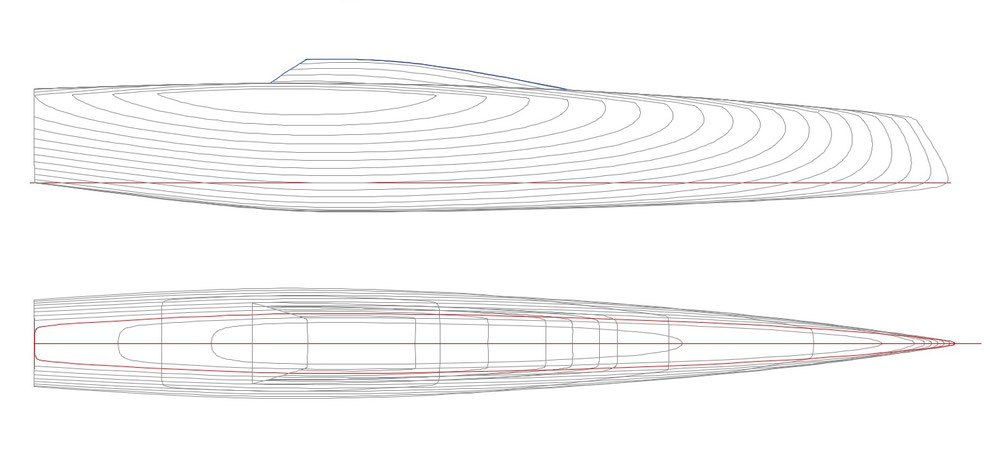
The hull lines for Design 256, 8.5m Cat. It's that hump in the rocker line - right under the back of the cabin that brought up the question and is one of the key points discussed here.
Hull fineness.
Fine hulls are fast, but only in the higher speed range. There’s a misconception I come across quite a bit that you can add weight and windage and you’ll still be fast as long as your hulls are fine.
Well you won’t be. Your boat will simply sink to find the new state of equilibrium. If your transoms are submerged you’ll have more drag. If your bridge deck is too close to the water you’ll have slamming. Much better to be conservative with your displacement figure in the design stage than overly optimistic.
And fine hulls have more wetted area so you have more drag in light air where friction resistance is the primary drag factor.
I’ve seen promotional material for catamarans stating that the boat has less wetted area because it has fine hulls. For a given displacement the minimum wetted area is described by a sphere (or a semi sphere in the case of a floating object). The more you stretch it out in length, keeping the displacement constant, the more wetted area you have.
The more you make the section shape into a deep V or a broad U with tight corners, as opposed to a semicircle, the more wetted area you have. Add into the equation finer hulls are slower to tack.
So fine hulls are only an advantage if your boat is light and has enough sail area to ensure you’re travelling at speeds where form resistance is greater than skin resistance.
In my view the advantage of fine hulls is often overrated as it applies to cruising cats.
At the other end of the scale the resistance curve is fairly flat up to about 1:9 which is still quite fast in most conditions. From there the resistance rises steeply as the hull gets fatter and at 1:8 and fatter you’re suffering from some serious form drag.

This is the rocker line isolated from the lines plan above (in blue) and and the red line shows a more moderate rocker line that achieves the same buoyancy and maintains the centre of buoyancy in the same position. The bow is to the right.
In the image lower right I've squashed it up and increased the height to make the difference in the lines more obvious.
The difference in the two lines is quite subtle, but races are often won or lost by seconds.
Rocker Profile
So if we’re looking for low wetted area we would want a rocker profile that was even and rounded, relatively deep in the middle and rising smoothly to the surface at each end. But this would give us a low prismatic which is not ideal in the higher speed range, and it’s not ideal for pitch damping which in my view is the critical design factor that is often underrated.
Pitching is slow. It destroys the airflow in your sails and the flow around the hulls, and your performance is suffering from slamming loads.
The single most effective way to counter pitching is with asymmetry in the water planes. You can achieve that in the with a fine bow and broad transom. Or you can achieve it with V sections forward and a flattened U shape aft. Or you can achieve it in the profile view with a very straight run forward and a bump in the aft sections. A flatter rocker line is better for resisting pitching than an evenly curved one with deeper draft in the middle.
The final result is a combination of all three of these factors.
On a cat like Design 256 the weight is concentrated well aft so we need to get buoyancy well aft.
The kink you see in the rocker profile helps to do this. It also helps to keep the rocker straight for most of its length and smooth the water flow exiting the hull aft at higher speeds, possibly promoting some planing effect.
If we had a more even rocker line we would slightly reduce the wetted area, but we would increase the pitching and the water would exit the hull aft at a steeper angle, increasing form drag in the higher speed range.
How much of a bump can you put in there without creating a flow separation, and how damaging would that flow separation be? I really don’t know. The way all of these factors interplay in the various conditions we sail in is very complex.
Ultimately a lot of this work is gut feel nurtured by experience, observing things in nature and most importantly experimenting and trying new ideas.
Is the new Groupama AC45 a breakthrough that will influence the form of racing catamarans into the future? I don’t think anyone has a computer that can answer that. We have to wait and see.

Symmetric and non symmetric water-planes. The blue line with grey fill is the DWL from the design above. As is typical with modern cat hulls the bow is long and fine, the stern is full and rounded. This is the asymmetry that has a damping effect on pitching. The red line on the other hand is more like you would see on a double ended monohull and quite a few multihulls have also used this shape in the past. It's quite symmetric about the pitch axis and does not have good pitch resistance.
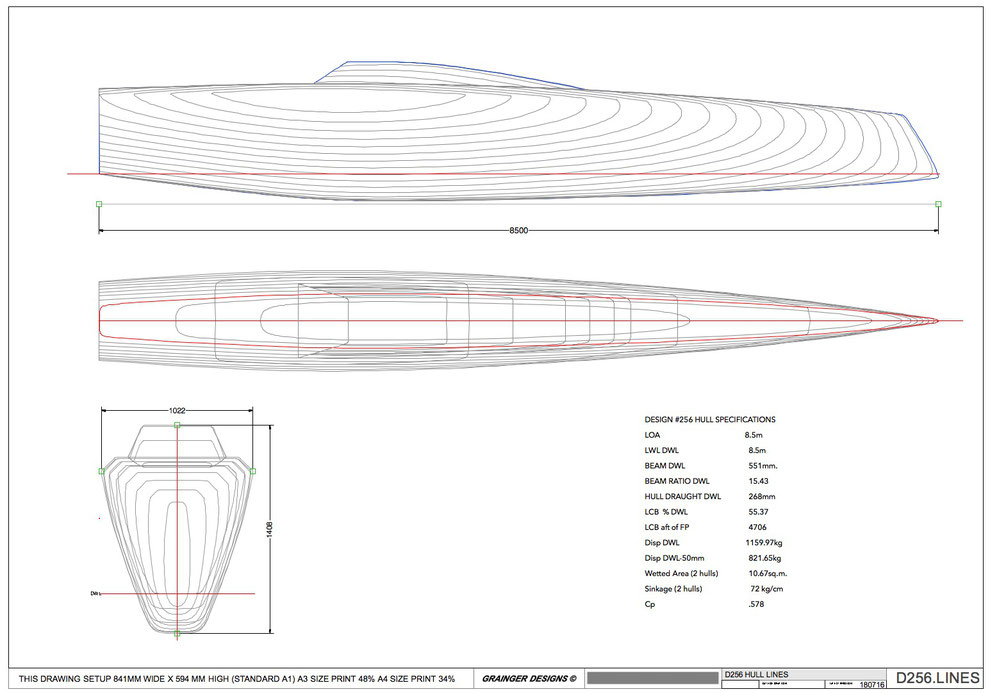
The hull lines of the new 8.5m Sports Cat Design 256
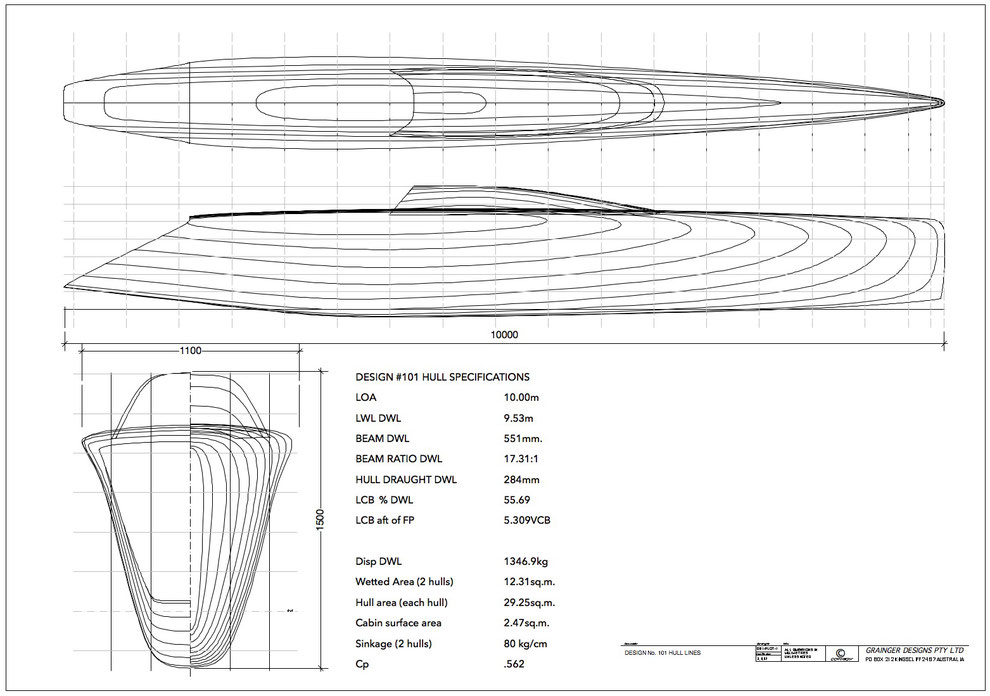
Mad Max , Previously Carbon Copy . She was designed in 1997 but she's the current (2016) title holder of the Australian Multihull Chamionships (2 successive years) and the fastest inshore racing boat in Australian waters.
Join the Newsletter

- Scroll to top

How To Create the Perfect Cruising Catamaran Layout
As an Amazon Associate, we earn from qualifying purchases. We may also earn commissions if you purchase products from other retailers after clicking on a link from our site.
More than ever before, sailing fans are gaining an interest in catamaran layouts and designs that define performance. Many others are also looking into either buying a cruising catamaran or designing and building one. While building a catamaran is no piece of cake, this article shows you how to create the perfect cruising catamaran layout.
To create the perfect catamaran layout, carefully consider factors like a good hull design, optimal helm station placement, boat stability, and adequate load-carrying capacity. Excellent galley positioning, ease of handling, and spacious living and sleeping quarters are also crucial.
The modern cruising catamaran is a far cry from the simple Polynesian double canoe of old. That’s because structural innovations and new composite materials have resulted in multihulls with impressive cruising abilities. Keep reading to learn more about exceptional catamaran layouts.
The Changing Trends in Catamaran Designs
The early cruising catamaran designs resulted in boats that could sail much faster than traditional sailing boats. In addition, they could glide with ease in shallow waters and required less wind and crew. Unfortunately, these cruising cats were heavy, had small, cramped interiors, and boasted somewhat challenging handling abilities.
Today’s cruising catamarans are different. They boast the utmost comfort, high speeds, and the safety of a well-designed cruising yacht. They are also more exciting, visually appealing, deliver the smoothest of rides, and sport more spacious interiors.
Have a look at the below video showcasing the top ten cruising catamarans:
Features To Look Out for in Catamaran Design Layouts
Cruising catamaran designers understand what most sailors look for in a cruising vessel. They, therefore, design cruising multihulls that address these pertinent issues and more. Some of the features you might want to consider having in your dream boat include the following:
- Responsive performance. Outstanding performance allows for pleasurable cruising and ensures your safety since you have more options during difficult weather.
- Excellent load-carrying ability . This allows you to have an extended cruising vacation or ocean crossing.
- Boat stability . Go for lightweight, robust construction, which results in a lot of buoyancy.
- A low center of gravity for smooth rides and enhanced performance. Centering weight around a low center of gravity improves the overall sailing quality, reduces pitching movement and reduces the risk of capsizing .
- Adequate bridgedeck clearance to reduce slamming and provide better performance in rough conditions. A high bridgedeck also means less noise and slapping action from the waves hitting the boat bottom, thus ensuring a quieter, smoother ride.
- Comfortable sailing. To enjoy a quality life on board, you need comfort while at sea. Thus, elements like gentle movement, no creaks or groans, no bridgedeck slamming, and minimal pitching are essential for quality, peaceful and restful sleep.
Now that you know what a cutting-edge catamaran features, let’s look at how to create the perfect cruising catamaran layout.
Build a Larger-Sized Catamaran
The early catamarans ranged between 36-42 feet (10.9-12.8m). At the time, this appeared to be a good size in terms of safety and ease of handling. However, the boats were heavy, and the additional drag and displacement adversely affected their performance and windward ability.
It’s now possible to make the new generation catamarans lighter, larger, and more spacious with excellent power-to-weight features. The current trend is larger-sized catamarans in the 45-50 feet (13.7- 15.2) range. Composite engineering and technologically advanced equipment such as furling systems, electric winches, and autopilot make it easier for a smaller crew to sail larger boats with confidence. And to do so without compromising safety or stability.
Get the Best Catamaran Hull Design
A cruising catamaran’s performance depends on three main aspects; its length, the sail area, and the boat’s weight. Long boats are generally fast. A light boat with more sail area is also faster than a heavier boat with less sail area. In other words, you can make a multihull faster by making it longer, lighter, or adding more sail.
However, there are exceptions to this rule; a boat with too much sail area is more likely to capsize if there are brisk winds. Also, if the boat’s design makes it too light, it’ll be unable to handle much punishment, while a hull design that’s too slim would make the vessel incapable of carrying any significant loads. But that’s not all; if the boat is too long or too large, it’ll become grossly exorbitant. Narrow hull shape might also mean smaller cabins.
Nonetheless, these three factors alone are not enough to determine a cruising catamaran’s performance. While faster boats boast finer hulls, the wetted surface area tends to increase as fineness increases; thus, fine hulls end up becoming less fast in low wind speeds. Also, very wide hulls mean a reduction in actual performance.
The Prismatic Coefficient (Cp), a measure of how full the ends of the hull get, is the most essential design hull shape factor for any catamaran. A high Cp equals high speeds, although you can still use a lower Cp if you have fine hulls. Nevertheless, the key to a good Catamaran design is a higher Cp for fast sailing.
To achieve a high Cp, there are several things you can do:
- Fit bulb bows . Unfortunately, the bulb bows tend to slam in a seaway when you do this.
- Have an extensive planning aft section . However, this can increase the wetted surface area, WSA and lead to additional challenges.
- Flatten out the hull rocker and add a bustle aft. This helps to add displacement aft.
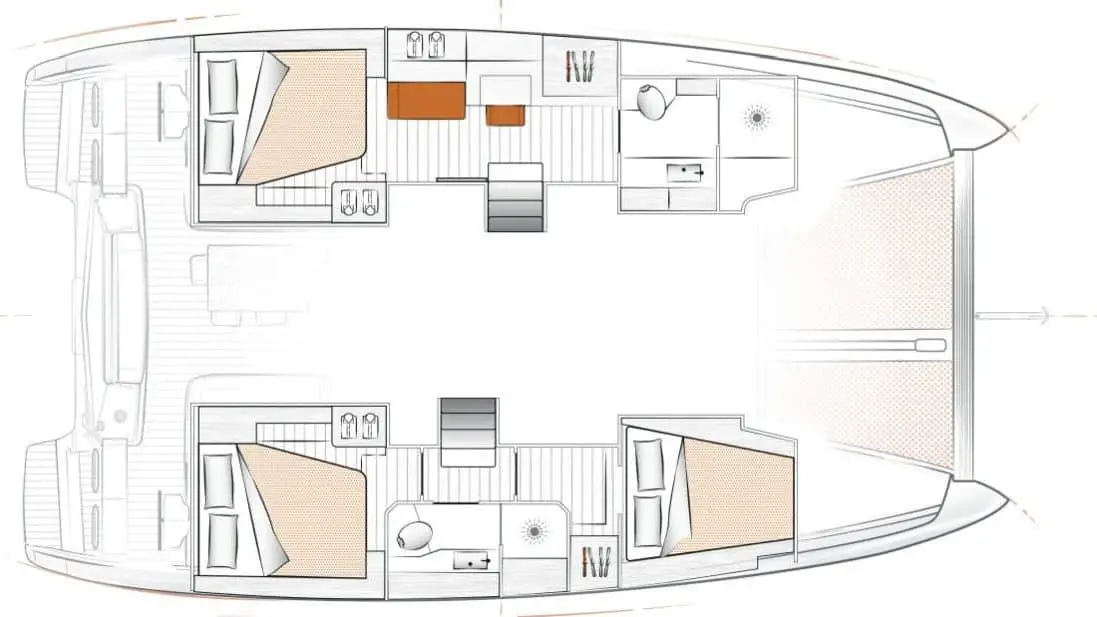
Build Convertible Main Living Spaces
The open cockpit is now a thing of the past. Instead, pioneering designers for catamaran manufacturers like Nautitech, Gunboat, and Catana now replace traditional-style salons, cockpits, and cabins with spacious indoor and outdoor living spaces. The concept involves merging separate saloon and cockpit areas with duplicate lounge spaces and the use of hard-wearing composite materials.
You can also design the cabin to suit your preferences. You may decide to add a cabin or remove one, add a bathroom, have the forward berth in the hull or on the wing deck.
- The design enhancements boost usable space while opening up the living areas.
- It reduces time and costs for interior maintenance and cleaning.
- Large windows bring in more light, increasing visibility.
- Luxurious, spacious, and airy owners’ cabins provide more comfortable living space.
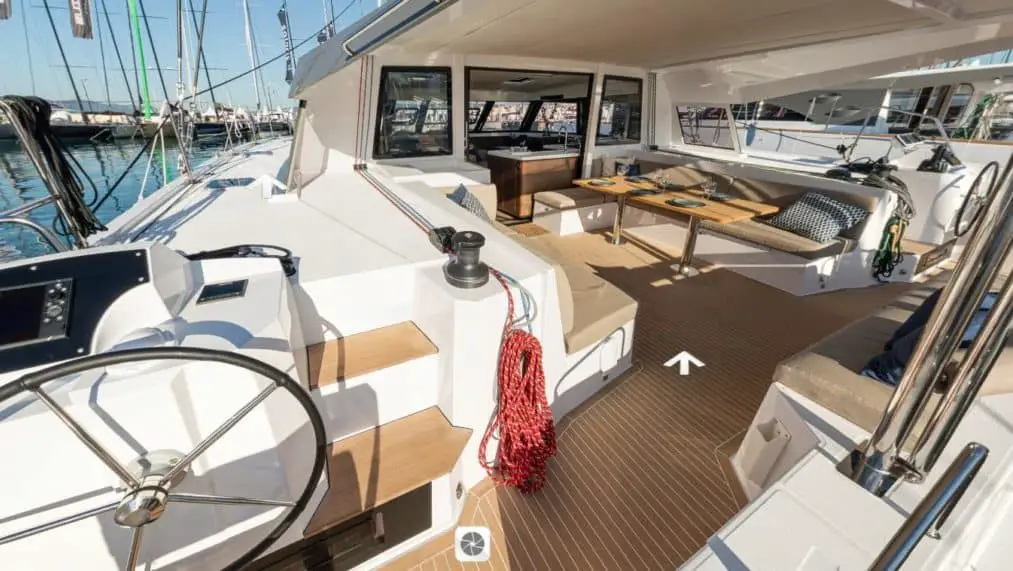
Bulkhead Helm Stations vs. Twin Stern Steering
Many catamaran owners have traditionally preferred bulkhead steering. This helm position remains popular, but twin stern steering positions come with more advantages since they provide greater sails visibility. The twin stern positions are also best suited for racing or day sailing since they often lack adequate protection for extended cruising.
Exposed helms are not ideal for a long ocean passage. Go for a safe, secure, and well-protected helm station that provides good visibility and comfortable space for long watches. Again, it’s best to have all control lines at the helm to establish a static control station. Also, have all push-button-controlled winches, instruments, windlass, and autopilot prominently located inside the cockpit.
- Twin stern steering positions give you a better view of the sails
- You get a better feel for overall sailing conditions.
- Twin stern steering positions lack the necessary protection for extended cruising.
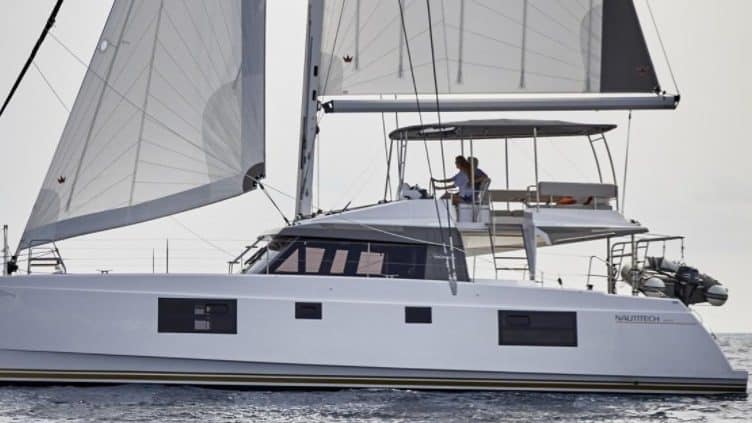
Go for the Flybridge Design
The flybridge design is appealing because it offers excellent visibility, more comfort, and additional entertainment and lounging space for everyone on board. Unfortunately for smaller boats – those below 50 feet (15.24m), there is minimal protection from the elements. As such, you might want to consider adding enclosures to offer protection. The flybridge, thus the helm, remains cut off from the vessel, which makes communicating with the crew a challenge.
- It provides great visibility.
- It offers comfortable spacing.
- It might be unsafe to move from the cockpit to the flybridge in bad weather.
- It isn’t easy to communicate with the crew.
Daggerboards vs. Fixed Keels
Average cruising catamarans typically utilize fixed keels while high-performance cats have daggerboards . Fixed keels allow you to beach your catamaran easily, and your hull remains intact if a collision occurs. While you lose some angle when sailing upwind, you gain more interior space in the hulls that you can put to good use.
Daggerboards are essential in a performance cruising catamaran since they guarantee that the boat delivers good upwind sailing, including during difficult situations. During long passages, they allow you to point better upwind though the drawback is that they consume much interior space within the cruising catamaran’s hulls.
Since flying on foils ( hydrofoils ) isn’t that practical on cruising catamarans, designers of larger-sized boats have also come up with modified daggerboards. These daggerboards produce lift and prevent leeway, too, thereby improving performance significantly, as seen with the Catana 59’s curved daggerboards. These foil-like daggerboards lift the boat ever so slightly upon reaching higher speeds, making it feel less heavy and much faster.
At the end of the day, calculating the performance of a boat sailing in a wide range of varying seas and winds might not be easy – despite a daggerboard or fixed keel configuration. This is because upwind speed depends not only on the sails’ quality but also windage and the height of the bridgedeck beyond the water.
- The design innovations -curved daggerboards and hydrofoils- improve catamaran performance significantly.
- Daggerboards enable you to access otherwise inaccessible anchorages.
- Daggerboards take up hull space in the hulls of your vessel.
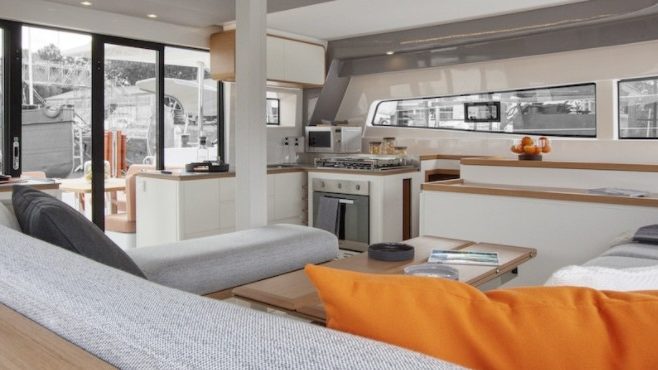
Galley Up vs. Galley Down
Galley layout are becoming more and more important as more people, including families, start sailing regularly. While at sea, your galley needs to be a safe place, well-ventilated, and functional. Everything should be well-thought-out for the sailor’s comfort, including handholds to make it safer to move around the boat.
While the galley location can either be up the bridgedeck or down in the hull, galley up appears to be the most popular trend. This makes the galley the focal point of both the living space and entertainment areas.
If you have a family, this placement is ideal since you make your meals from the galley and get to spend most of your time here. Many cruising families and couples prefer this arrangement and find separating the galley down the hull unappealing. Besides, carrying hot food up and down the staircase is unsafe.
Still, galley down is ideal for charter boats since it offers a private cooking area and uses up hull space efficiently.
- Having the galley on the bridgedeck is ideal for families and cruising couples.
- Placing the galley on a similar level with the serving area and cockpit is safer and less tiring.
- There’s better ventilation on the bridgedeck, making for comfortable cooking.
- There’s less kitchen privacy galley up.
- On smaller catamarans, this layout can impact the size of the saloon seating area significantly.
Production Catamaran vs. Custom
The choice of either a production catamaran or a custom design might seem pretty straightforward. Production catamarans from major brands come backed by proven designs, dependable construction, solid warranties, and many years of experience. The catamarans are easy to service, source for parts, and most – particularly the owner’s versions – hold on to their value, making them much easier to resell.
On their part, custom boats are fantastic in that you can tailor them to your exact needs. However, they might be more challenging to maintain or service. That’s because of parts unavailability and lack of construction knowledge.
Choose Quality Construction Materials
The best quality materials to use on your catamaran are both light and robust. While carbon fiber is great, plywood, plywood/epoxy, and strip-cedar are excellent materials too. What’s more, they are also affordable, so you don’t have to get too hung up on cutting-edge building materials. What matters is build quality; thus, a well-built plywood catamaran boat can last as long as a boat made from more high-tech materials.
Combining various materials also helps combat some of the issues that plague plywood boats in terms of resale value. At times, the design tends to make the boats appear pretty dated.
- Plywood and strip-cedar materials are affordable and provide excellent build quality.
- Plywood boats may have a lower resale value than those built with modern materials.
Consider Ease of Handling
An important factor in handling a cruising catamaran is deck layout. Most cruising catamarans sailed short-handed , so if your boat has one helm, all lines should run back here to allow for a static control station for the entire boat.
The other essential element is visibility from the helm. The 360 degrees of visibility while maneuvering, docking, or underway is crucial to your boat’s safety, as well as life and property. As such, you should be able to view both bows, or at least the pulpits and sterns, while standing at the helm. If not, you may have challenges handling the boat due to blind spots.
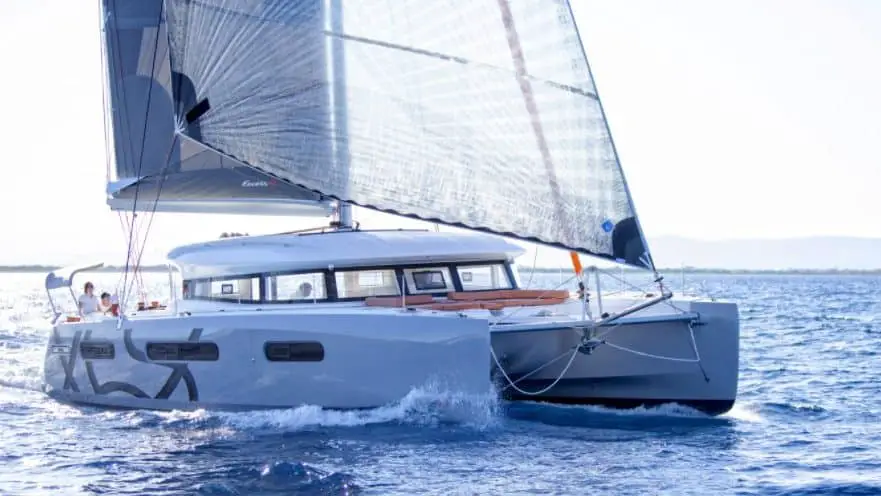
Consider the Load Carrying Capacity
A well-designed catamaran is enjoyable to sail in all weather conditions. It’s also much easier to handle than a monohull because of its widely spaced twin engines. But when you immerse extra hull depth, the vessel gets sluggish and moves slower, maneuvering in tight spots or when docking becomes more challenging. Furthermore, the hull submersion reduces bridge deck clearance, leading to hull slamming.
To allow for adequate load carrying capacity, you need a design that provides a generous displacement. This helps to ensure that you maintain reasonable bridge deck clearance even when fully loaded. It also allows you to avoid digging big holes in the water as you drag your transoms.
Displacement refers to the amount of buoyancy designed into the hulls, which essentially means that your boat will cruise better if its weight is less than your designed displacement.
Note that an overloaded catamaran not only loses out on performance but eventually, on safety too. To counter this, choose a lightweight catamaran with hulls bearing cored construction and interiors made of lightweight materials.
Remember, when you go cruising, you will need to carry fuel, extra water, supplies, equipment, and amenities, translating into thousands of extra pounds. Therefore, try and avoid the following design errors to ensure that your catamaran has an adequate load-carrying capacity:
- Avoid putting in place too much accommodation space.
- Avoid building a heavy boat ‐ use low-tech construction materials.
- Avoid installing inboards in a small boat.
- Lightly constructed catamarans perform faster and carry more weight.
- Cored construction makes for a strong and stiff catamaran, thus enabling good performance.
Final Thoughts
A well-designed cruising catamaran is a joy to behold. Today’s modern technological advancements mean that you can buy or build a light but strong cruising catamaran. And as you can see from this article, there are many excellent cruising catamaran layouts that you can choose from.
However, whichever layout you decide on needs to fit your sailing needs and purposes to ensure you remain comfortable and safe while at sea. Above all, ensure that you go for a vessel that you can handle with ease in all weather conditions.
Owner of CatamaranFreedom.com. A minimalist that has lived in a caravan in Sweden, 35ft Monohull in the Bahamas, and right now in his self-built Van. He just started the next adventure, to circumnavigate the world on a Catamaran!
Leave a Reply Cancel reply
Your email address will not be published. Required fields are marked *
Save my name and email in this browser for the next time I comment.
Recent Posts
Must-Have Boat Gear for Catamaran Sailors!
Sailing is probably the most gear-intensive activity I've ever done; there are so many decisions to be made about what gear to buy now, for tomorrow, and what to definitely never buy. The gear on...
6 Best Trailerable Trimarans For Bluewater and Coastal Sailing
Having a boat costs a lot of money, even when you are not using it, marina fees, etc. And once it is in the water most sailors never go very far from their "home marina" and sailing will be somewhat...
Did You Know That We Offer Contract to Closing Services? Click Here to Find Out More.
Need Marine Financing? Apply Here With Our Partner, First Approval Source
- Catamaran Interviews
- Catamaran Reviews
- Buying Advice
- Selling Advice
- Woods Design Advice
- Americat 3014
- Balance 526
- Bali 40 Catspace
- Beneteau Blue II
- Broadblue 346
- Broadblue 38 Prestige
- Broadblue 385
- Broadblue 435
- Broadblue 46
- Catalac 10M
- Catalac 11M
- Catalac 12M
- Catalac 900
- Catana 42 S
- Chris White 48 Voyager
- Chris White 55
- Corsair F28 R
- De Villiers
- Dolphin 460
- Endeavour 30
- Endeavour 35 Victory
- Endeavour 36
- Endeavour 44
- Endeavour 44 TrawlerCat
- Fortuna 36 Island Spirit
- Fortuna 401 Island Spirit
- FP 32 Maldives
- FP 35 Tobago
- FP 37 Antigua
- FP 38 Athena
- FP 39 Fidji
- FP 40 Lavezzi
- FP 40 Lucia
- FP 40 Summerland MY
- FP 41 Lipari
- FP 42 Astrea
- FP 42 Venezia
- FP 43 Belize
- FP 44 Helia
- FP 44 Orana
- FP 46 Bahia
- FP 46 Casamance
- FP 48 Salina
- FP 56 Marquises
- FP 57 Sanya
- FP 60 Eleuthera
- FP Saona 47
- Gemini 3000
- Gemini 3200
- Gemini 3400
- Grainger 420 Mystery Cove
- Hirondelle 7M
- Lagoon 37 TPI
- Lagoon 42 TPI
- Lagoon 43 PC
- Leopard 39 PowerCat
- Leopard 45 Classic
- Leopard 47 PowerCat
- Leopard 51 PowerCat
- Leopard 53 PowerCat
- Maine Cat 30
- Maine Cat 41
- Matrix 450 Vision
- Matrix 760 Silhouette
- Maverick 400
- Maverick 420
- Maverick 440
- Nautitech 40
- Nautitech 442
- Nautitech 46 Open
- Nautitech 47
- Outremer 40
- Outremer 45
- Outremer 50 Standard
- Outremer 55
- Privilege 37
- Privilege 39
- Privilege 42
- Privilege 43
- Privilege 435
- Privilege 45
- Privilege 465
- Privilege 48 Transcat
- Privilege 482
- Privilege Serie 5
- Prout 31 Quest
- Prout 33 Quest
- Prout 34 Event
- Prout 35 Snowgoose
- Prout 37 Snowgoose
- Prout 37 Snowgoose Elite
- Prout 38 Manta
- Prout 39 Escale
- Royal Cape 45
- Royal Cape 530 Majestic
- Royal Cape Majestic 500
- Sailcraft 30 Iroquois
- Sailcraft 32 Comanche
- Sailcraft 35 Cherokee
- Sailcraft 41 Apache
- Sailcraft 44 Apache
- Wildcat 350
- Seawind 1000
- Seawind 1160
- Seawind 1200
- Seawind 1260
- Seawind 1600
- Solaris 36 Sunrise
- Solaris 36 Sunstar
- St Francis 44
- St Francis 48
- St Francis 50
- Stealth 11.8
- Heavenly Twins 26
- Ocean Twins 38
- Voyage 380 Maxim
- Voyage 400 Norseman
- Voyage 430 Norseman
- Voyage 450 Cabriolet
- Voyage 47 Mayotte
- Wharram 38 Tiki
- AMI 320 Renaissance
- Woods 22 Wizard
- Woods 35 Banshee
- Woods 35 Flica
- Woods 36 Scylla
- Woods 36 Vardo
- Woods 38 Transit
- Woods 40 Meander
- Xquisite X5
- Xquisite X5+
Catamaran Construction – Hulls, Laminates, and Composites
- Post author By BJ Porter
- Post date October 15, 2020
- 3 Comments on Catamaran Construction – Hulls, Laminates, and Composites

It’s a given that catamarans are more sensitive to weight and loading than monohulls. Catamaran builders strive to build the lightest boats they can without sacrificing strength and stiffness, and have adapted new building techniques and materials to meet this target. Cutting weight allows more passengers and gear without sacrificing performance.
And the marketing materials reflect it–they load every review and website with polysyllabic technical jargon describing the design and production choices each builder made to deliver the best boat they can.

But when you’re reading a brochure and you come across phrases like “ hand laid bidirectional GRP ” or “ vacuumed bagged e-glass with vinylester resin over a Divinycell core ” do you know what that really means?
All modern production catamarans are made with “FRP” construction (for Fiber Reinforced Polymer). Composites aren’t new–it’s just using materials together to strengthen the whole assembly. Straw was added to bricks centuries ago, and steel reinforced concrete is a staple of construction over the last century. For boats, it’s the use of stranded fibers and cured resins which make FRP different.
The term “FRP” doesn’t get into the technical detail of which fibers and which plastics, and how they’re put together to build your hull. There’s a wide variety of fiber types which can be stranded, woven, chopped or sprayed in a varied of patterns then combined with several types of resins to make hulls with different characteristics.
Some FRP techniques produce lighter, stronger shapes, while others are quicker to build and less expensive to produce. The choice of technique is a function of many factors, from the number of hulls and parts to be built, the type of parts, the budget for the project, and many design specific requirements for weight and strength.
1. FRP Basics
The principle behind all FRP construction is the same – you lay our fibers in the shape you need, then saturate them with resin, removing all the air and voids you can. Resin is left to cure, then the piece is ready to finish and use.

The reality is more complex, since building a boat isn’t like making a flat board or a simple door. You’ve got a complex shape with a designed set of curves to build. “Tooling” is the set of shapes to make the boat parts; molds to cover with fiberglass to get the right shapes.
That’s what makes FRP so effective – you can make almost anything out of it. But to do so requires a lot of choices about what you need for the project at hand.
There isn’t a “best” all around material or technique choice for all jobs, and sometimes a lower cost technique or easier to work with material may be the better solution to the problem.
A. Fiber types
Fiber choices in the last few decades have expanded past the glass fibers used in the first mass produced boats in the 1960s. FRP construction wasn’t new even then, they built the first composite boats using modern fiberglass in the 1940s.
The major fibers used in marine construction fall into three categories – glass, aramids, and carbon. The primary differences are in the strength to weight ratios of the fibers, durability, elasticity, and cost. Some construction may use blends of fiber types to combine performance characteristics.
Glass – the most common material still, because of its low cost and versatility. The most common variety used in GRP (Glass Reinforced Polymer) is “E-glass” which refers to its strand size and mineral content. Other grades have different and sometimes better mechanical properties, but may be more expensive and less appropriate for boat building use. Fiber sizes run 10 to 25 microns for E-glass, though other grades may be smaller.

Brands like Leopard, Lagoon, and most higher production volume builders use E-glass.
Aramids – this includes brand names like Kevlar, Technora and Twaron. They have higher tensile strength than E-glass, and resistant abrasion and punctures. Kevlar is a common choice for bullet proof body armor, and can built a tough, lightweight hull. The materials can be difficult to work with, as it is very tough to cut the cloth. It is often blended with carbon fiber or other materials – Catana is known for using Twaron blends in hull construction.

Carbon – the ultimate in lightweight, strong construction material. Carbon fiber is the most expensive fiber, and is available in a variety of weights, grades and strengths. Fibers are smaller than glass – down to 5 Micron.
The lightest, most expensive hulls are made from carbon, but a catamaran builder may use carbon in places other than the hull to add strength and stiffness. Carbon boards, rudders, and reinforcing structures can enhance performance without driving the price of the boat beyond reach. Carbon is the fiber of choice for many custom builds, racing cats, and Gunboat.
B. Mats, Strands, Roving, Direction, and Weights
Fibers are woven into matting and cloth for construction. Depending on the application, different weights of cloth and cloth patterns and weaves may be more appropriate for the job.
Cloth weight refers to the weight per square yard (or meter) of the cloth. A square yard of nine ounce cloth weighs nine ounces. The heavier the cloth, the stronger it is in a laminate.
Fibers carry loads along their length, so cloth weaves have directionality to their strength. Most builders use several layers of cloth with different orientations to give good universal strength to hulls. Specific FRP applications with strict load-path requirements may have more unidirectional fiber layering – for example, a chainplate manufactured from carbon fiber may use unidirectional fiber.
Cloth – fiberglass cloth is commonly used on outer layers of composites. Cloth may have unidirectional or bidirectional strength. Bidirectional cloths have maximum load strengths in two perpendicular directions. Variations on weaves like a modified twill allow a more flexible cloth for better shaping around complex molds.
Mat – is omnidirectional strands of fiber compressed into a cloth. This is often held together with a resin soluble glue, which makes mat great at conforming to mold shapes without folding and bunching as it collapses when wetted. Because the strands do not align, fiber strength is the same in all directions.

Woven Roving – a heavier cloth made from larger bundles of strands. Woven roving allows for quicker buildup of material and strand weight.
Most FRP layups include multiple layers of different cloth and mat. Finished layers may be finer cloth over courser cloth, over woven roving and mat.
Three primary resins are in common use in marine construction – polyester , vinylester , and epoxy . All resins have materials safety concerns and require care in their use and handling.
Polyester is the least expensive and requires breathing protection because of the VOC emission (Volatile Organic Compounds…nasty, smelly fumes). It doesn’t have good bonding/gluing capability, and should only be used with glass fibers for structural building. Some polyester resins are referred to as “isophthalic” resins.
Vinylester is chemically similar to a hybrid of polyester and epoxy, and performs best with fiberglass. It shouldn’t be used in high strength applications with carbon or aramid fibers. It has some adhesive qualities which polyester lacks, it shrinks less during curing, and has better impact resistance.
The added strength of vinylester coupled with increased water resistance makes it an attractive option for many catamaran builders. It costs less than epoxy, but still has better performance than polyester.
Epoxy is the most expensive, but is three times the strength of the others. It offers the best adhesion and the only resin for building structural elements with carbon and aramid. It resists water intrusion better than the other resins, resists blisters, emits no VOCs, and shrinks less. The major drawback is it is more brittle if it takes an impact.
While epoxy is “the best” in terms of strength and ease of building, there are many applications where other resins are appropriate. Budget is a big driver – a boat made from E-Glass doesn’t need epoxy resin, and considerable cost savings to meet a construction price target may drive the choice.
They can build quality boats from all material combinations, but price and performance will drive materials choices to keep some boats more affordable.
2. Cored Construction
What’s the best way to make fiberglass strong? To a point, you can make it thicker. As it gets thicker, it gets heavier. A hollow shape can take more compressive load than a solid one of the same weight, and the same principle applies to fiberglass construction.
Consider an I-Beam used in building construction. It has the same strength (or more) as a solid rectangular beam of similar mass. The compressive load on the beam is supported by the outside edges of the material, the metal in the middle doesn’t contribute much to the strength. So we can remove metal to get the “I” shape while still keeping those sides rigid, making a lighter girder with less material.
The same principle applies to cored construction with fiberglass. Making a sandwich of two layers of fiberglass with a light core between them allows for the greater strength with weight savings.
There are drawbacks – the biggest risk is damage which breaks the skin, which can let water into the core. Earlier cored construction used materials prone to saturation and rot if they got wet. Some builders opt to do cored construction above the waterline and solid below to minimize some of these risks.
But the advantages in weight savings and increased stiffness offset the drawbacks, and there may be a few other side effects like sound and temperature insulation. Like resins and fibers, core materials offer distinct advantages, disadvantages and price points.
Most builders have adopted a hybrid approach, building solid hulls below the waterline, and cored hulls and decks above. This gives a balance of weight and safety.
A. Balsa Core
Balsa is light and inexpensive. The first cored construction used balsa, but it has the disadvantage of being wood. As a natural material, if it gets wet it can rot and break down. Builders use “end grain” balsa – shorter cross cut sections – to prevent wicking of water if there is an intrusion.

B. Foam Core
Closed cell foam cores give good strength to weight savings while minimizing water intrusion. If you get water in the core, it won’t spread very far. Divinycell is a popular PVC foam core, though there are several choices with different densities and compressive strengths.

Some foam cores are not suitable for heat treatment, but infused or vacuum bagged boats like the Outremer and PDQ do well with it.
C. Honeycomb
Honeycomb cores are often the most expensive, but also give some of the best strength to weight ratios. Honeycombed cells made from resin cured aramid papers are some of the best, but also among the most costly. They offer good stiffness, but can be hard to shape. Aluminum and other resin-infused papers are other core materials builders can choose from.
3. Construction and Resin
When building a hull, there are optimal ratios of fiber to resin saturation for target strength and weight. Too little resin and you may not have enough strength (or worse, voids and gaps), and too much, and you’re just adding weight without adding strength. Resins are also a significant material cost in building the boat, so over application not only increases weight but adds cost.

There are many ways to assemble the cores, fibers and resins to build a finished laminate hull – we’re addressing the most common in boat building. Each approach has strengths and limitations, and an impact on the bottom-line cost to build the boat. Any voids or air pockets in the laminate can be disastrous; these techniques have been developed to increase saturation and reduce the risk of voids.
A. Hand Layup / Open Molding
As the name implies, this is the application of resin by hand to cloth as it’s laid into a mold. Wetting is done with a brush, and the laminate is rolled out to remove any air pockets and voids. This is the simplest way to lay up fiberglass, but also the least precise and consistent and will use the most resin.
Skilled craftsmen have built some of the finest vessels in the world this way. Though it’s more popular with monohulls, which are less sensitive to weight, many catamarans built with hand layups on open molds are still out cruising and performing well.
B. Spraying
Using chopped-strand fiber mixed with resin, a “chopper gun” can spray the mixture into a mold to lay down the composite. A consistent thickness can be difficult, but this is a low cost construction technique which makes a very resin-rich laminate. Using sprayed fibers gives lower strength in all directions compared to meticulously laid down mat and bi-directional cloth. But it is a quick technique popular with mass produced, smaller boats.
It is an excellent technique for parts with complex geometry where weight is not an issue, but you will not see it often in catamaran construction. It’s heavy with resin without any resultant increase in strength.
C. Vacuum Bagging (Wet layup)
When an open molded component has been laid up and wetted with resin, vacuum bagging takes the process a step further. After the wetting is complete, air tight plastic bagging is secured around the wetted area, and the air is pumped out of the bag. The vacuum pulls excess resin out and collapses air pockets.

The goal is to get thorough wetting and produce as strong a laminate as possible without excess resin. Knysa and Leopard are two builders that use vacuum bagging on their hulls to reduce weight.
D. Resin Infusion
For resin infusion the cloth, matting and core is laid in place dry, then sealed in an air-tight bag. A vacuum pump attaches to one side of the bag, and on the other a feed for resin. The vacuum sucks the air out of the dry cloth stack, then pulls the resin through the stack, infusing and wetting it.
Resin infusion, when done right, gives the lightest, strongest laminates with no voids and the minimum resin weight for maximum strength. SCRIMP is a variant of the resin infusion process used by some builders, including TPI which build many early Lagoon cats.
E. Pre-preg
Using pre-preg (for “Pre Impregnated”) cloth for your laminating gets rid of the resin bucket. They manufacture cloth with a partially catalyzed resin pressed into it, then it’s chilled or frozen to stop the curing process. There is no need for seperately mixed resins, and there’s no worry your resin might “go off” and harden before you’re done wetting the cloth. Instead, the cloth is assembled, vacuumed, then heated to kick off the curing process.
There are both advantages and disadvantages to using pre-preg for your laminate work. The big disadvantage is the cost; it is most expensive material to use. You also need to chill and store the cloth until you need it, though some can be at room temperature for a couple of weeks without kicking off. And you need an oven which requires some clever tricks if you’re building a forty or fifty foot boat.
But the strength to weight ratio will always be perfect. High tech honeycomb cores are best suited to pre-preg lamination, and without racing against resin cure times, you can ensure perfect cloth placement and precise layout in the build process.
The primary use for pre-preg in boating is high performance race boats. With catamarans, pre-preg may be used high load parts, like Gunboat does for foils and rudders.
4. Industry Examples
Across the catamaran building industry you’ll find almost all the above techniques and materials used, though some are less common. You aren’t likely to find chopped strand sprayed layups in ocean going cats, and hand layups can lead to heavier hulls than weight sensitive catamaran designers prefer. Most manufacturers have moved to vacuum bagging or resin infusion, with a few of the highest end boats using pre-preg for key components.
Built by Robertson & Caine in South Africa, the hull material is vacuum bagged, end-grain balsa-cored E-glass with polyester.
Hand laid, bagged vinylester over an Airex foam core in the hulls.
Earlier Prout catamarans like the Snowgoose 34 featured hand laid solid FRP hulls and decks. Over time they switched to foam or balsa cores for decks and above the waterline.
Older PDQ boats were made from vacuum bagged vinylester – solid below the waterline and cored with CoreCell foam above the waterline and in decks. Newer PDQ models switched to epoxy resin.
All glass is vacuum bagged. Below the waterline is solid E-glass and vinylester. The rest is unidirectional, bidirectional, and triaxial cloths over a Nida-Core polypropylene honeycomb core with isophthalic and vinylester resins.
The Gemini cats are built with a solid hand layup of woven roving and fiberglass mat and polyester resin. Decks are cored with end grain balsa. The Gemini 3200 introduced vinylester resin into the layup to prevent blistering.
Older Lagoons were SCRIMP infused vinylester with and end grain balsa core above the waterline and in the decks.
Newer Lagoon catamarans use polyester and vinylester resins, also infused with balsa cores above the waterline and solid below.
With a carbon fiber inner skin, Catana also uses Twaron aramid fibers in the sandwiched hull over a foam core.
Fontaine Pajot
Primary hull construction is resin-infused vinylester with a balsa cored hull and deck.
Beneath the waterline, Outremer uses a single layer, solid vinylester laminate for safety. The hulls and deck are vinylester with a Divinycell foam core. They stiffen certain components with carbon for rigidity and durability.
Gunboat hulls are epoxy infused carbon fiber with a Nomex honeycomb core. They build dagger boards and other high load components with pre-preg carbon.
- Tags Buying Advice

By BJ Porter
Owner of Hallberg Rassy 53; world explorer.
3 replies on “Catamaran Construction – Hulls, Laminates, and Composites”
Excelent. Thank you for this I learned allot. Johan
Very straight forward information. Thankyou for doing this.
Damn…What an Amazingly Informative Article. *Cheers*
Leave a Reply Cancel reply
Your email address will not be published. Required fields are marked *
Save my name, email, and website in this browser for the next time I comment.
Hull Hydrodynamics and Design
2.1 Resistance Components on a Hull
Since the main objective of this project involves investigating the resistance of a hull and how it is affected by the introduction of hydrofoils, it is important to understand the components of this hydrodynamic resistance. Additional components will be added with the addition of the lifting foils and the interaction between the hulls and foils will also need to be accounted for. These will be discussed in chapter 3.
2.1.1 Viscous Resistance
The first and most obvious resistance comportent is the visco 3 resistance resulting from the hull skin friction and viscous pressure drag. Viscous resistance is^ç pendent on Reynolds number and so for equivalent scaling of the model we would require Reynolds similaijify.
2.1.2 Form Resistance
Another component is the form resistance. This resistance component results from the shape of the hull as the fluid is forced to change direction (and speed as a result) in order to travel around the hull. This is modelled by simply adding a form factor (1+k) to the viscous resistance, which is roughly equivalent to the average increase in speed required to travel around the hull.
2.1.3 Wave Resistance
The next component is wave resistance. This resistance component results from the additional energy required to create the waves resulting from the hull travelling through the water. These waves may be divided into the following categories - diverging (from bow and stern) and transverse waves. For equivalent scaling, Froude similarity is required. Note: fluctuations in wave resistance are as a result of both interference of the bow and stern wave system (as discussed by Bertram [Ber02]) and the wave interference of the two demi-hulls to be discussed in Chapter 2.1.9)
2.1.4 Spray Resistance
This resistance component is a result of the energy required to produce the spray. It is however expected that since the given hull shape is semi-displacement and the speed range is not very high, this is not expected to be a very large component.
2.1.5 Interference Resistance due to foils
This is the added resistance due to interference of the boundary layers of the hull and foils where they join. This is discussed in section 3.2.4 where the low pressure above the foil creates a downward suction on the hull, which in turn cancels some of the lift generated by the foils. In terms of hull resistance, the reduced pressure and associated increase in flow in the gap between the hull and foils would result in an increase in viscous resistance. This may be factored by a change in the form factor on the hull due to foils. Since only a percentage of the hull is affected and at speeds where the effect is strong, the hull will be elevated from the water substantially, this is not expected to be large, but may account for errors in assuming minimal interference between hull and foils.
The wave interference of the foils and hull niay be pMisidtereo as acting on either the hydrofoils or the hull. It is a function of speed and positioning of foils. Migjiotte [Mig9^] indicates that these effects are both significant but no means of determining them theoretically or empirically are available.
2.1.6 Heel Resistance
This is simply the change in resistance (primarily wave and viscous) due to heel. An empirical equation describing the coefficient of resistance and its corresponding formula is found in Larsson et al. [LE02] however this is for a monohull, which behaves very differently to a catamaran. The main difference is that for a catamaran, the WSA is remarkably reduced with heel as the one hull emerges from the water, thus reducing the viscous resistance. It is however interesting to note that from the formula, the effect of heel resistance increases with the square of the Froude number. It must also be borne in mind that heel has other implications also as the force vector on the sail gains a vertical component with heel. Normally this is assumed to cancel with the upward component on rudders and daggerboards [LE02] but with the addition of lifting foils there is an increase in sideward component due to the heel angle and a righting moment due to the free surface effects.
2.1.7 Induced Resistance
Normally this resistance is associated with hydrofoils and is explained in more detail in chapter 3.2.1. If the hull is thin, it may be thought of as a symmetric hydrofoil of low aspect ratio, operating in the vertical plane. If there is an angle of attack or leeway angle on the hull, there will be a resulting side force and induced resistance. Since the effective aspect ratio and area of the hull are relatively small, the daggerboards and rudders will offer most of the resistance to leeway, and induced resistance on the hull is expected to be very small.
2.1.8 Resistance due to Submerged Transom
Transom sterns have several advantages, the most important being that the wetted area (and hence viscous resistance) is less than that of a hull with a streamlined stern while still producing an equivalent wave pattern. [DD97]
When the transom of the hull is submerged at low speeds, the flow does not separate cleanly off the transom and therefore produces a large stern wave due to the sudden change in flow direction. At higher speeds, the velocity pressure of the flow under the transom is sufficient for separation resulting in 'smooth' flow off the stern and reduced resistance (see figure 2.1 below). This means.that the LCG may be placed further aft for high speeds, but the transom must be preferably in Ii tie with the water level for low speeds.
Doctors et al. [Doc98] quantified the speed at vhich flow off the submerged transom becomes 'cleanly separated' in terms of a Froude number based on depth of the transom below the static waterline (d). This critical Froude number is defined as follows...

2.1.9 Resistance due to Interference between Demihulls
• Induced resistance on hulls due to asymmetric flow around demi-hulls This results from the flow over the two demihulls affecting one another. This effect is a function of Froude number and separation distance. As described by Couser et al. [CWM97] the flow about the demi-hulls centrelines is not symmetric resulting in a relative angle of attack and in turn a side force and induced drag force resulting on each hull (lift and induced drag as described above). The side forces on either hull cancel one another out. However, the induced drag on both demi-hulls acts in the same direction and therefore they add. It is logical to assume (as demonstrated by [CWM97]) that the greater the separation distance and the lower the speed, the less of an effect this has. It was also noted that even for smaller separation distances and narrow hulls (high effective aspect ratio) the resulting induced drag coefficient is much smaller than the drag coefficient for the demi-hulls alone and may therefore be ignored. This is again supported by [CMAP97] who states that the side force on the demihulls decreases rapidly with increasing separation while the drag remains relatively constant. This implies induced drag is not significant. The generation of side force is however significant and may be required for structural calculations. It was also noted that this side force is almost always outwards however for small separations the venturi effect may dominate over the impinging bow wave effect and cause
, suction between the hulls.
Wave and viscous interference between demi-hulls i—

Figure 2.2 a) Graph of interference factor (t) vs Froude (Fr) number taken from IM91
The wave patterns of the two demihulls may also affect each other depending on speed (Fr) and separation distance. A further effect is that asymmetric flow around the demi-hulls effects the viscous flow i.e. boundary layer formation. Referring to [IM91], this type of interference resistance is a function of separation distance and Froude number. The results of [IM91] show that wave interference causes large fluctuations in wave resistance below Fr = 0.5 and a virtually constant and small interference factor above Fr = 0.6. This effect is diminished with increasing separation. Referring ahead to Chapter 2.8, the Froude number (FrL) range of the hull which was ultimately designed as our representative hull (RH1) is 0 -1.06. This corresponds to the range examined by [IM91].
Alternatively Turner et al. [TT68] provide a series of results from model testing to determine parameters affecting interference drag. The dependence on separation distance and Froude number is again shown and the following graph uses the data presented in [TT68]. It shows that at FrL ~ 0.27 and 0.33 there is minimum interference and at (B-2b)/L = 0.266 (same as RH1 - see 2.8) there are large fluctuations in interference with Froude number. These fluctuations are greatly reduced at higher separations.

2.2 Stability
Included in the main objective of this thesis is that the hydrofoil support system that is used in the final result will provide stable support throughout the given speed range. It is therefore important to consider the effect that the introduction of a hydrofoil support system will have on the stability of the sailing catamaran.
2.2.1 Pitch stability (Porpoising and Pitchpole)
As mentioned in chapter 1, pitch stability tends to be a problem for sailing catamarans due to the elevated thrust position and the fine demi-hull bows which offer very little buoyancy and planing effects to resist a forward pitching motion.
With the addition of the lifting foils, the COD would be lowered thus increasing the pitching moment arm between the thrust force and the hydrodynamic resistance. On the other hand the addition of the foils should reduce the resistance so it is unclear whether the pitching moment will be increased or reduced for a particular speed, depending on the positioning of the foils. What is clear is that the higher the hulls are raised by the lifting foils, the greater the angle at which pitchpole occurs. In addition to that the lifting foils should increase the speed of the boat for a given condition so these two factors will increase the severity of the pitchpole if it were to occur on foil support.
The terminal velocity of a conventional sailing catamaran is determined by the speed at which the large pitching moment has lowered the bows sufficiently so that the deck starts to flood. This results in an unstable condition where the bows dig in completely and the boat pitch-poles.
Porpoising is a dynamic instability caused by the combined oscillations of boat pitch and heave, which either remains constant (not a comfortable ride) or increasing in amplitude (Risk of pitch-pole). The general rule for avoiding porpoising is to reduce the trim angle i.e. to move the COG forwards - counter trim by stern. For the case of a hydrofoil-supported boat, the hydrofoils act as natural dampeners for pitch and heave and so this instability may be avoided by careful balancing of the hydrofoils. Given the elevated position of the thrust force which will always tend to trim the bow down, it is unlikely that this will be a problem for sailing catamarans unless excessive lift is being produced on the hydrofoils which 'overpowers' the dampening of the free surface effects.
Since the dagger-boards (to which the main foil is attached) are found amidships the percentage of the lift force created by the aft foils is dependent on how far aft of^ainidships the COG is positioned. Ideally one would desire an even distribution of load on the foils fc jr. good pitch ¡stability. The COG however is fairly dependent on the construction of the boat - particularly wdeffi inboard engines and water and fuel tanks are mounted. Practically it is found to be close to 45%, which implies veiy poor distribution of load.
2.2.2 Yaw Stability
Yaw stability is defined as the ability for an object to remain 'pointing' in the direction in which it is travelling. In terms of boats, it is defined as the tendency to resist rotation about the vertical axis (z-axis, as defined in naval architecture). Another definition [Ber02] is - "the ability to move straight ahead in the absence of external disturbances at one rudder angle"
Yaw stability is achieved by one simple criterion- The COG remains in front of the CLR. This may be illustrated by a dart or arrow. When travelling through the air in the conventional direction, it is easily seen that it remains yaw stable and the reverse can be said about a dart or arrow travelling backwards.
Most sailing catamarans are designed with the daggerboards amidships and rudders near the stern and the COG not far aft of amidships. As a result the CLR is usually well aft of the COG. The only condition where yaw instability is likely is when the boat begins to pitchpole so that the CLR is moved forward significantly. This is a case of pith instability in any case. The effect of hydrofoils of yaw stability is not likely to be significant if the foils are attached to the rudders and daggerboards but a canard foil at the bow would shift the CLR forward, thus increasing the likelihood of yaw instability.
2.2.3 Sudden Loss in Foil Lift
The problem with foils as they near the surface is that of ventilation. This will be discussed in more detail in chapter 3 but in short, results in a sudden loss in lift. This would result in the section of boat supported by the ventilated foil dropping suddenly. This would increase the hull resistance at that point and may result in either yaw or pitch instability, depending on which foil becomes ventilated.
2.2.4 Other Aspects on Stability
Although these three aspects have been identified as the primary concerns with regard to the stability, there are many others. James Wharram [WB91] provides an interesting and insightful discussion on sailing catamaran stability, which stresses the importance of large displacement and that the CE (of the sails) is not too high above the waterline for maintaining good stability. The hydrofoils are expected to increase the displacement due to the added weight (and lower the COG) but also incre^e the height of the CE as the foils lift the hull out of the water. For a more complete evaluation of seawoi;.ihinig& reference should be made to Marchaj [Mar86] and Krushkov [Kru81] For the purpose of future research, guidelines for assessing the Seaworthiness of a similar vessel is laid out by the ITTC in [IT99(ii)]. A me;mis of quantifying stability (stability index or STIX calculations) for a small sailing monohull is given in appendix O. No equivalent was found for sailing catamarans.
2.3 Hullform Development.
Hullforms may be divided broadly into 3 categories; namely displacement, semi-displacement and planing hulls. These describe the range of speeds in which the hull is designed to operate and each will be discussed briefly.
2.3.1 Displacement hulls.
These are hulls designed to operate at relatively low Froude numbers, where the dynamic effects on the running conditions are very small. The hulls are typically 'canoe-like' in shape and they are characterised by large curvature in the aft section to allow for smooth flow that is split at the bow and rejoins at the stern. They also have round bilge station lines (the flow is too slow to separate cleanly off a hard chine hull) and thus vortex shedding at the chines is reduced at low speed. The boundary for this low speed is determined by the Froude number of the boat and these hulls generally operate at below Frv = 0.35 as above this the drag curve is dominated by the hump resistance. [Mig97] Below in figure 2.3 is a typical displacement hull.
Since the Froude number range for displacement hulls is for low Froude numbers, hydrofoils are typically not used for these hull shapes as very large foils (large WSA) are required to generate significant lift. These in turn have large viscous drag components and thus an overall reduction in drag is practically not achievable unless the hull operates at speeds above conventional Froude number ranges for this hull; in which case a semi-displacement hull would have been a more appropriate hull shape.

2.3.2 Planing hulls
Unlike displacement hulls these hulls are designed, to operate at much higher Froude numbers (above the hump speed of displacement hulls) where the dynamic, effects play a major roll in the running conditions of the boat. As a result, the large amount of curvature such as on the affection of displacement hulls would result in large drag due to flow separation and suction. In order to avoid this, planing hulls have less curvature and a 'cut-off' or transom stern. In general, curvature of the buttock lines (a.k.a. rocker) and of the station lines create dynamic suction that induces dynamic sinkage and encourages vortex shedding, thus adding to the drag. Curvature is thus minimised on planing hulls but this will be discussed a bit more in 2.3.4. The WSA and dynamic effects are reduced with the incorporation of hard chines and spray rails. These allow for relatively flat sections in the station lines and the flow to be separated off the hull and create additional lift. The same separating effect is desired from the transom stern. Below in figure 2.4 is a typical planing hull.

Since these hull shapes are associated with operation at high Froude numbers, the use of Hydrofoils is very applicable to these hulls. Most of the lift force on these hulls is derived from dynamic forces and since hydrofoils are approximately twice as efficient as planing surfaces (as will be explained in section 3.3.1), their introduction is likely to reduce drag on the boat significantly.
2.3.3 Semi-displacement hulls
These hulls are a compromise between planing and displacement hulls. They typically have transom sterns, bows similar to displacement hulls and may or may not include hard chines, but seldom include spray rails. (Insufficient speed for spray generation) Sailing boats are almost exclusively in this domain of design, particularly since they operate over a large speed range and are required to perform well in all conditions. All the sailing catamarans produced in South Africa that were found during the internet survey (Chapter 1.9) were round bilge and transom stern in nature and typically had surprisingly large amount of rocker.
Since these hulls are designed to operate at a Froude number range spanning from where buoyancy forces dominate at low speeds to where dynamic forces dominatfe at upper speeds, hydrofoils are applicable to these hull shapes where the performance is red; ed at i<% speed slightly due to increase WSA. As the speed increases the hull is raised out of the water and so the WSA and wave drag will be reduced, thus improving performance.
2.3.4 Rocker (Curvature of the buttock lines)
Rocker or curvature of the buttock lines is an important aspect of hull design and influences the wave-making resistance and seakeeping characteristics of the hull. Typically displacement hulls have lots of rocker while planing hulls have little or no rocker in the stern for planing effects (see following sections). This is because the curvature results in dynamic suction on the wetted surface of the hull, which in turn results in sinkage, increasing the drag on the hull. This effect is a function of free-stream velocity pressure (boat speed) and is therefore small at low speed. Displacement hulls have significant rocker since it reduces the cross-sectional area curve near the bow and stern and therefore reducing the wave making drag at low speed. At higher speed, the resulting sinkage is higher as the dynamic effect becomes significant.
Another aspect of rocker is the effects on seakeeping. Including some rocker in a hull design improves the performance of the hull in waves as it lowers the Centre of Buoyancy (COB) in relation to where the bow and stern enter and leave the water respectively. This allows the boat to respond more smoothly to waves by rocking so as to reduce the slamming and dragging of transom effects that would otherwise be experienced and improve stability. On the other hand, too much rocker can result in hobby-horsing effect in waves which is obviously not desirable in terms of seakeeping. [Shut05 (i)]
Despite dynamic suction effects, rocker may be considered advantageous when a hull supported by hydrofoils is lightly loaded. This combination results in the boat lifting out of the water substantially at relatively low speeds and because of the rocker, the WSA decreases rapidly. If the hulls were compared with foils, they would have very low aspect ratios (since they are slender) and as a result do not produce large dynamic sinkage despite their large area. (Refer to Chapter 3.3.4)
2.3.5 Aspects of bow and stern design
Very fine bows, having deep V shape and narrow angles of entrance are associated with low wave making. This low wave making results in less disturbed flow in the tunnel which is where the foils are found, thus less of an effect on flow over foils. Another advantage is that the wave piercing characteristics of fine bows, results in reduced slamming and heaving of the bows in waves.
The disadvantage of fine bows (as discussed in 2.2.1) is their inability to resist pitchpole and the sharp bows mean the CLR moves forward rapidly as the boa* pi':clies forward, reducing yaw stability. Fortunately for sailing cats, most of the lateral resistance comes from the rudders and daggerboards, diluting this effect.
Bulbous bows have been incorporated into some power cat designs, to reduce wave making resistance. The reduction in wave making drag is small on cats as it's already fairly small due to the narrow demihulls. [Mig97] They also tend to move the CLR forward, thus reducing yaw stability while also dampening pitching motion. Bulbous bows are almost never evident on sailing catamarans, and with therefore not be considered as part of the hull design.
The aft sections of power cats are usually designed in terms of stability and high speed performance. Stability is controlled more by the large rudders and daggerboards on sailing cats, and the high speeds achieved on power boats are only achieved in strong wind conditions. These aspects are therefore of less concern in the design of aft sections on sailing boats.
Since the sterns are generally broader and flatter, the effect of rocker is more significant on the mid to aft section. As a result rocker tends to result in natural trimming by stern which increases dynamically. This is to an extent desirable as it tends to counter the pitching moment but excessive rocker results in excessive induced and separation drag and sinkage as mentioned in 2.3.4.
2.3.6 Planing Effects
This dynamic effect acting on the hull is as a result of trim angle. It is not to be confused with planing speed but both are associated with relatively high speed (Froude number). As a result of trim angle, the hull rises out of the water. An analogy may be drawn between the hull and a flat plate at an angle of attack (See figure 2.5) where the effective downwash (as in a hydrofoil) results in a lift force on the hull. To ensure this trim angle, the LCG should be aft of zero trim position but this generally results in the transom dragging at low. (See 2.1.8)
Planing effects and dynamic suction resulting from hull shape (rocker and soft chines) will combine and result in the running conditions (trim and rise) which will vary with speed.
![Figure 2.5 - Flat plate analogy of plgffiig effects taken from [LE02] How Does Trim Effect Boat](https://www.schoonerman.com/images/1488_14_27-how-does-trim-effect-boat.jpg)
2.4 Hull Selection
After the size of the yacht was determined in Chapter 1.5, two possible means of hull selection were determined. An existing hull shape of a sailing catamaran currently being produced in South Africa could be used, or a standard hull shape of suitable characteristics could be used. In either case, a representative hull shape would need to be found in order to determine these characteristics.
2.4.1 Finding a Hull
The first thing noted about sailing catamarans produced in South Africa is that the demihulls are symmetric. This is owed to the large separation between demihulls resulting in relatively small interference.
After consulting with local sailing yacht manufacturers, a hull was found but some concerns were expressed regarding the large amount of rocker this boat displayed. The associated dynamic suction on the hull would need to be overcome by a lifting foil system if employed on this hull shape. Nonetheless, the characteristics of the hull were determined so that they could be compared to standard hull shapes. The hull characteristics were compared to the NPL [Bai76] and Series 64 [Yeh65] however no suitable match was found.
It was noted by the student that through his experience as a sailor, a fair amount of rocker is common in many sailing catamaran designs. As a result it was decided that the original hull shape would be used and if the problem of excessive rocker was overcome, this could be treated as a worst case scenario and even better results could be expected for applications to hull shapes with less rocker. Since the boat is fairly lightly loaded, this rocker may prove to be advantageous as discussed in 2.3.4.
Since no lines drawings were provided by the manufacturer, only 2D drawings and photos were provided, it was decided that demihulls based on the representative cat would be designed as part of this study. For the purposes of modelling the thrust force on the sails, details of the rig from the original hull are used. Since the hull generated by the student is aimed at being a representative hull of sailing catamarans produced in South Africa it was named Representative Hull 1 or RH1. (See figure 2.6)
2.4.2 Discussing hull shape
According to Tom Speer [BD99], an expert in the field of sailing boat design, "Since minimum wetted area and not form stability is the driving influence on multihull shapes, you can pretty well determine the lines yourself by taking the product of the profile and typical section shape." As a result it was decided that this method of determining the representative hull, although not accurate, should yield a suitably representative hull.

After referring to a discussion by Shuttleworth [Shut05(ii)] which explained how the buoyancy can be placed as a function of heave, so as to effect the trim of the boat, it was concluded that the bows were a little fine and should have been flared slightly above the waterline. This would however only affect upper speed conditions when the boat tended to nose-dive as only flat water model testing would be conducted.
Since the main parameters of RH1 were based on the original boat, these are expected to be accurate and suitable. Since all other aspect were fairly well defined by the 2D drawings, the hull was deemed suitable.
As can be seen in figure 2.8, there is significant rocker all along the keel line of RH1. From the discussion in 2.3.4 and 2.3.5, we therefore expect a reasonable amount of dynamic sinkage at high speed and due to the large rocker (giving low effective trim angles on the aft section of the boat - where the hull is broad and flat) and narrow demi-hulls, we expect very little planing effects.
2.4.3 Evaluating performance
Larsson et al. [LE02] provides a few ratios for the evaluation of monohull sailing boat performance. Although we expect the performance ratios to be a bit higher for catamarans given their reduced displacement for a given sail area, these are nonetheless used as a yardstick.
The sail area to wetted area (Where the viscous 'force's are being compared to thrust force on sail) should be above 2 for reasonable performance and 2.5 is considered good. The waterline length- displacement ratio needs to be above 5.7 to ensure that the boat will r< ch semi-planing conditions. The sail area - displacement ratio (Where the wave drag is being compared to the Hirust ftwce on sail) should be between 20 and 22 for good performance. As can be seen in the table below, RH1 should have a veiy good performance based on these.
Table 2.1 - Evaluating performance ratios of RH1
Continue reading here: Horiuchi Twin Ducks
Was this article helpful?
Related Posts
- Explain The Hydrodynamics Of A Daggerboard
- Hull Construction - Ship Design
- Catamaran Design Guide - Catamarans Guide
- Geometry - Ship Design
- Design Dynamics - Catamarans Guide
- Catamaran Sailboat Wide Bodied Hulls
Readers' Questions
Are sailing boats hydrodynamic?
Yes, sailing boats are hydrodynamic because they rely on the water's resistance and flow around their hulls to move.

Design Advantage
- Jobs & Careers
Recognized for our craftsmanship and high quality, All American Marine has attained exclusive North American building rights with one of the world’s top naval architects and designers, Nic de Waal of Teknicraft Design, Ltd . in Auckland, New Zealand. The unique Teknicraft design incorporates the use of a cutting-edge hull shape and an optional hydrofoil system in catamarans to create lift and enhance the performance of the vessel. Unique design characteristics ensure high-speed travel, ultra-low wake, industry-leading fuel efficiency, and all fully customizable depending on the application. With vessels ranging from Pilot Boats to Crew Transfer Vessels , Passenger Vessels to Dinner Cruise Monohulls, All American has the ability to build any Teknicraft Design, right in our state of the art Bellingham, WA shop.
Teknicraft hull designs have been recorded as producing one of the lowest levels of wake wash energy within their vessel class as well as incredible fuel efficiency. The latest in quad engine and waterjet propulsion methods that are incorporated into construction lead to revolutionary fuel efficiency that often exceeds expectations, even with fully-laden vessels. A Teknicraft Design offers performance advantages unlike any other. The customization potential for both form and function across a variety of industries is the differentiator in our design and construction. Our design team works directly with each operator to transform their visions into reality. And whether it’s a workboat or high-speed passenger ferry, All American Marine manufactures the highest quality boats in North America, and it all starts with a custom yet proven design.
The unique shape of the Teknicraft catamaran hull lifts and enhances the performance of the vessel while maintaining a smooth ride and industry-leading efficiency. The catamaran hull form is a semi-planing type catamaran and employs a combination of symmetrical and asymmetrical sponson shapes, thereby combining the attributes of both shapes into one hull. The symmetrical bow-section ensures directional stability in rough conditions, while the asymmetrical midship and aft sections ensure softness of ride and reduce the wetted area, enhancing comfort and fuel economy, as well as decreasing wake energy. Our catamarans feature a high and wide tunnel between the semi-planing demi-hulls, allowing free passage of wind and waves underneath without harsh contact against the underside of the deck above. Teknicraft developed the extended bow (“eco-bow”) of the demi-hull shape to further enhance the already excellent seakeeping characteristics of the Teknicraft signature hull shape. The hull extensions are shaped to have very little freeboard, whereby they significantly reduce vertical accelerations in choppy seas whilst also reducing pitching motion. The extended hull length reduce rolling motions when operating in quartering seas, whilst straight tracking is enhanced in following seas. Together, these characteristics ensure that the seakeeping is enhanced, resulting in a softer ride and more comfort for the crew, particularly in rough seas. When operating in calm seas the extended bow is completely free of the surface, ensuring that the low resistance of the Teknicraft hull is not affected in any way. The extended waterline length of the hull increases the displacement speed, whereby the maximum range at low speed is increased by approximately 6%.
Customizations are endless depending on your vessel’s unique application!
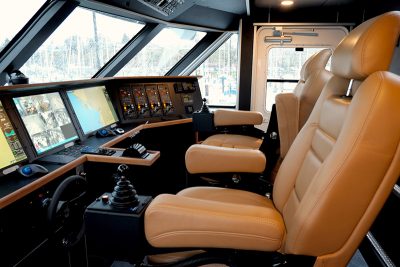
As a result of a federally funded research project, Kitsap Transit, underwent a study to not only implement a beach monitoring system for erosion, but also brought on All American Marine and Teknicraft to research a low wake wash vessel design.
With the community and mission in mind, a wake propagation model was developed to predict vessel wake parameters (i.e. height, period, direction, and phase) at the shoreline along the proposed ferry route. This model was used to evaluate the potential effects of alternative fast ferry operations on shoreline erosion and sediment transport.
The ultimate goal was to evaluate potential shoreline protection solutions for areas where the impact cannot be minimized. Using a Computational Fluid Dynamic (CFD) Modeling Automated Systems-Based Design, tank testing, and a vessel optimization study featuring 3 different hull shapes, 3 different hydrofoil profiles, and 9 new vessels, Teknicraft and All American Marine designed and built the Rich Passage. It is the lowest wake wash vessel in its class, setting a new standard in hull design. A huge win for our operators working in sensitive areas, and applicable to many vessel types and industries where erosion and environmental impact need to be considered. Read more about the study and how All American Marine with Teknicraft built the Rich Passage.
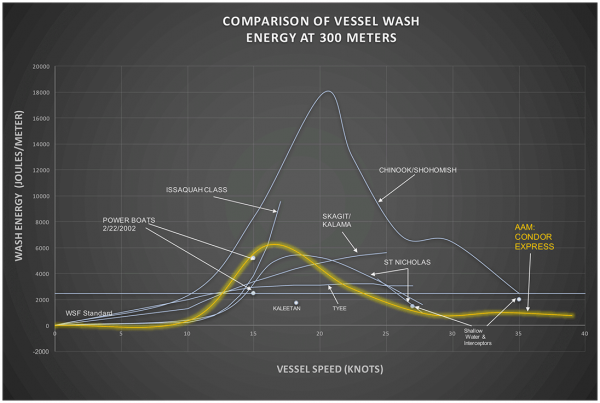
Fuel Efficient
“During sea trials, the difference in fuel consumption between light and fully laden at cruising speed was almost negligible, which means we’ve cracked the code in terms of [low] fuel consumption at high speeds.”
– Nic de Waal, Teknicraft Naval Architect
Whether it’s long excursion patrol or research vessels, to multi-trip passenger ferries and eco-tours, fuel costs are always a significant factor in purchasing a vessel. That’s why we work tirelessly in the design phase to customize each hull for its intended application, and as a result, our catamarans and monohulls often exceed fuel efficiency objectives across the board. Our vessels pay for themselves over time and we look forward to showing you how.
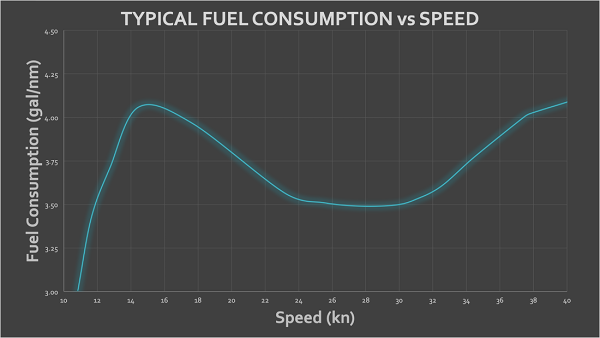
Hydrofoils can be incorporated into many of the All American Marine catamarans to aid in speed, performance, and efficiency where the specific application may require such enhancements. Our unique hydrofoil system consists of the main foil spanning the tunnel at the keel, forward of the center of gravity position and two cantilever-type stern foils. The lift produced by the hydrofoil reduces the hull resistance, while increasing speed and load-bearing capability.
The stern foils create a vertical lift at semi-planing speed, which reduces the trim angle when getting on step. This significantly reduces both the power requirement and the wake wash in the low-speed range. The main foil action reduces the power needed to maintain service speed; therefore, fuel consumption and running costs are reduced significantly, while also further enhancing the softness of the ride, especially in choppy seas. We have years of experience testing and building both aluminum and composite adjustable hydrofoils, depending on the application of each vessel and where appropriate.
Displaces 1/3 of the Vessel’s Weight
Uses 1/3 less horsepower on average
Burns 1/3 less Fuel on average
All American Marine has made a commitment to shaping the future of hybrid technology, and is charting a new course. Where many see a tough transition, we see a new opportunity to help our operators lead the charge and be a part of this revolution in shipbuilding. We work with each client to assess the long term social, environmental, and financial impact of their vessel and help them make the decision on how to utilize new technologies to meet or exceed their objectives.
Our experienced team of experts is available at each step of the design process to ensure all propulsion options are thoroughly explored. Only the best systems suited for each vessel’s specific route and application are incorporated into the project. This is why we partnered with BAE Systems to build the Enhydra for the Red and White Fleet in San Francisco, a lithium-ion powered monohull that will carry passengers to multiple points around San Francisco Bay.
What technology is really available? What’s coming in the near future? What can be expected in terms of fuel consumption and actual emissions levels? Will this system fit into my boat – large and heavy? Will my vessel still be able to make the speed and efficiency required of my specific mission? There are many questions and even more answers. All American Marine is here to help guide our operator’s through the noise to find a truly sustainable and valuable solution.
Construction
All of our vessels are built in a state-of-the-art 57,000 sq. ft. production facility adjacent to Bellingham Bay. The production shop contains 7 overhead bridge cranes, a brake press, shear, CNC router cutter, and a laser-leveled construction platform. We follow a stringent quality assurance program where each craftsman has committed to paying careful attention to detail and ensuring the highest levels of quality. Depending on the vessels application, we ensure stringent regulatory compliance including US Coast Guard vessel certifications. USCG visits weekly and does inspections and performance checks throughout the production process.
From production techniques to employee best practices, AAM is committed to building a dedicated workforce of well-trained craftsmen. Our cohesive team is our secret to adding value and building the best boats for our operators.
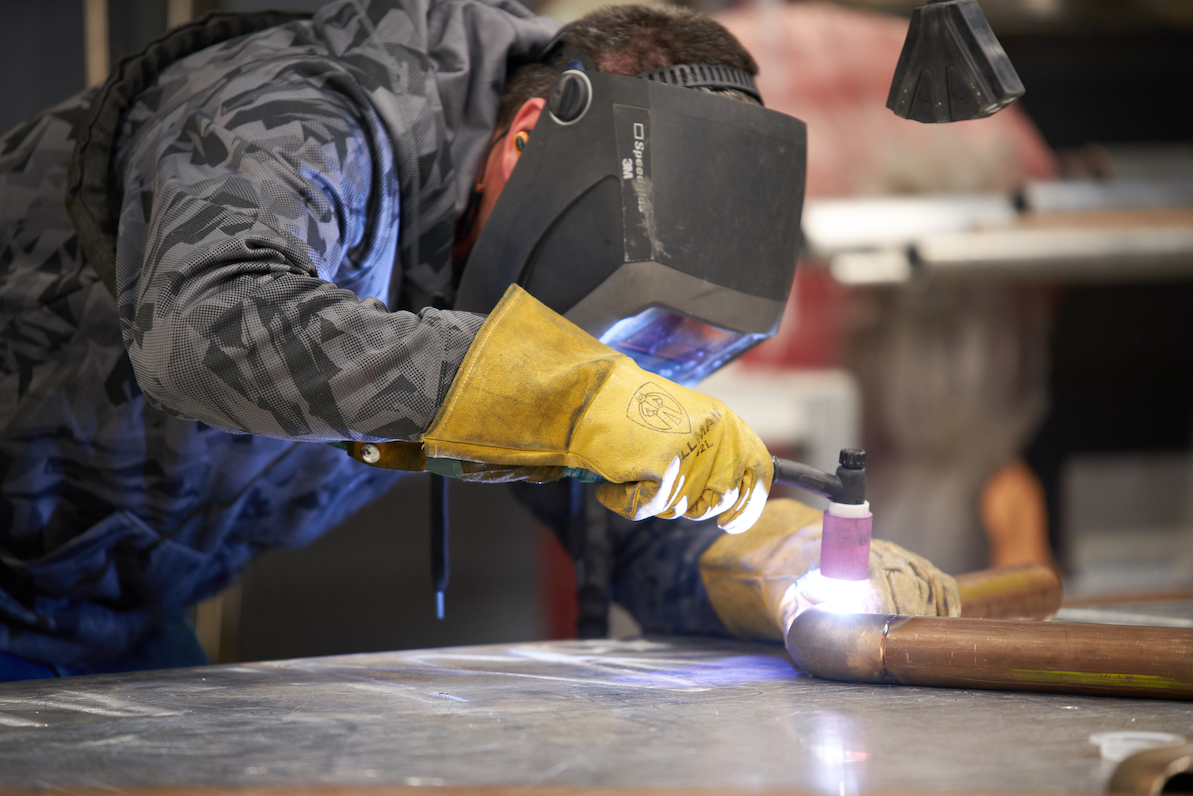
The Illustrated Guide To Boat Hull Types (11 Examples)
I didn't understand anything about boat hull types. So I've researched what hulls I need for different conditions. Here's a complete list of the most common hulls.
What are the different boat hull types? There are three boat hull categories: displacement hulls, which displace water when moving; planing hulls, which create lift at high speeds; and semi-displacement hulls, which displace water and generate lift at low speeds. The most common hull types are round-bottomed, flat-bottomed, multi, V-shaped, and pontoon hulls.
But that's all pretty abstract if you ask me, so below I'll give a simple overview of what it all means. After that, I'll give a list with pictures of all the different designs.
A Simple Overview of Boat Hull Types
Your boat hull will be the biggest factor in how your boat handles or sails, how wet it is, how bumpy - absolutely everything is determined by the hull shape. So it's important to understand what different hulls will do for you, and what each hull is best for. First, let's slice it up into rough categories.
Roughly, you can divide boat hulls into three categories:
- Displacement hulls - Lie inside the water and push it away when they move
- Planing hulls - Lie on top of the water and don't push it away
- Semi-displacement hulls - Lie inside the water and push it away, but can generate lift
Everything I'll be mentioning below is one of those three, or something in between.

There are five common boat hull types:
- Round-bottomed hulls - handle well in rough water: sailboats
- Flat-bottomed hulls - very stable for calm inland waters: fishing boats
- Multihulls - very stable and buoyant: catamarans
- V-Shaped Hulls - fast and comfortable in chop: powerboats
- Pontoon hulls - fast and stable: pontoon boats
And then there's everything in-between.
Here's a quick and handy overview of the different hull types
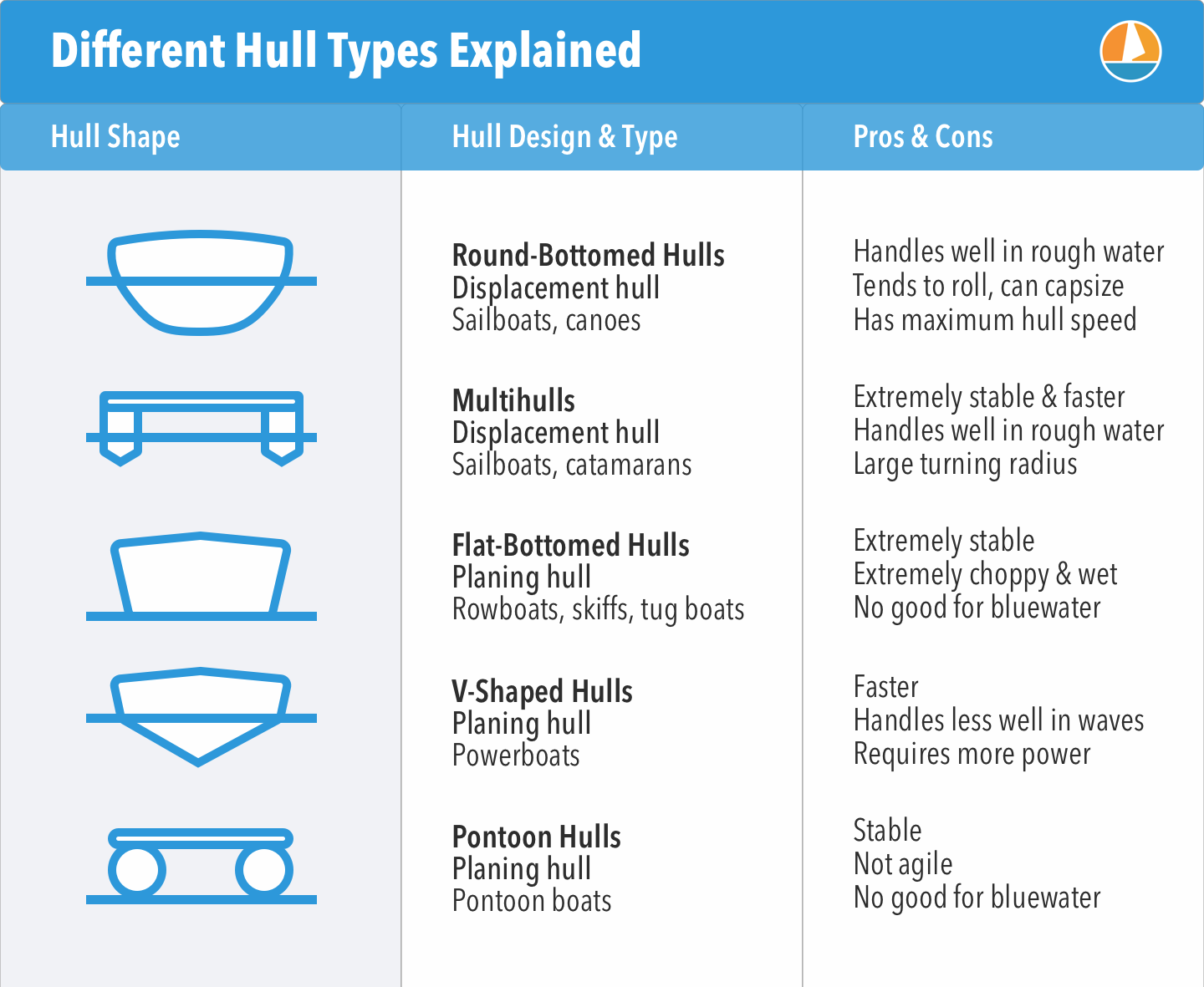
In each category, we find different designs and styles that have different characteristics. There isn't a real clear distinction between categories and styles: there are semi-displacement hulls and so on. So I thought the best way to learn you the different hull types is by simply creating a list with lots of pictures, instead of getting all theoretical about it.
So below I've listed all the different hull styles I could possibly think of, mention what category and type it is, the pros and cons of each one, and give you examples and illustrations for each one.

On this page:
Displacement hulls, round-bottom hull, catamaran hull, trimaran hull, planing hulls, flat-bottom hull, deep v-hull, modified-v hull, stepped hull, pontoon hull, semi-displacement hulls.
Examples: Sailboats, trawlers, fishing boats
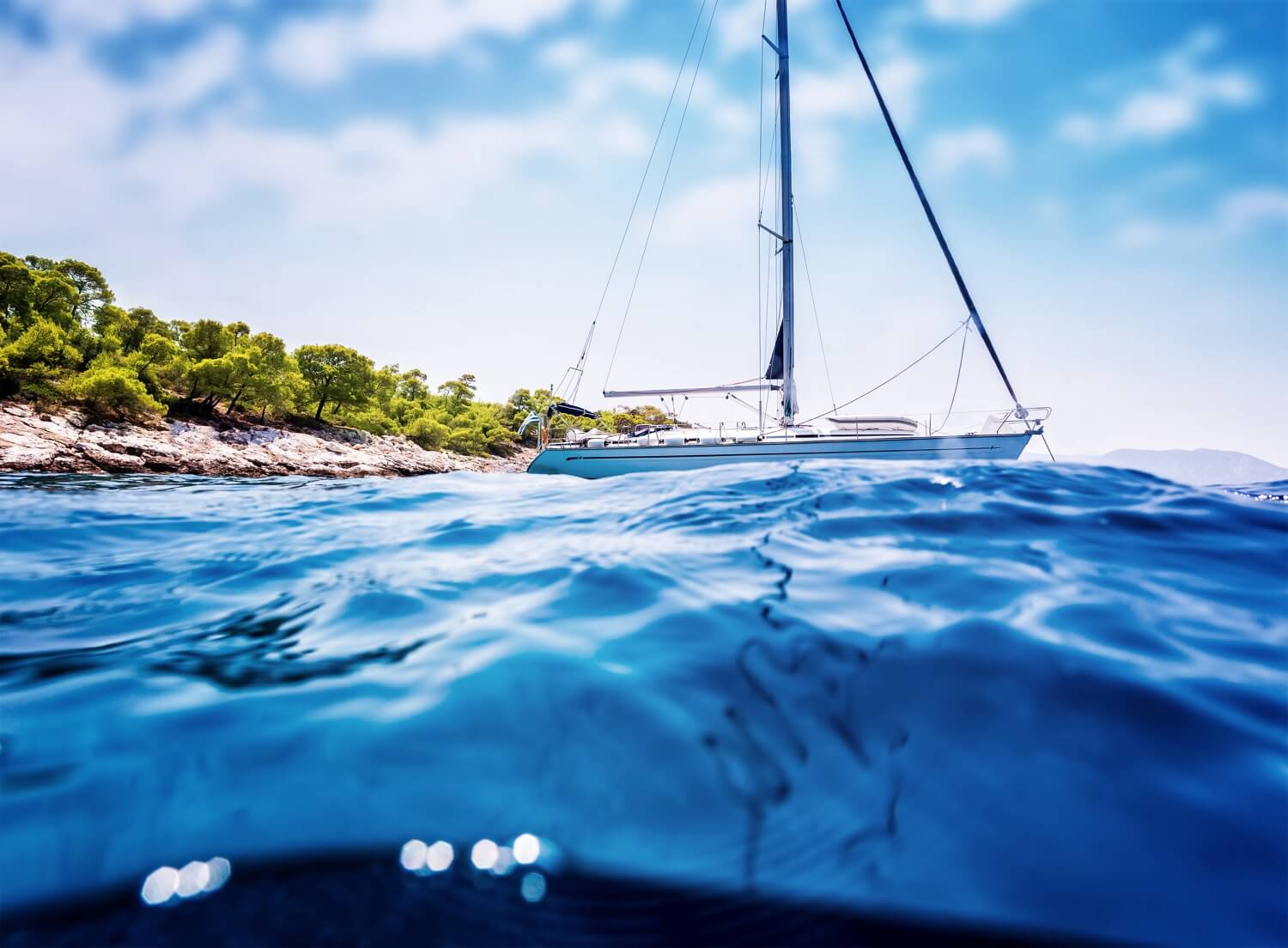
Displacement hulls displace water when moving. These hulls lie in the water, instead of on top of it. The amount of water they displace is equal to the boat's weight. Displacement hulls handle way better in rough waters than flat-bottom hulls. That's why most cruisers have some sort of displacement hulls. There are actually all kinds, shapes, and forms of the displacement hull design, which we'll go over later.
The most important thing to understand about the displacement hull, is that it operates on buoyancy. This means that most of the boat's weight is supported by its capacity to float . Planing hulls, on the other hand, operate on lift instead, but we'll dive into that later.
Sailboats typically have displacement hulls, but also fishing boats, trawlers and crabbers. All in all, it's used for each boat that needs to handle well in rough conditions.
Learn everything there is to know about displacement hulls in this article . It lists all the pros and cons and really goes into detail on the nitty-gritty about how displacement hulls actually work .
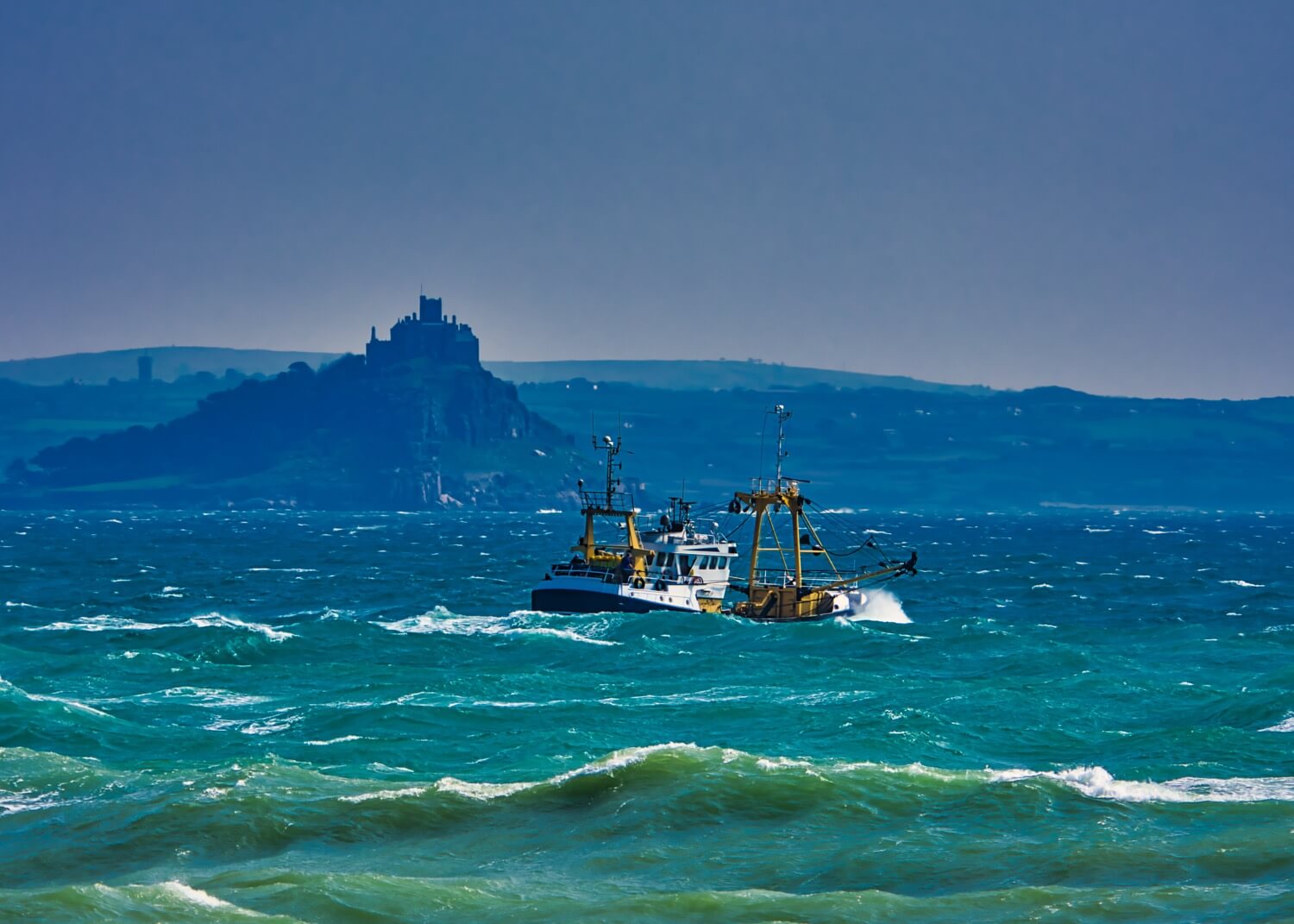
But they are also slower than flat and planing hulls because the boat creates more resistance when moving. It has to push the water aside. In fact, this type of hull has a built-in upper-speed limit.
This upper-speed limit is called maximum hull speed . It means that the length of a displacement hull directly determines the maximum speed. It can't go faster, because the water-resistance increases with the boat's speed. To learn everything about calculating maximum hull speed , please check out my previous article here.
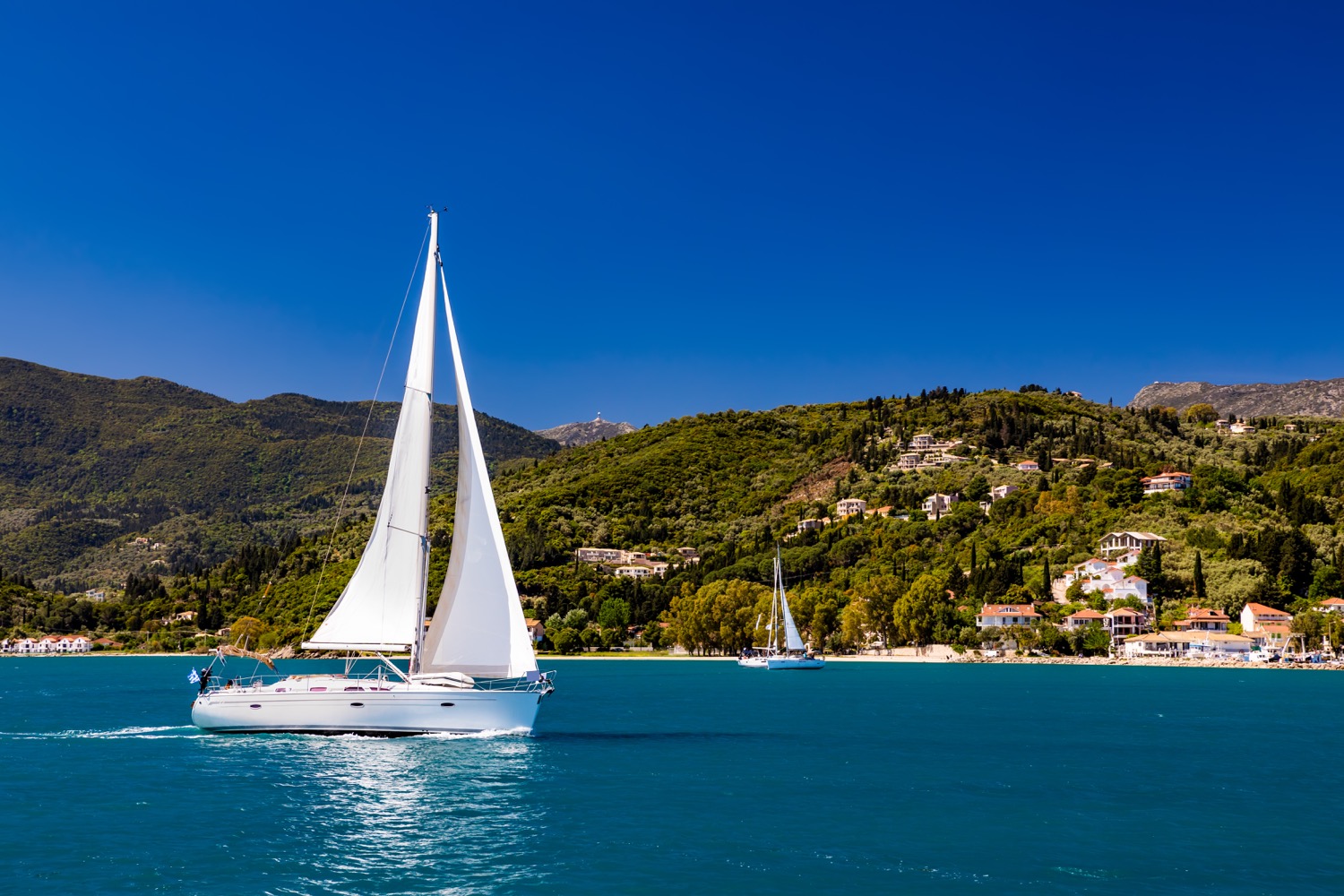
A round-bottomed hull is a type of displacement hull - it lies in the water and has to power through it. But since it's rounded, it creates little resistance and is effortless to move through the water. It's a very smooth ride and typical for any sailboat that sort of glides through the waves. In contrast, powerboats really have to eat their way through the water.
Examples: Canoes, sailboats
They are also one of the least stable. Since the bottom is rounded, your boat or canoe will rock plenty when boarding or moving around. They are also easy to capsize. That's why pro canoers learn to do a 360 in their canoes. I've never did a roll myself but came close enough a couple of times.
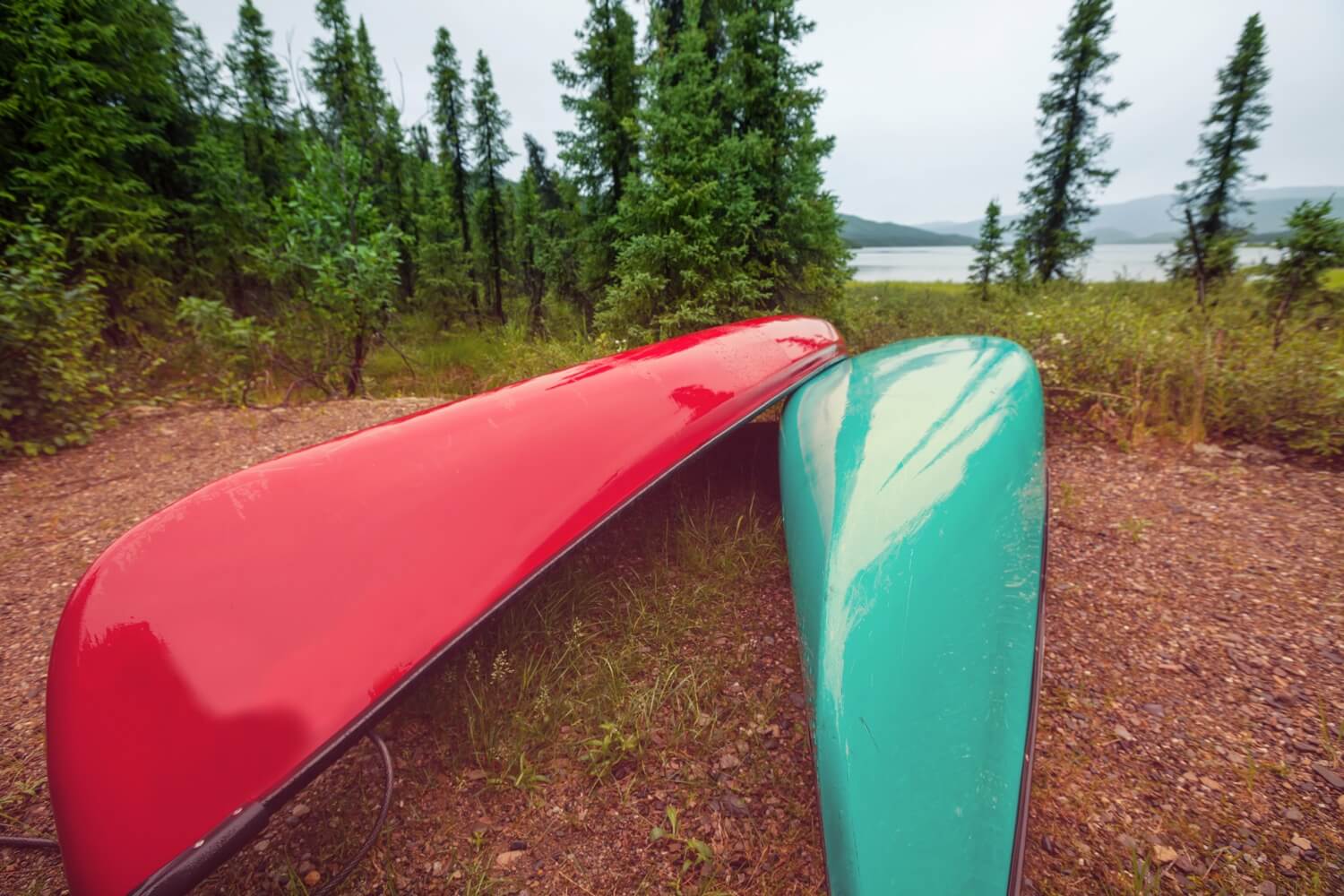
Almost all sailboats use a round bilge as well. This provides it its buoyancy and makes sure it handles well in waves. But since a rounded bilge is easy to capsize, a lot of sailboats have some sort of keel, which stabilizes the roll.
Nearly all ocean-going vessels use some sort of displacement hull, and the round bottom is the most common one. But our next guest is very popular as well.
The catamaran is similar to the pontoon hull (read on to learn more on that one), but it is a displacement multihull instead of a planing one. So it has two hulls, that lie inside the water and displace it. Like the pontoon, you will have to try really hard to capsize this design (and it won't work).
Examples: well, catamaran sailboats. But also this cool catamaran trawler:
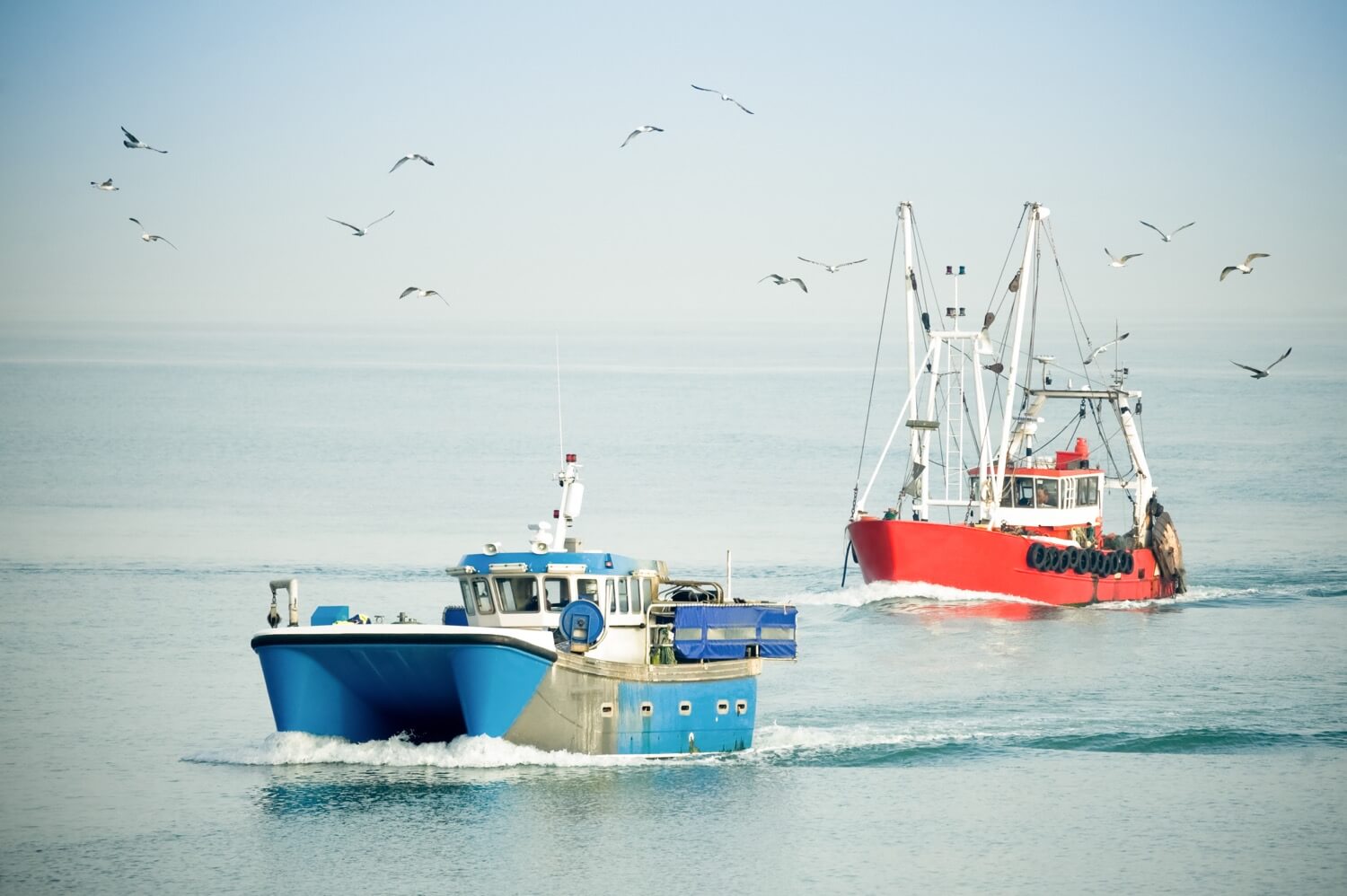
Catamarans are extremely popular ocean cruisers. Their biggest pro is their extreme stability and buoyancy. And they have a very shallow draft for a displacement hull, making them very popular for sailing reefs and shallow waters, like the Caribbean.
Some cons for the catamaran are less agile than monohulls. They have a large turning radius, making them less maneuverable. Also, expect to pay high marina fees with this one.
Speaking of marina fees, our next one can go either way.
I think trimarans are incredibly cool, and especially the second type.
There are two types of trimarans:
- a catamaran with three hulls instead of two,
- or a displacement monohull with two floaters.
The first has the same characteristics as the catamaran: it's a displacement multihull, but now with three hulls:

The second can be a regular displacement monohull, with two pontoon-type floaters that provide extra buoyancy, making the total thing a hybrid between pontoon and displacement:
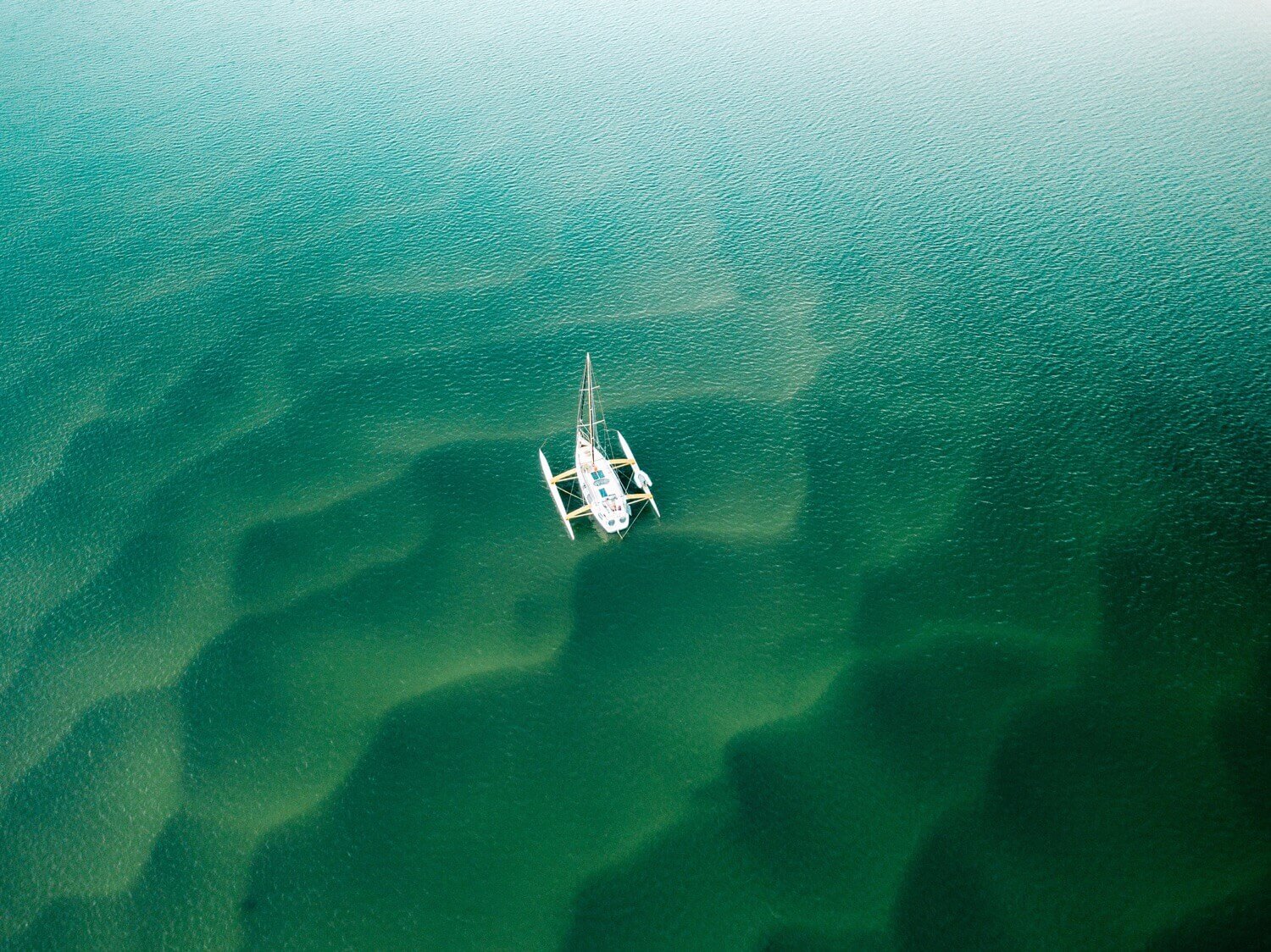
This last one has all the pros of a catamaran in terms of stability, but: you can simply wheel in those floaters whenever you head for port. That saves you a lot of money. And you can trailer her! Imagine that, a towing a trimaran home.
So those were the most common displacement hulls, aka what lives in the water. Let's move on to the planing hulls, aka what lives on the water.
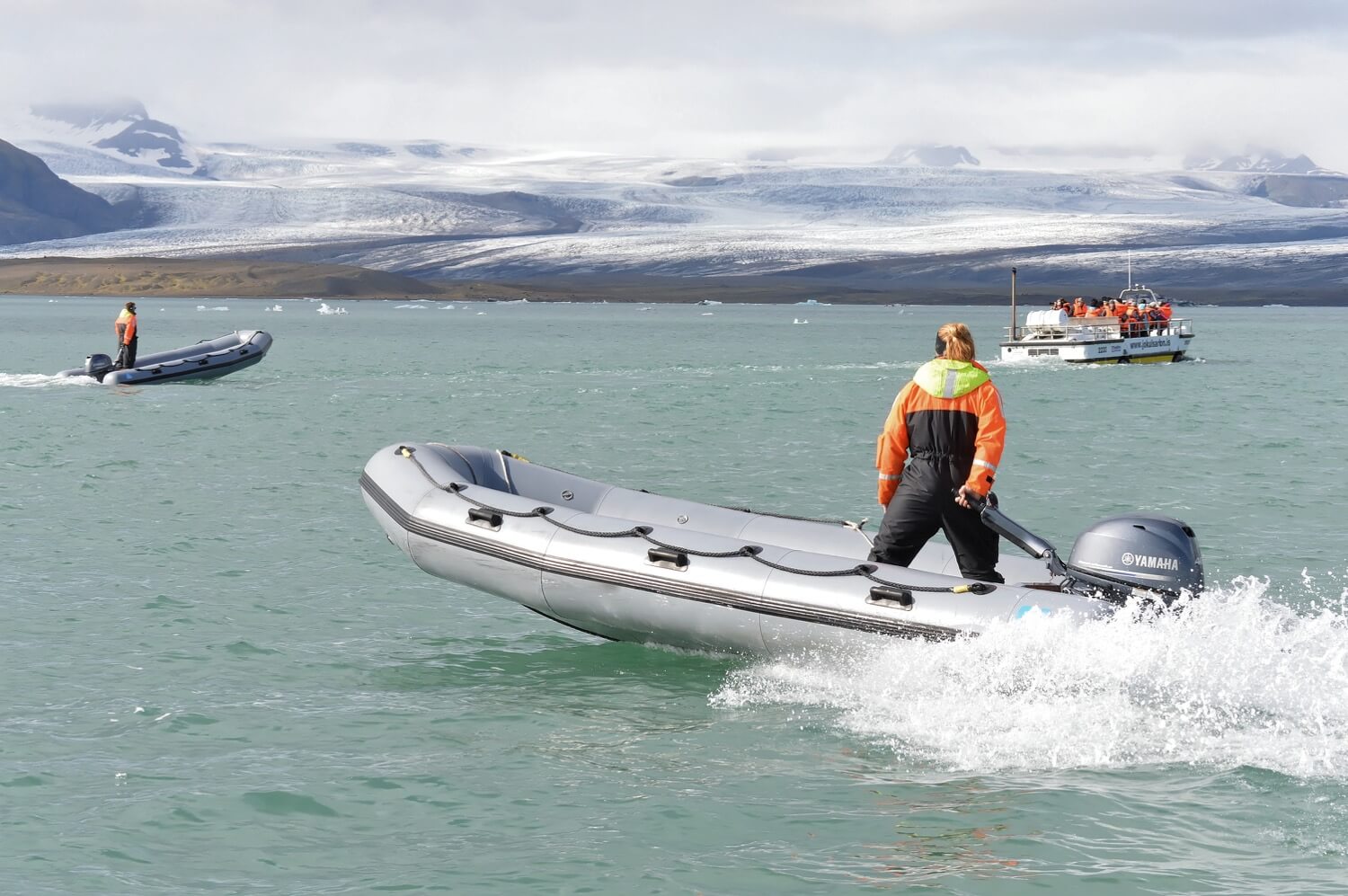
Planing hulls are a hybrid between the flat-bottom and displacement hulls. Planing hulls displace water at low speeds , but create lift at higher speeds . The shape of their hull + speed lifts them out of the water, making them glide on top of the water. Most powerboats look like flat-bottom boats but use a shallow V-shape that helps the boat to handle better at higher speeds.
Examples: Water sports boat, powerboats
The most important thing to understand about planing hulls is that they operate mainly on lift instead of buoyancy. This means the weight of the boat is mainly supported by dynamic forces 1 . With the right amount of power, this design generates lift, which results in less resistance. This is why they are a lot faster than boats with displacement hulls, but also a lot rougher, even with mild chop.
A lot of powerboats use some sort of planing hull. Again, there are many designs and variations on the planing hull, and I'll try to mention as many as I can below.
Because the wedge of the hull runs into the water, it is much easier to handle at high speeds. At lower speeds, it is able to keep its course, even with a bit of wind. However, whenever the boat starts planing, it is prone to wind gusts, since the wedge shape no longer stabilizes the boat.
The flatter the hull, the faster it will go, but also the more poorly it will handle. Other powerboats use deep V-hulls, which I'll discuss below. But first, let's take a look at the flattest hulls you'll ever see.
A flat-bottom hull lies on top of the water and doesn't displace water (okay, very little) as it moves. Since there is no displacement, there is also little to no friction when moving. This makes it potentially fast, but it handles pretty poorly. It is one of the most stable hull design.
Examples: rowboats, (old) high-performance powerboats, small skiffs, small fishing boats, tug boats
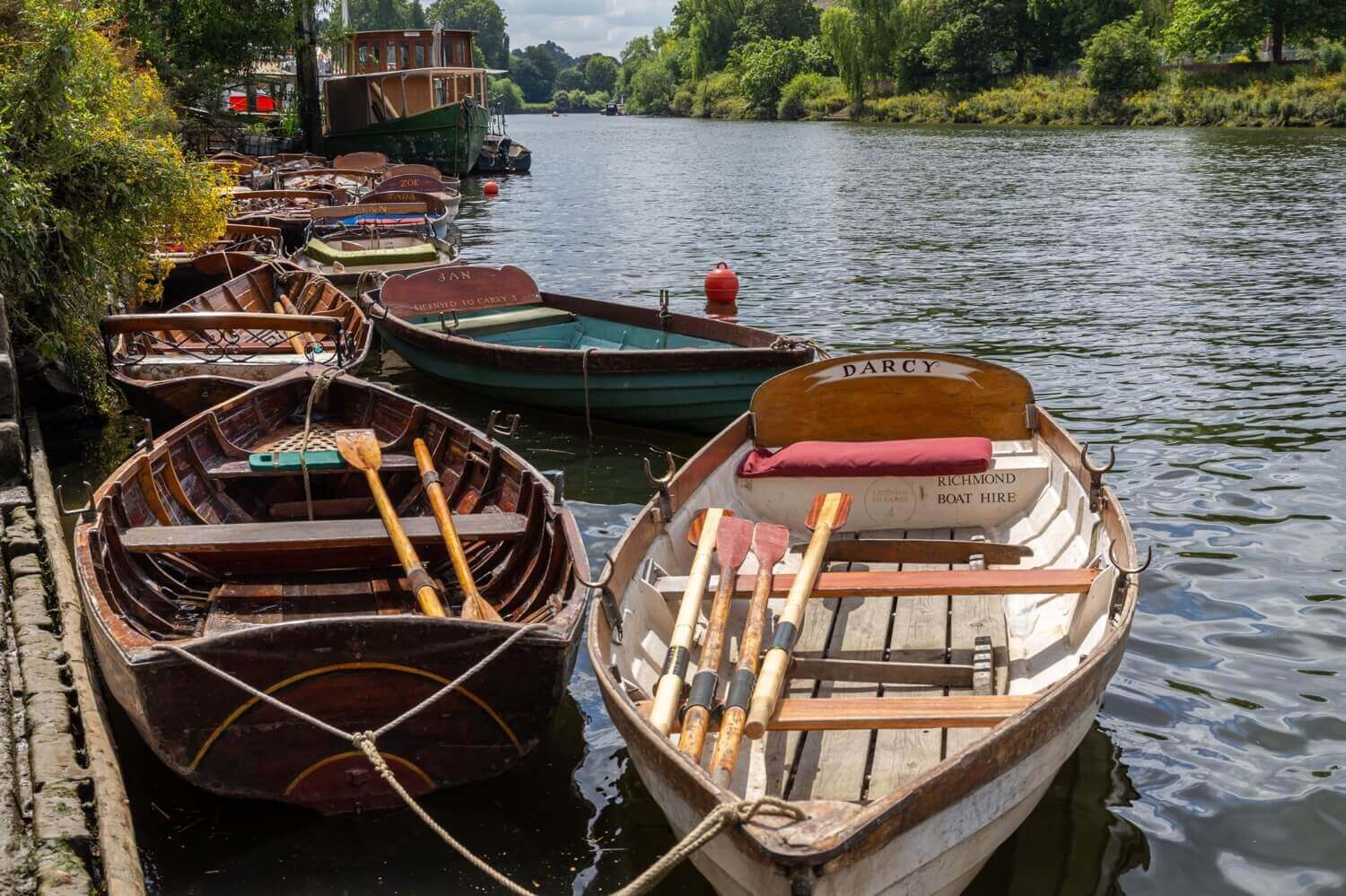
They aren't just incredibly stable, they're also very practical. Because the bottom is practically flat, they maximize boat surface. But they are also extremely choppy in rough weather and waves. They will handle very poorly with stiff winds, as the wind can simply catch them and blow them across the water surface. That's why this design is almost exclusively used for calm, small, inland waters.
This type of hull operates mainly on buoyancy , like the displacement hull, but it doesn't require the same amount of power to propel, which is why it's faster.
Because of the uncomfortable ride, not a lot of boats use a perfectly flat bottom. Most boats nowadays use some sort of v-hull or hybrid design, like a semi-displacement hull; especially larger boats. So not a lot of boats have a real flat bottom. However, we do call a lot of boats flat-bottomed. How come?
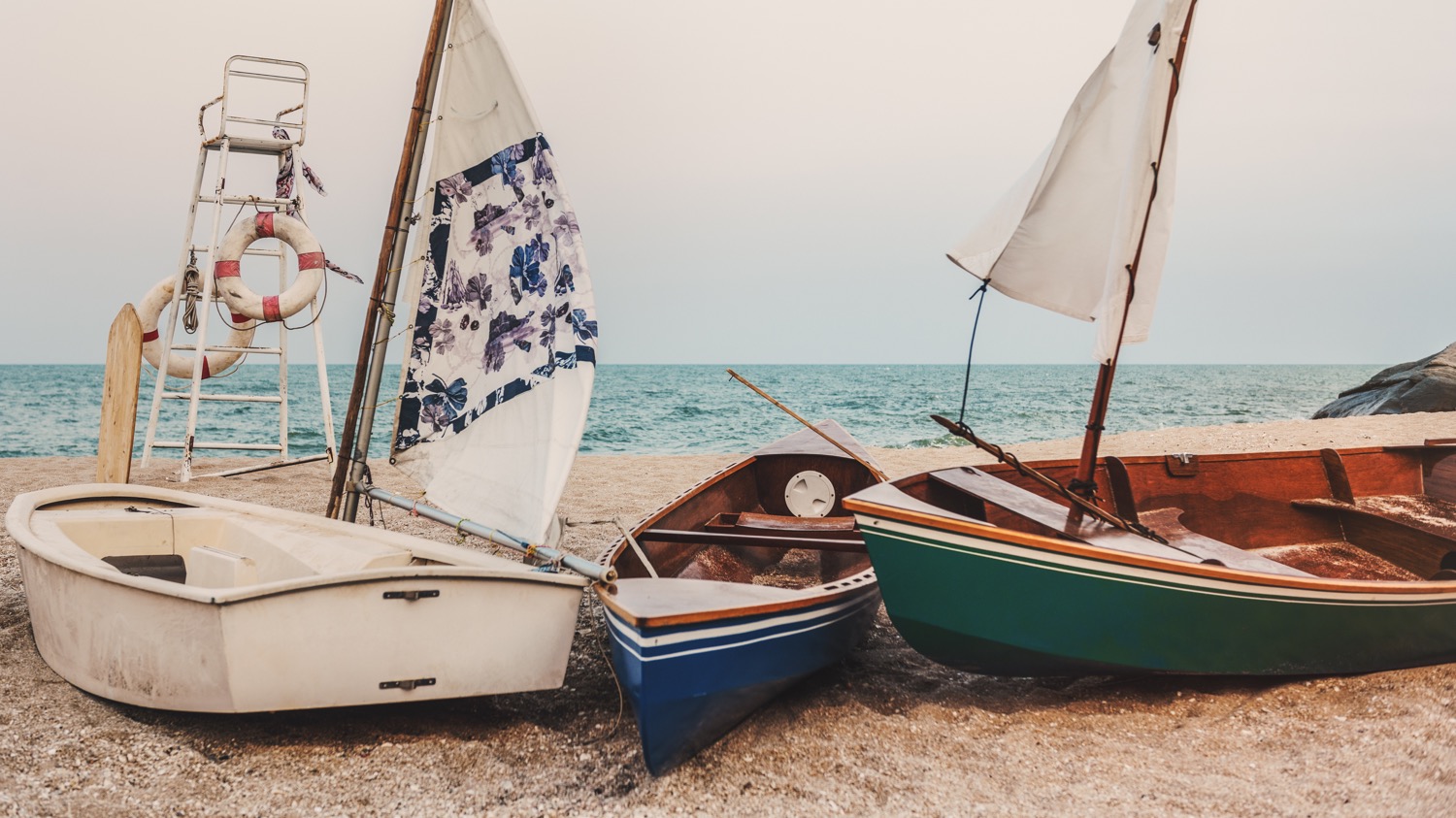
There are two types of hulls we call flat-bottoms:
- Of course boats with an actual flat bottom
- Boats with almost no deadrise
What is the hull's deadrise? The deadrise is the angle of the front of the hull to the horizontal waterline.
As you can see, the green sailing dinghy in the picture above has a deadrise that's barely noticeable.
Let's move on to other variations of the planing hull. One of the most popular hull design for modern-day powerboats is the Deep Vee hull. And that's as cool as it sounds.
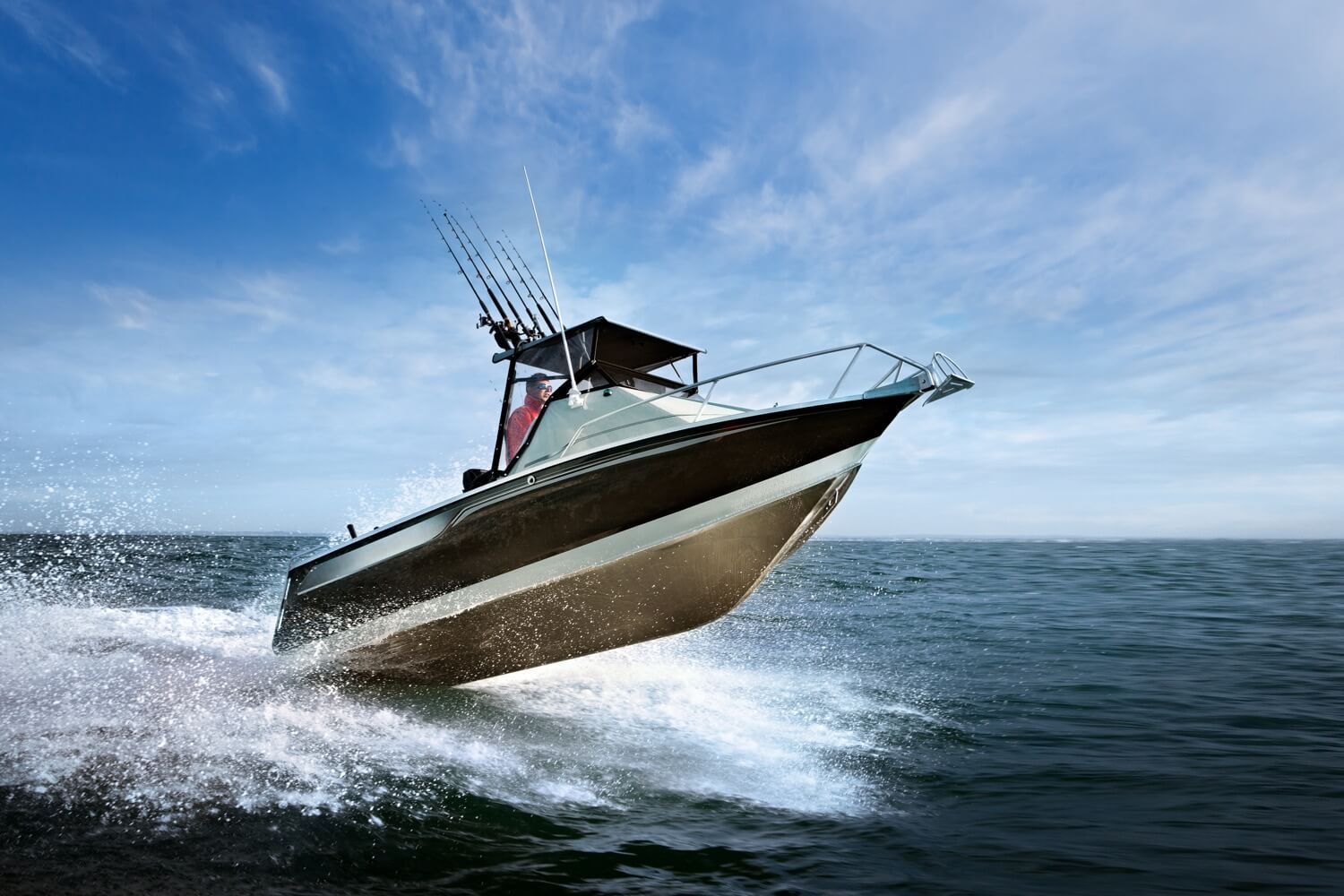
This is a type of planing hull that combines the best of both worlds.
These types of hulls are very popular on modern-day powerboats, and no wonder. With a V-shape that runs from bow to stern, deep into the water, you can handle this boat even in offshore conditions. It handles a lot better than flat-bottomed hulls, while it's at the same time extremely fast.
Examples: Most modern powerboats.
The Deep V-shape acts as a tiny keel of sorts, stabilizing the boat and making it more reliable and maneuverable. The rest of the hull acts as a planing hull, giving the boat its fast edge. Even at high speeds, the Deep V will cut into the water, making it more handleable.
The deep-V design is just one of many variants on the V-hull. Below we'll talk over another, the modified V hull.
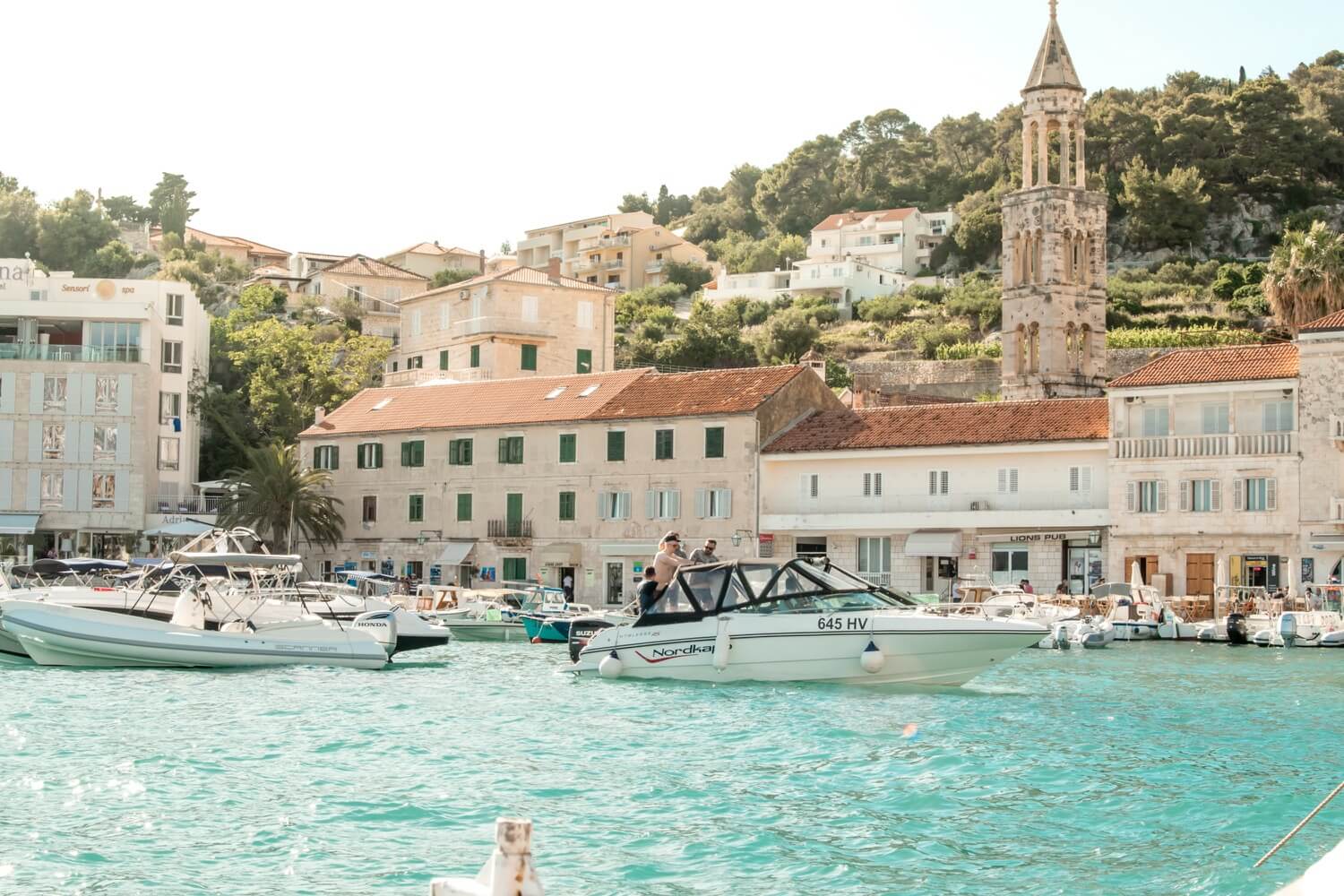
The modified V hull is the ultimate crossover of all planing hull types. It's a mix of the flat-bottom and Deep V hull. It is one of the most popular hull designs for small motorboats. It's flat in the back and then runs into a narrow V-shape to the front. The flat back makes it more stable, and adds a little speed, while the V-shape front ensures good handling.
It is, in short, kind of the compromise-family-sedan of boat hulls. It's the fastest design that's also stable, that's also safe, and that also handles well. But it's not the best in any of those things.
Most powerboats you've seen will have some sort of Vee or Modified-V hull.
Stepped hulls are used on high-performance powerboats. It's a type of planing hull that reduces the hull surface by adding steps, or indents in the hull below the waterline. It looks something like this:
It is said to work extremely well at high speed (60 knots and up) and adds up to 10 knots to your top speed.
On to our next design. There are also planing multihulls, and they might even look like catamarans to you. Meet the pontoon hull.
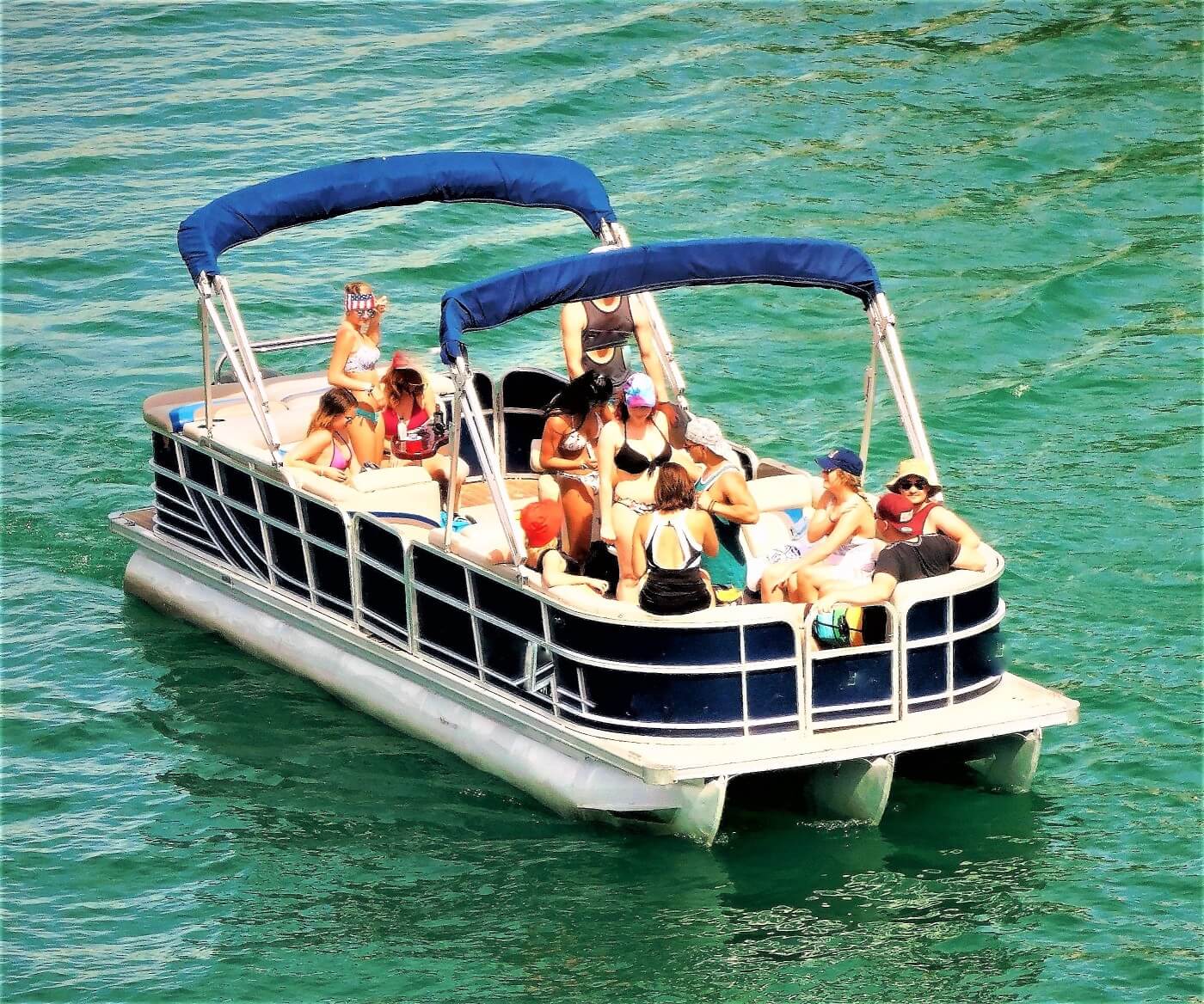
Pontoon hulls float on top of the water using pontoons or floaters that create lift. It's a type of planing multihull that doesn't lie in the water, so it doesn't displace a lot of water. They don't really handle well. As with any multihull, they aren't agile - they're not great at maneuvering. They also have a very large turning radius. But they are extremely stable: there's no chance you'll capsize this.
Examples: Cruisers, modern trawlers, motor yachts, Maine lobster boats
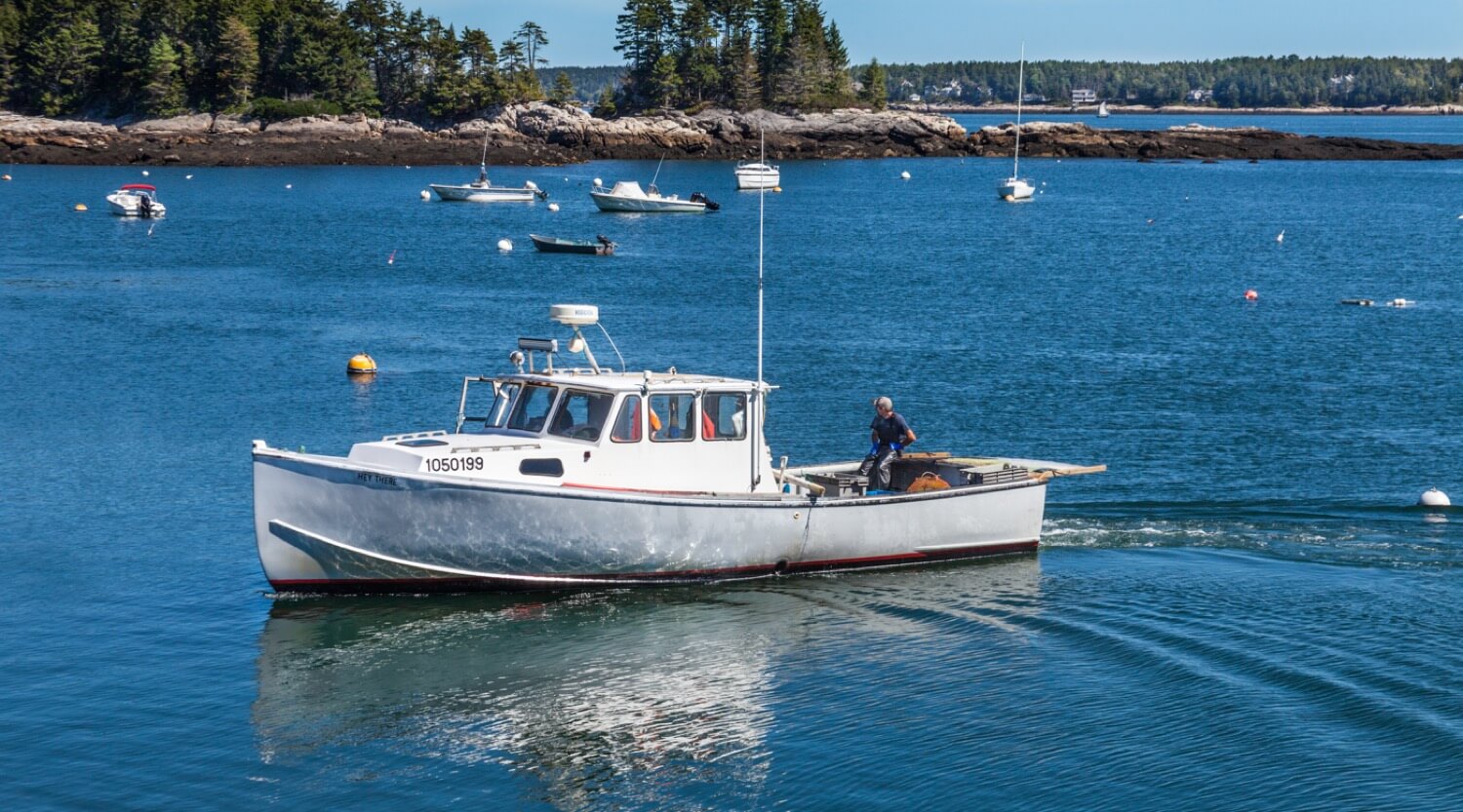
Semi-displacement hulls are smack bang in the center of planning and displacement hulls. They are a bit better for speed than displacement hulls are. They are a bit better for handling rough waters than planing hulls are. This makes them very versatile.
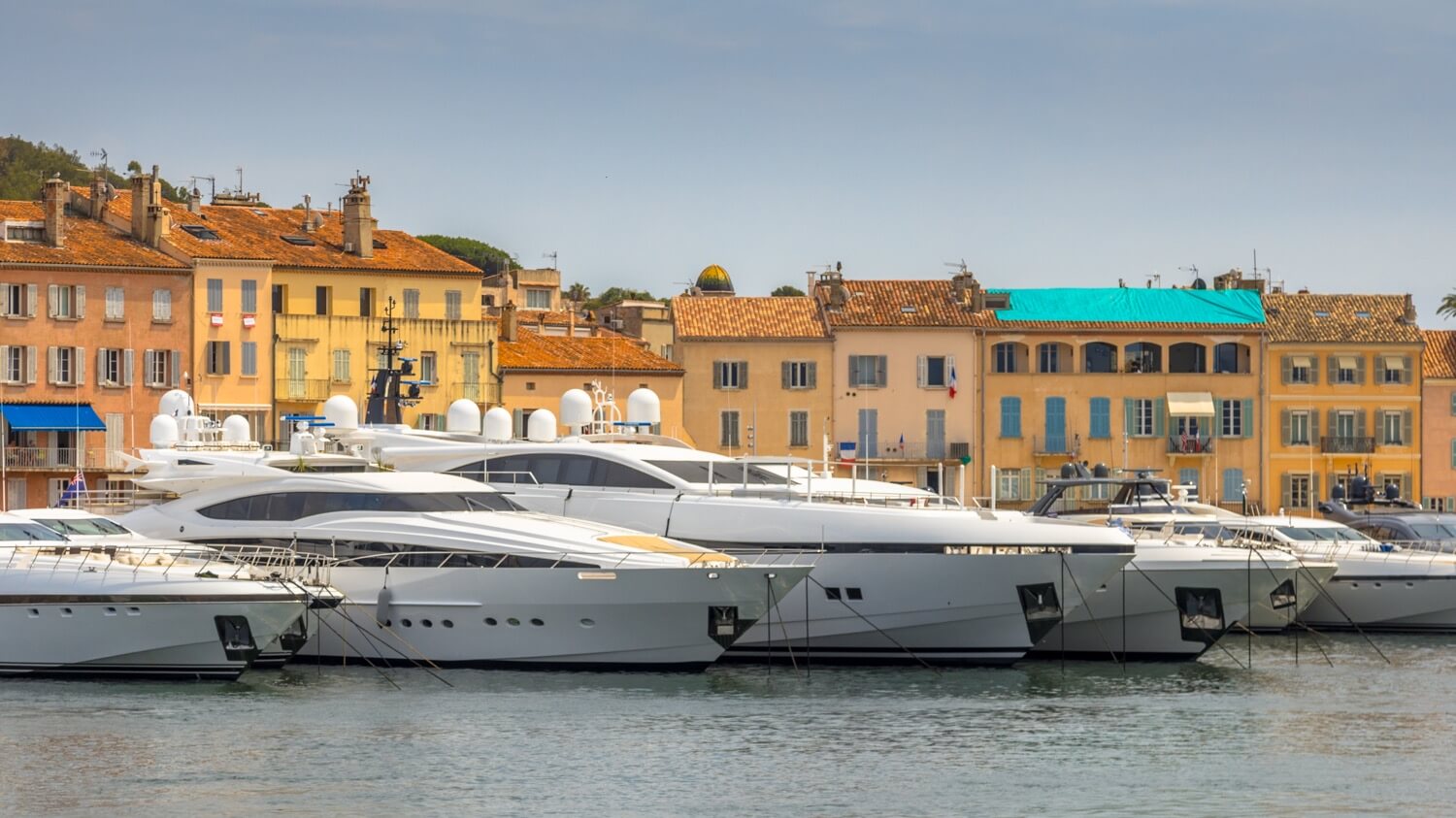
You can see these a bit like being 'half-planing' hulls. These hulls are designed to plane at lower speeds than normal planing hulls - somewhere in the range of 15 - 20 knots, depending on the length of the boat. It also requires less power. When the hull lifts, it reduces drag (water resistance), making it faster and more efficient.
Semi-displacement hulls are perfect for boats that need to be steady and seaworthy but fast at the same time.
For more information about semi-displacement hulls, please check out my in-depth guide to semi-displacement hulls here . It has a diagram and lists all the pros and cons.
So those were my 11 examples, and my step by step explanation of the different types of boat hulls and functions. You now have a solid basic understanding of boat hulls, and can recognize the most common ones. I hope it was helpful, and if you want more good sailing information, be sure to check out my other articles below.
https://www.soundingsonline.com/boats/how-different-hull-types-react-in-rough-water . ↩
I was wondering what your opinion would be on the ship uss Texas as far as hull type and bow type. I think it has a plumb bow and it looks to have a displacement or flat bottom hull. Im doing some research and a better trained eye would be of great help. I used images “bb-35 dry dock” to help see the hull shape. Thank you
Shawn Buckles
Hi Kirk, I don’t know about trained but here we go. I’ve checked the picture, it’s definitely a displacement hull I’d also say it’s a plumb bow.
Hahahahaa imagine liking boats hehehehehe Extremely stable & faster Handles well in rough water Extremely stable & faster Handles well in rough water Extremely stable & faster Handles well in rough water Extremely stable & faster Handles well in rough water Extremely stable & faster Handles well in rough water Extremely stable & faster Handles well in rough water Extremely stable & faster Handles well in rough water Extremely stable & faster Handles well in rough water Extremely stable & faster Handles well in rough water
Leave a comment
You may also like, a complete guide to displacement hulls (illustrated).
The displacement hull is the classic go-to hull design for sailboats and one of the most recognizable ones out there. In this guide, I explain all there is to know …
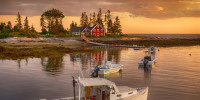
Semi-Displacement Hulls Explained (Illustrated Guide)

The Ultimate Guide to Sail Types and Rigs (with Pictures)
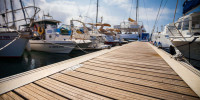
How Much Does it Cost to Dock a Boat for a Year?
Own your first boat within a year on any budget.
A sailboat doesn't have to be expensive if you know what you're doing. If you want to learn how to make your sailing dream reality within a year, leave your email and I'll send you free updates . I don't like spam - I will only send helpful content.
Ready to Own Your First Boat?
Just tell us the best email address to send your tips to:

James Wharram Designs
Search Our Site
- Self Build Boats
- Professionally Built Boats
- Choosing a Boat
- How We Design
- Photo Gallery
- Video Gallery
- Articles & Blogs
- Wharram World
Catamaran Stability
Foreword (james wharram, 2004).
It is 50 years since I designed my (and Britain's) first offshore Sailing Catamaran. The accepted opinion at the time, expressed in Yacht Magazines, was that the offshore catamaran would break up in high sea waves, that their motion on the high seas would be so violent as to render the crew helpless and that the double canoe/catamaran could not sail to windward.
Well, the voyage of Eric de Bisschop of France who sailed his 38ft. KAIMILOA half way around the world in 1937/39 and his two by him inspired 'Sailing Sons', Rudy Choy of Hawaii in the Pacific and James Wharram in the Atlantic proved these 'theorists' wrong.
What is interesting on looking back is that no critic at the time mentioned 'capsizing' as a possible fate of the historic offshore double canoe/catamaran. The reason is that early in the 1950s, the wartime experience of hundreds of men who had survived, sometimes for weeks, in small open boats, in rubber life rafts, cork Carley rafts or even floating wooden hatch covers, encountering severe storms with big waves without capsizing, was in seafaring circles common knowledge.
That you could capsize at sea on a form stable sailing ship (which is what a catamaran is) through having too high a mast and too much sail area was at the time also common knowledge amongst seamen, as it affected all commercial sailing ship design. There were many people around in the 1950s who still had knowledge and practical experience of such ships. Their knowledge certainly influenced the mast heights and sail areas of my first seagoing catamaran designs, as did the writings on Form Stable ships by Howard Chapelle, the great American naval architect.
In the late 1950s, the Prout Brothers were developing a 16ft. racing day boat catamaran. It was fast and outsailed all monohull racing, dinghies of the time. Like racing sailing dinghies, without skilled handling, they capsized frequently. Still, with the attendance of the patrolling Race Guard Boats no one died.
Offshore catamarans began to first develop in the 1960s. From the beginning, there were some designers, like myself, who saw them as Form Stable boats following traditional Form Stable Stability values i.e. boats which 'looked after their crew'.
There were also designers (not many), drunk on the speeds of day racing catamarans, who used the sail areas, mast heights and stability values of the day racing catamarans on Offshore Cruising Catamarans, i.e. at all times the Crew looked after the stability of the boat.
Unfortunately, designers of these low stability catamarans have nearly always tended to imply in yacht magazines, to the public, that they are more skilled designers "Because their boats sail faster"?
Equally unfortunate was that by 1976 many of these low stability catamarans were publicly capsizing, when their trained crew got tired or, particularly, when sold to unsuspecting monohull sailors. Suggestions in England and America were made to 'ban offshore multihulls'. Hanneke Boon and I wrote our first article on cruising catamaran stability ("The Stable Multihull") in 1977, and things settled down again.
However, around the late 1980s another group of young designers from racing background or using racing catamaran concepts moved into Cruising Catamaran design and, once again, capsizes with deaths occurred. So, again we wrote in another article on our observations on safe stability for Cruising Catamarans.
This article was first published in 'Practical Boat Owner' (UK) in August 1991 and since then in several other countries. The I.S.O. has recently also published formulas for calculating catamaran stability as part of the Recreational Craft Directive. On examination, their formula is the same as the one published by us in 1991 with a slightly smaller safety margin for Dynamic Stability (70% to our 60%). So far, the I.S.O. has not yet given recommendations as to what is a 'safe' stability for offshore sailing.
Introduction
In November 1989, the British Multihull Club, M.O.C.R.A., had an International Symposium on multihull design to celebrate its 20th anniversary.
During the lunch break, one very pregnant lady asked me: "Why don't they discuss capsizing? That is what I want to know about. I do not like heeling monohulls, but I do not fancy swimming with my baby out of an upside down catamaran."
Unfortunately, what I had to tell the pregnant lady is that they never seriously discuss capsizes at Multihull Symposia except in a self-congratulatory way, saying that an "upside-down catamaran floats as against a monohull that sinks". Ignored are hypothermia, broken limbs, lost crewmembers and mothers frantically trying to find their children to say nothing of at least half the value of the boat, i.e. the interior destroyed by the inrushing water.
It is a very emotive subject between designers and their followers because it touches not just on sales and profits, but also on masculine subjective attitudes like high tech., low tech., modern, traditional, taking risks, being cautious...etc. Symposium organizers realize that free discussion would lead to uproar. For the monohull sailor wishing to buy a cruising catamaran to suit his/her family's needs, Multihull Symposia and Multihull Magazines so far have given no real information.
Fortunately, the formulas that most catamaran designers use nowadays to calculate stability are not all that difficult to understand, and with them a prospective owner with a little background knowledge on sailing ships in general, can make his/her own decision as to whether the cruising catamaran they desire has the stability to be safe for their intended usage.
If you have forgotten most of your mathematics since you left school and, like most of us, hate to admit it, do not be frightened of the word formula. Calculators now do most of the work, and everyone knows or has some bright adolescent only too eager to use and demonstrate his/her latest calculator acquisition. However, the calculator only produces figures. To relate these to our needs, we do need to know some sailing ship history.
Polynesian Origins
The historic catamaran is the workboat of the Polynesian Pacific. Archaeological excavations, legend and early Western observers have shown that they had been in use hundreds of years - perhaps thousands - for fishing, coastal trade and ocean exploration, a background usage similar to that of the Chinese junk types and our own traditional Western sailing boats (before the development of the modern ballast keel yachts). Catamarans have exactly the same stability behavior as Junks and the traditional Western Sailboat.
Joshua Slocum's SPRAY is a typical example of a workboat of the late 18th and early 19th century. (See Fig.1)
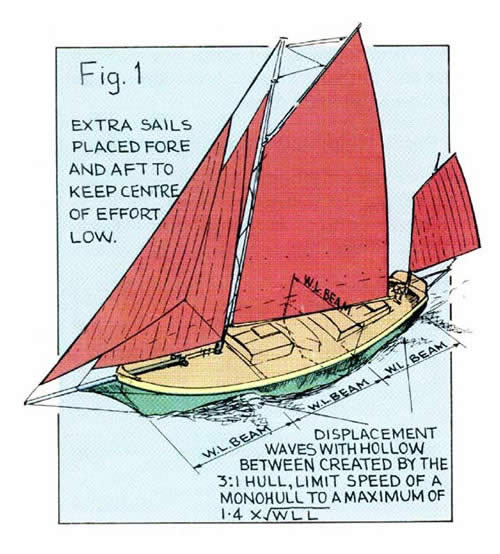
What kept the SPRAY and traditional sailing ships from capsizing under the pressure of the wind on the beam were the wide hull beam, flattish bottom shape (i.e. "form stability"), and a selection of heavy rocks (i.e. "ballast stability"). In addition, the masts were kept short to lower the heeling moment of the sails.
Extra sail area for light winds was achieved by spreading the base of the sails out by means of bowsprits and bumpkins rather than raising the sails higher on a longer mast, creating a greater heeling/capsizing force.
According to Chapelle, in his book "The Search for Speed under Sail", if traditional sailing ships heeled much more than 55º, then they were in trouble. The loose rock ballast, about 10% of the total displacement, could break loose. A complete capsize would then occur and the boat would remain upside down. Capsizing, until the advent of the modern ballast keel yacht, was the theoretical possibility of ALL seagoing sailing vessels. Designers/ Boatbuilders have been able to design boats stable enough to stay well away from the possibility of capsizing for at least 3000 years. (ULU BURUN SHIP -Nat. Geographic Magazine, Dec. 87)
Racing developed the modern ballast keel yacht. To sail closer to the wind the rigs got higher. To balance that, the ballast changed from rocks to heavy iron (this became cheaper with industrialization), and finally, to be able to use even higher masts, the ballast changed to the heavier lead and moved from inside the hull to the outside in a deeper keel. As a side result, and not intended by design, the modern self-righting yacht was born.
Those who observed this development towards self-righting yachts did not regard it as a total blessing. They commented on how these "new" yachts plunged and rolled, which made sailing very uncomfortable and caused seasickness.
Even so the modern ballast keel yacht is still a relatively broad-beamed vessel, i.e. with a waterline length about 3 times longer than its beam - in technical terms, a length/beam ratio of 3:1.
Beamy hulls of 3:1 have to push a lot of water around them when sailing. This produces the well-known drag waves. (See Fig.1) and limits the maximum possible speed to approx. 1.4 x √WLL (in feet). Thus with a waterline length of 25 feet, your average speed will be about 5 - 6 knots.
The catamaran's unique speed potential, greater than that of the equivalent size monohull has arisen because it developed out of two ancestral boat types of the Pacific. Around the Pacific Ocean of antiquity there were various maritime peoples. Some used large paddling canoes up to 60 feet long for coastal trading, fishing, and whale hunting. (See Fig.2) Their long slim hulls with length/beam ratios of 12:1 to 20:1 allowed the water to part and run around them without creating drag waves at √WLL. They could reach speeds as high as 2 or 3 times the √WLL. So a canoe of 25 foot waterline length could reach speeds of 10 knots and over.
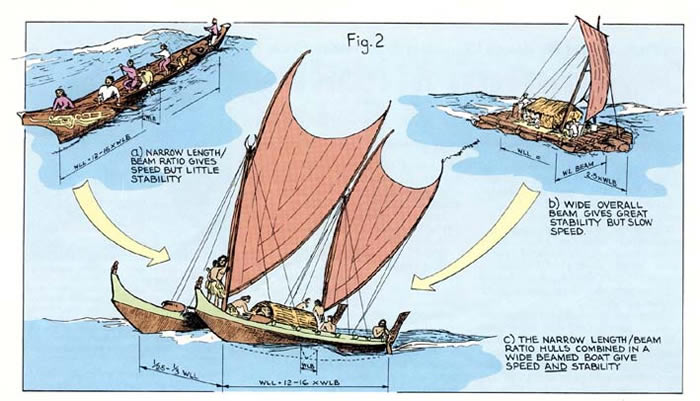
Hard paddling men with their food and water add up to weight. Even the toughest men can only paddle for a few hours.
Other Pacific maritime people had sailing rafts. Thor Heyerdahl's Kon Tiki expedition of 1947 used a modern replica of this type of craft. 45 ft. long, 18 ft. wide, rigged with a squaresail, manoeuvred by daggerboards, it could sail sufficiently against the wind to be a true sailing craft. It carried a crew of six in basic, though surprising comfort across the Pacific. (See Fig.2b)
It was not a speedy craft, but by its beam and weight, it was practically impossible to capsize and thus had stability, an essential part of seaworthiness.
Long ago some genius in the Pacific joined two fast, easily driven canoe hulls into a beamy raft shape, giving a new type of sailing craft with the stability of the broad beam raft and the high-through-the-water speed potential of the single canoe. (See Fig.2c)
Fig.2c is an approximation of a traditional Polynesian sailing craft and how it developed from its two ancestral types. It has a raft-like deck platform that could house people, and ample room to move around. From early European explorers' descriptions, the crew sailed with families, friends, lovers, singers and dancers in one joyous group from island to island - a marvellous way of life.
Efficient Crab Claws
Modern wind tunnel tests, as done by Tony Marchaj, of Southampton University, have shown that the Polynesian sail shapes were highly efficient to windward. With efficient sails, a hull form that allowed the boats to sail faster than the maximum speed of 1.4 x √WLL of Western ships and enough raft stability to be uncapsizable, (i.e. the sails would rip before the ships could capsize), the Polynesian catamaran was a remarkable sailing craft and worthy of being developed as a modern pleasure sailing craft.
Though to-day's yachtsman increasingly accepts the concept of the double-hulled ship, he/she places modern urban attitudes on the catamaran. These are: 1) to get the maximum speed potential out of the catamaran form. (Faster is always equated with being better, no matter what the cost.) 2) to alter the hull form to get as close to modern urban style accommodation needs as possible, which was described in the recent RYA (Royal Yachting Association) 'Competent Crew Handbook': "The typical modern cruising yacht has....interior design principles....much in common with a caravan".
The quest for speed
It is Demand 1) which creates most controversy for, in order to reach the maximum speed potential of a catamaran, you have to carry a large sail area, which reduces its inherent stability to the point, where with the average cruising crew, it is in danger of capsizing well before the average monohull suffers a knockdown.
With a sense of realism any would-be catamaran owner, once he/she knows how to calculate stability, can make his/her own decision when viewing a cruising catamaran design, whether they want maximum speed or maximum stability. As the formula will show, you cannot have both at the same time. Fig.3 shows how to calculate catamaran stability. Fig.4 and Fig.5 are helpful to learn how to determine the position of the center of Effort and the Center of Lateral Resistance.

In 1976, catamarans built using this stability formula were capsizing all over the world at mean wind speeds a lot lower than the wind speed the formula predicted.
In an Article called "The Stable Multihull", published in 1977, Hanneke Boon and I demonstrated that the given formula was a static formula for static state conditions.
However, wind is a turbulent, gusty, dynamic force. Gusts can be as much as 40% to 60% greater than the mean wind speed, so the static formula has to have built in a safety factor for dynamic, natural state wind conditions to allow sailing craft to absorb the extra wind gusts without immediately capsizing in the manner of a dinghy.
Since 1977, this dynamic formula concept, after much initial argument, has been accepted. It has now been generally agreed amongst designers, that taking 60% (x 0.6) of the Static stability allows for a suitable safety factor. So, the Dynamic Stability (i.e. maximum mean wind speed it is safe to sail in before reducing sail) is found as follows:
At the M.O.C.R.A. symposium were the designers of two 34-35 ft. catamarans about to be placed on the market. We will use them as examples of two opposing design attitudes towards speed and catamaran stability. Their dimensions, obtained from yacht magazines and brochures, are given in Fig.6a .

The first noticeable points from Fig.6a are that catamaran B has a wider beam than catamaran A, but carries 33% more sail and has a much lighter construction weight.
If you asked the opinion of the designer of catamaran A with reference to design B, he would say that he has been designing and building catamarans for thirty years, that his sail area to weight ratio to beam etc. had evolved to provide the maximum stability, Which adds up to sailing safety.
The designer of catamaran B, a more recent designer in the cruising catamaran field, would point out, that his design had much more beam (which is a feature of catamaran design over the last ten years) and. thus has the stability to carry the extra sail area.
You, the would-be catamaran purchaser, without the aid of the given formula would be at a loss to know:
- The Static Stability of either design, which can be described as the "Moment of Truth" when the boat is on the edge of capsizing i.e. when the windward hull lifts out of the water.
- The Dynamic Stability , when it is safe to sail along with all sails up and have sufficient reserve stability to meet safely any wind gusts that lie under that lovely white cloud or just along the coast where a narrow, scenic valley opens to the sea and down which the wind unexpectedly gusts.
Fig.6b shows the working out of the Static and Dynamic stability of both designs, using their lightly loaded weights, sometimes described as racing trim. From the formula we can see that catamaran B has less stability in spite of its wider beam than catamaran A. So what!
These figures must be related to the real world of sailing. To do this I will use a book by the sailing meteorologist, Alan Watts, called "Instant Weather Forecasting" (published by Adlard Coles).
On pages 10 and 11, Alan Watts describes the behavior of dinghies and deep keel monohulls in various wind strengths. (I have extracted these details for wind forces 3 to 6.). See Fig.7 .
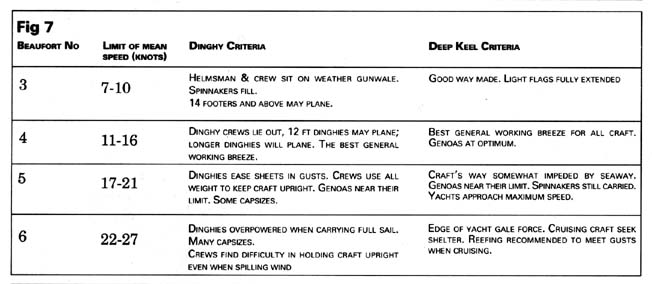
Catamaran A with a Dynamic stability of 18.2 knots ( Fig.6 ) needs to be carefully sailed or reefed by the middle of force 5 (remember this is a lightly loaded catamaran). Alan Watts describes the deep keel monohull in a force 5 wind as "Craft's way somewhat impeded by seaway. Genoas near their limit. Yachts approach maximum speed.'
Force 5 is a well-known wind state that to the average yachtsman draws attention to itself by strong audiovisual signals of waves and wind, which leads him naturally to take particular care in sailing, changing headsails or reefing.
Therefore, if a monohull yachtsman handling Catamaran A is slow at reefing in force 5 and is hit by a strong wind gust, he would have approx. a 60% stability safety margin to absorb his slowness and the gust, for his windward hull would not begin to lift from the water (the Moment of Truth) until 30.5 knots of wind hits the sails (i.e. a force 7 gust).
Similar sail handling
Conclusion, the same sail handling habits of the monohull cruising sailor can easily be applied to the lightly loaded catamaran A, without fear of immediate capsize. Catamaran B with a Dynamic stability of 13.3 knots (lightly loaded) will need to be carefully handled, aware of wind gusts, or reefed, to preserve its 60% stability safety margin in the middle of force 4 (11-16 knots). THIS IS AT ONE FORCE lower than monohulls or Catamaran A.
Watts describes force 4 for monohulls as: "Best general working breeze for all craft, genoas at optimum". With the necessity to reef to preserve the 60% safety margin, this description does not apply to Catamaran B. However, his description of force 4 for dinghies does, for he writes: "Dinghy crews lie out...", i.e. are attentive to stability to prevent capsizing. As dinghies, so Catamaran B.
Catamaran B continues to echo dinghy-handling characteristics at increasing wind strengths. Catamaran B's Static stability, i.e. hull lifting point, lies on the borderline between force 5 and 6 (22.5 knots). Watts' dinghy handling descriptions for force 5 and 6 are as follows: Force 5: "Dinghies ease sheets in gusts...some capsizes." Force 6: "Dinghies overpowered when carrying full sail. Many capsizes." Conclusion: Lightly loaded Catamaran B, above wind force 4 can only be sailed safely by skilled dinghy type sailing techniques or should be reefed at force 4.
Why not reef?
The enthusiasts for the Catamaran B type argue that for general family cruising, you can reef Catamaran B and give it the same monohull type stability as Catamaran A. At other times, with a trained crew and all sails up, you have the benefits of fast exciting sailing.
This is true, and Fig.8 shows the use of the formula to see how much sail you would have to reef down to give Catamaran B the same stability as Catamaran A with all sail up. This is a sail reduction from 750 sq.ft, to 511 sq.ft.

Providing that reefing was a rigidly applied rule when there was not a fully experienced dinghy technique skipper standing by the sheets or helm, it would be effective.
If you feel a little conspicuous, sailing reefed in a Force 4 breeze, you can carry more load to stabilize Catamaran B. Again, the formula (see Fig.9 ) shows that if the boat weight is increased to 11787 lbs with extra stores and equipment (in fact, its full cruising payload), your stability would again equal that of Catamaran A in its lightly loaded condition.

However, if Catamaran A increases its payload to the designed maximum (approx. 11050 lbs) its Dynamic stability goes up too, and it would require a gale gust of 34 knots, to lift one hull out of the water. This conforms to the wind stabilities of traditional sailing craft throughout the ages. A cruising catamaran designed to these principles gives no stability problems to the average yachtsman and his family, enjoying its broad decked upright sailing.

My Cruiser Life Magazine
Basics of Sailboat Hull Design – EXPLAINED For Owners
There are a lot of different sailboats in the world. In fact, they’ve been making sailboats for thousands of years. And over that time, mankind and naval architects (okay, mostly the naval architects!) have learned a thing or two.
If you’re wondering what makes one sailboat different from another, consider this article a primer. It certainly doesn’t contain everything you’d need to know to build a sailboat, but it gives the novice boater some ideas of what goes on behind the curtain. It will also provide some tips to help you compare different boats on the water, and hopefully, it will guide you towards the sort of boat you could call home one day.
Table of Contents
Displacement hulls, semi displacement hulls, planing hulls, history of sailboat hull design, greater waterline length, distinctive hull shape and fin keel designs, ratios in hull design, the hull truth and nothing but the truth, sail boat hull design faqs.

Basics of Hull Design
When you think about a sailboat hull and how it is built, you might start thinking about the shape of a keel. This has certainly spurred a lot of different designs over the years, but the hull of a sailboat today is designed almost independently of the keel.
In fact, if you look at a particular make and model of sailboat, you’ll notice that the makers often offer it with a variety of keel options. For example, this new Jeanneau Sun Odyssey comes with either a full fin bulb keel, shallow draft bulb fin, or very shallow draft swing keel. Where older long keel designs had the keel included in the hull mold, today’s bolt-on fin keel designs allow the manufacturers more leeway in customizing a yacht to your specifications.
What you’re left with is a hull, and boat hulls take three basic forms.
- Displacement hull
- Semi-displacement hulls
- Planing hulls
Most times, the hull of a sailboat will be a displacement hull. To float, a boat must displace a volume of water equal in weight to that of the yacht. This is Archimedes Principle , and it’s how displacement hulled boats get their name.
The displacement hull sailboat has dominated the Maritimes for thousands of years. It has only been in the last century that other designs have caught on, thanks to advances in engine technologies. In short, sailboats and sail-powered ships are nearly always displacement cruisers because they lack the power to do anything else.
A displacement hull rides low in the water and continuously displaces its weight in water. That means that all of that water must be pushed out of the vessel’s way, and this creates some operating limitations. As it pushes the water, water is built up ahead of the boat in a bow wave. This wave creates a trough along the side of the boat, and the wave goes up again at the stern. The distance between the two waves is a limiting factor because the wave trough between them creates a suction.
This suction pulls the boat down and creates drag as the vessel moves through the water. So in effect, no matter how much power is applied to a displacement hulled vessel, it cannot go faster than a certain speed. That speed is referred to as the hull speed, and it’s a factor of a boat’s length and width.
For an average 38 foot sailboat, the hull speed is around 8.3 knots. This is why shipping companies competed to have the fastest ship for many years by building larger and larger ships.
While they might sound old-school and boring, displacement hulls are very efficient because they require very little power—and therefore very little fuel—to get them up to hull speed. This is one reason enormous container ships operate so efficiently.
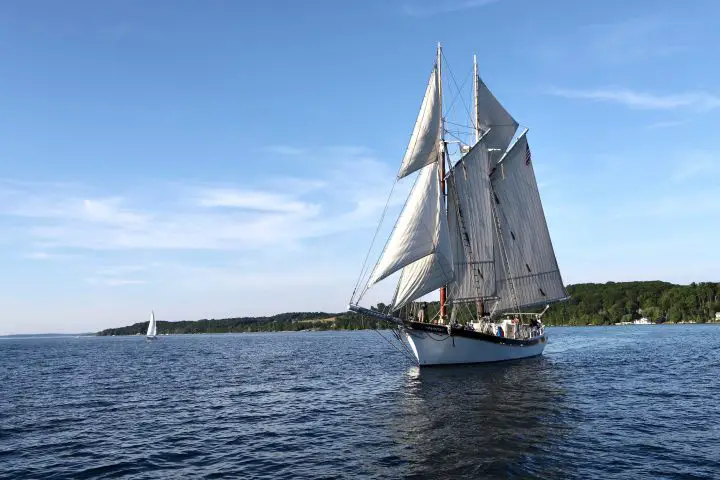
Of course, living in the 21st century, you undoubtedly have seen boats go faster than their hull speed. Going faster is simply a matter of defeating the bow wave in one way or another.
One way is to build the boat so that it can step up onto and ride the bow wave like a surfer. This is basically what a semi-displacement hull does. With enough power, this type of boat can surf its bow wave, break the suction it creates and beat its displacement hull speed.
With even more power, a boat can leave its bow wave in the dust and zoom past it. This requires the boat’s bottom to channel water away and sit on the surface. Once it is out of the water, any speed is achievable with enough power.
But it takes enormous amounts of power to get a boat on plane, so planing hulls are hardly efficient. But they are fast. Speedboats are planing hulls, so if you require speed, go ahead and research the cost of a speedboat .
The most stable and forgiving planing hull designs have a deep v hull. A very shallow draft, flat bottomed boat can plane too, but it provides an unforgiving and rough ride in any sort of chop.
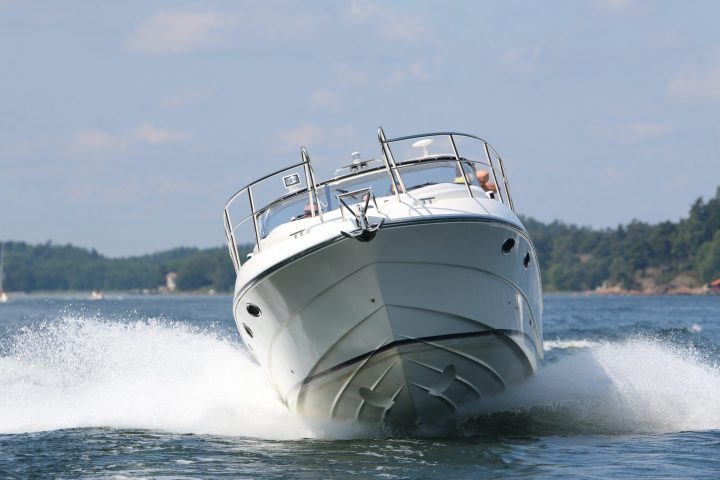
If you compare the shapes of the sailboats of today with the cruising boat designs of the 1960s and 70s, you’ll notice that quite a lot has changed in the last 50-plus years. Of course, the old designs are still popular among sailors, but it’s not easy to find a boat like that being built today.
Today’s boats are sleeker. They have wide transoms and flat bottoms. They’re more likely to support fin keels and spade rudders. Rigs have also changed, with the fractional sloop being the preferred setup for most modern production boats.
Why have boats changed so much? And why did boats look so different back then?
One reason was the racing standards of the day. Boats in the 1960s were built to the IOR (International Offshore Rule). Since many owners raced their boats, the IOR handicaps standardized things to make fair play between different makes and models on the racecourse.
The IOR rule book was dense and complicated. But as manufacturers started building yachts, or as they looked at the competition and tried to do better, they all took a basic form. The IOR rule wasn’t the only one around . There were also the Universal Rule, International Rule, Yacht Racing Association Rul, Bermuda Rule, and a slew of others.
Part of this similarity was the rule, and part of it was simply the collective knowledge and tradition of yacht building. But at that time, there was much less distance between the yachts you could buy from the manufacturers and those setting off on long-distance races.
Today, those wishing to compete in serious racing a building boat’s purpose-built for the task. As a result, one-design racing is now more popular. And similarly, pleasure boats designed for leisurely coastal and offshore hops are likewise built for the task at hand. No longer are the lines blurred between the two, and no longer are one set of sailors “making do” with the requirements set by the other set.
Modern Features of Sailboat Hull Design
So, what exactly sets today’s cruising and liveaboard boats apart from those built-in decades past?
Today’s designs usually feature plumb bows and the maximum beam carried to the aft end. The broad transom allows for a walk-through swim platform and sometimes even storage for the dinghy in a “garage.”
The other significant advantage of this layout is that it maximizes waterline length, which makes a faster boat. Unfortunately, while the boats of yesteryear might have had lovely graceful overhangs, their waterline lengths are generally no match for newer boats.
The wide beam carried aft also provides an enormous amount of living space. The surface area of modern cockpits is nothing short of astounding when it comes to living and entertaining.
If you look at the hull lines or can catch a glimpse of these boats out of the water, you’ll notice their underwater profiles are radically different too. It’s hard to find a full keel design boat today. Instead, fin keels dominate, along with high aspect ratio spade rudders.
The flat bottom boats of today mean a more stable boat that rides flatter. These boats can really move without heeling over like past designs. Additionally, their designs make it possible in some cases for these boats to surf their bow waves, meaning that with enough power, they can easily achieve and sometimes exceed—at least for short bursts—their hull speeds. Many of these features have been found on race boats for decades.
There are downsides to these designs, of course. The flat bottom boats often tend to pound when sailing upwind , but most sailors like the extra speed when heading downwind.
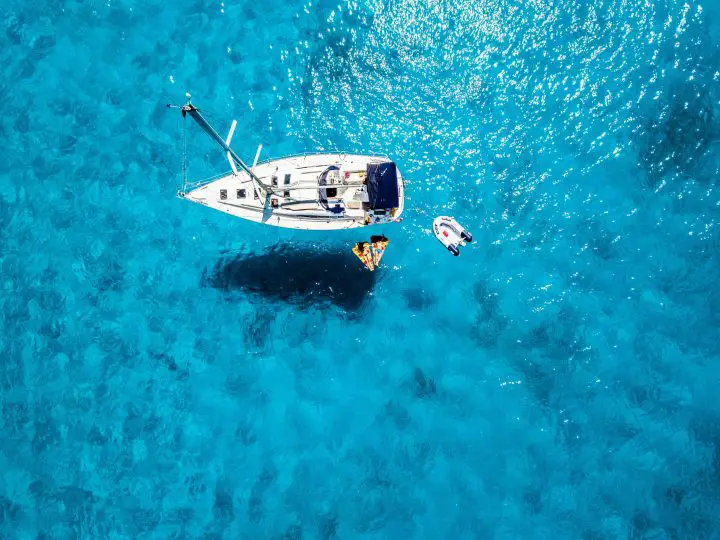
How Do You Make a Stable Hull
Ultimately, the job of a sailboat hull is to keep the boat afloat and create stability. These are the fundamentals of a seaworthy vessel.
There are two types of stability that a design addresses . The first is the initial stability, which is how resistant to heeling the design is. For example, compare a classic, narrow-beamed monohull and a wide catamaran for a moment. The monohull has very little initial stability because it heels over in even light winds. That doesn’t mean it tips over, but it is relatively easy to make heel.
A catamaran, on the other hand, has very high initial stability. It resists the heel and remains level. Designers call this type of stability form stability.
There is also secondary stability, or ultimate stability. This is how resistant the boat is to a total capsize. Monohull sailboats have an immense amount of ballast low in their keels, which means they have very high ultimate stability. A narrow monohull has low form stability but very high ultimate stability. A sailor would likely describe this boat as “tender,” but they would never doubt its ability to right itself after a knock-down or capsize.
On the other hand, the catamaran has extremely high form stability, but once the boat heels, it has little ultimate stability. In other words, beyond a certain point, there is nothing to prevent it from capsizing.
Both catamarans and modern monohulls’ hull shapes use their beams to reduce the amount of ballast and weight . A lighter boat can sail fast, but to make it more stable, naval architects increase the beam to increase the form stability.
If you’d like to know more about how stable a hull is, you’ll want to learn about the Gz Curve , which is the mathematical calculation you can make based on a hull’s form and ultimate stabilities.
How does a lowly sailor make heads or tails out of this? You don’t have to be a naval architect when comparing different designs to understand the basics. Two ratios can help you predict how stable a design will be .
The first is the displacement to length ratio . The formula to calculate it is D / (0.01L)^3 , where D is displacement in tons and L is waterline length in feet. But most sailboat specifications, like those found on sailboatdata.com , list the D/L Ratio.
This ratio helps understand how heavy a boat is for its length. Heavier boats must move more water to make way, so a heavy boat is more likely to be slower. But, for the ocean-going cruiser, a heavy boat means a stable boat that requires much force to jostle or toss about. A light displacement boat might pound in a seaway, and a heavy one is likely to provide a softer ride.
The second ratio of interest is the sail area to displacement ratio. To calculate, take SA / (D)^0.67 , where SA is the sail area in square feet and D is displacement in cubic feet. Again, many online sites provide the ratio calculated for specific makes and models.
This ratio tells you how much power a boat has. A lower ratio means that the boat doesn’t have much power to move its weight, while a bigger number means it has more “get up and go.” Of course, if you really want to sail fast, you’d want the boat to have a low displacement/length and a high sail area/displacement.
Multihull Sailboat Hulls
Multihull sailboats are more popular than ever before. While many people quote catamaran speed as their primary interest, the fact is that multihulls have a lot to offer cruising and traveling boaters. These vessels are not limited to coastal cruising, as was once believed. Most sizable cats and trimarans are ocean certified.
Both catamarans and trimaran hull designs allow for fast sailing. Their wide beam allows them to sail flat while having extreme form stability.
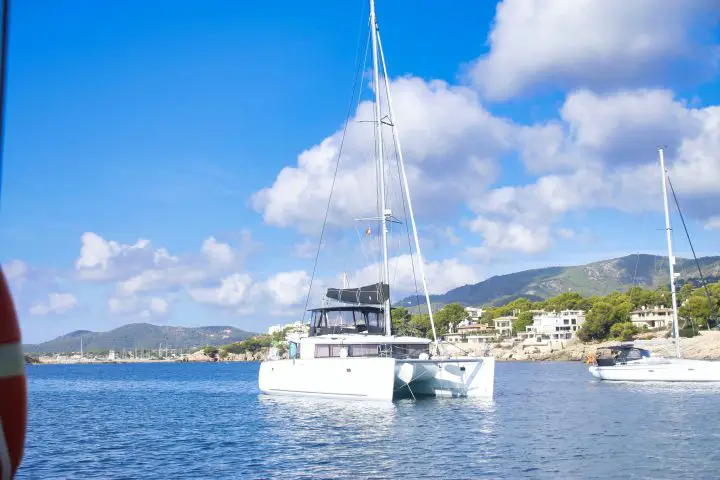
Catamarans have two hulls connected by a large bridge deck. The best part for cruisers is that their big surface area is full of living space. The bridge deck usually features large, open cockpits with connecting salons. Wrap around windows let in tons of light and fresh air.
Trimarans are basically monohulls with an outrigger hull on each side. Their designs are generally less spacious than catamarans, but they sail even faster. In addition, the outer hulls eliminate the need for heavy ballast, significantly reducing the wetted area of the hulls.
Boaters and cruising sailors don’t need to be experts in yacht design, but having a rough understanding of the basics can help you pick the right boat. Boat design is a series of compromises, and knowing the ones that designers and builders take will help you understand what the boat is for and how it should be used.
What is the most efficient boat hull design?
The most efficient hull design is the displacement hull. This type of boat sits low in the water and pushes the water out of its way. It is limited to its designed hull speed, a factor of its length. But cruising at hull speed or less requires very little energy and can be done very efficiently.
By way of example, most sailboats have very small engines. A typical 40-foot sailboat has a 50 horsepower motor that burns around one gallon of diesel every hour. In contrast, a 40-foot planing speedboat may have 1,000 horsepower (or more). Its multiple motors would likely be consuming more than 100 gallons per hour (or more). Using these rough numbers, the sailboat achieves about 8 miles per gallon, while the speedboat gets around 2 mpg.
What are sail boat hulls made of?
Nearly all modern sailboats are made of fiberglass.
Traditionally, boats were made of wood, and many traditional vessels still are today. There are also metal boats made of steel or aluminum, but these designs are less common. Metal boats are more common in expedition yachts or those used in high-latitude sailing.
Matt has been boating around Florida for over 25 years in everything from small powerboats to large cruising catamarans. He currently lives aboard a 38-foot Cabo Rico sailboat with his wife Lucy and adventure dog Chelsea. Together, they cruise between winters in The Bahamas and summers in the Chesapeake Bay.

In order to be called a true luxury performance offshore cruising catamaran, the width of the OE60’s hull has been carefully balanced for performance and splendid liveaboard comfort. Displacement, hull shape, and sail power are the key design features of an OE.
The advanced hydrodynamic shape of the hull, designed by world-renowned naval architect Germán Frers, utilizes the optimal length to beam ratio to minimize the wetted surface and deliver true performance. Instead of opting for fixed keels, a daggerboard configuration was chosen based on the advantages of providing lift, and lateral resistance versus drag.
This design is also more efficient by providing outstanding upwind performance with the daggerboards down, and best performance with daggerboards up in a reaching or running sailing angle. Another advantage with the daggerboards up is that the draught is less than 80 cm, allowing you to sail and anchor in shallow waters unreachable to most.
OE60 Specification
Please find the specification for the OE60 via this link:
Ready to Explore
The ocean explorer catamaran is an oceangoing expression of your dreams. an adventure at sea is filled with unforgettable memories you’ll cherish every day for the rest of your life., step inside, the interior design enhances your sailing experience by providing you with the most exceptional liveaboard comfort customized to reflect your taste., breaking the barriers, the advanced hydrodynamic shape of the hull, designed by world- renowned naval architect germán frers., it´s in the details, true craftsmanship from the very best.
The OE64 is the newest member of the line of luxury bluewater sailing catamarans. The 64 has a stronger focus on performance, having the Ocean Explorer 60 setting the benchmark for luxury catamarans, the 64 offers the same interior layout with a longer waterline and different deck layout. More focused on fast cruising and racing.
This model offers a great opportunity for a fast yet comfortable catamaran that can be eco friendly. Using materials like flax for a stiffer and lighter hull, yet gives you the edge on the racing course. Something to include in your modern eco-friendly catamaran is propulsion, there is a range of different hybrid and fully electric options.
The catamaran is designed for shorthanded sailing, and with experienced owners the yacht can be taken out by two persons only, but naturally for longer sailing it is always good to have more hands to make the journey more enjoyable. With all electric winches and furlers this yacht is ideal for both young families.

OE64 Specification
Please find the specification for the OE64 via this link:
The new frontrunner
The oe64 is the newest member of the line of luxury bluewater sailing catamarans., performance, focused on fast cruising and racing., no compromises, the perfect balance between speed and comfortability, luxury & comfort.
The interior has curves and clean, sweeping lines to match the sleek exterior.
Relax in comfort
Unwind after a long and fast day out at sea

The OE72 designed by German Frers offers innovative elements reflected in the accommodation and deck arrangement. Whether you plan to cruise stylishly around the world or race comfortably at 25+ knots offshore the OE72 will be the perfect platform to reach your goals. The accommodation volume offers ample space for comfort while the hull design measurements are focused on delivering high performance and stability. The fully customizable layout is designed to operate with only two crew to reduce operational expenses and weight from extra crew cabins and to increase interior volume and simplicity for the owner.
The OE72 offers many customizable options to transform this elegant platform into anything from a luxuriously spacious yacht with all the toys, to a highly efficient green circumnavigation machine to get off the grid entirely, or even into the ultimate microlight offshore racing multihull with the latest foiling package. Or perhaps an elegant combination of all of these elements! The four-cabin arrangement provides a generous amount of personal space and comfort. A three and five-cabin arrangement remains a part of the custom layouts available.
OE72 Specification
Please find the specification for the OE72 via this link:
Made for Adventurers
Grab the helm, discover new surroundings and fully experience your freedom on the water.
The new OE78 will embody the Scandinavian archetype of the OE60 and OE72 while expanding on the core features to become the ultimate maxi catamaran. Whether you plan to cruise stylishly around the world or race comfortably at 25+ knots offshore, the OE78 will be the perfect platform to reach your goal. The combination of high performance and abundant living and entertaining areas makes the OE78 comparable to a 100’+ performance cruising monohull while maintaining a very shallow draft to reach more destinations. Designed with the same efficient hull shape as her sister ships, the additional length and width create room for a spacious master cabin as well as VIP cabins, all with exemplary attention to detail in a timeless design.
The OE78 offers a unique balance between comfort and performance and will not be overtaken by any other catamaran in her class. The fully customizable layout is designed to operate with three to four crew depending on the intended use. The six-cabin arrangement provides a generous amount of personal space and comfort. A four, five, and seven cabin arrangement remains a part of the custom layouts available.

OE78 Specification
Please find the specification for the OE78 via this link:
The new flagship
The new OE78 will embody the Scandinavian archetype of the OE60 and OE72 while expanding on the core features to become the ultimate maxi catamaran
- 2024 BOAT BUYERS GUIDE
- Email Newsletters
- Boat of the Year
- 2024 Freshwater Boat and Gear Buyers Guide
- 2024 Boat Buyers Guide
- 2024 Water Sports Boat Buyers Guide
- 2023 Pontoon Boat Buyers Guide
- Cruising Boats
- Pontoon Boats
- Fishing Boats
- Personal Watercraft
- Water Sports
- Boat Walkthroughs
- What To Look For
- Best Marine Electronics & Technology
- Watersports Favorites Spring 2022
- Boating Lab
- Boating Safety

Six Amazing Boat Hull Designs
- By Dean Travis Clarke
- Updated: October 25, 2016
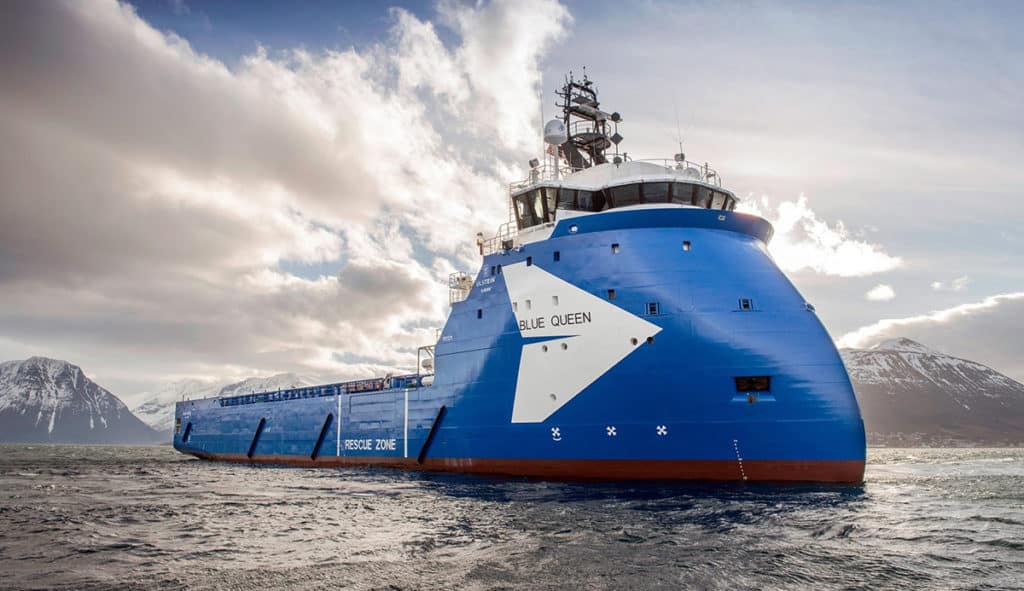
The American boating consumer bears a remarkable psychological profile when it comes to wants and needs.
A cursory glance at the lines of most boats proves that profiles haven’t changed dramatically over the past 60 or so years. Certainly, construction methods such as resin infusion and injection molding have altered business as usual, and ingredients have also changed to include all manner of space-age composites, epoxies, paints, computer mapping for engines that produces vastly greater horsepower from smaller blocks, and so on. Even propulsion has changed with the advent of pod drives and big outboards. But here’s the weird part: Any time a designer or builder introduces a model that looks significantly different, whether it is Euro-styled or functionally clunky, it fails. It doesn’t matter how well the boat performs, the typical boater rejects it because it doesn’t look like what he knows. We, as an enthusiast niche involving boats, are horribly set in our aesthetic ways.
Look at how well multihulls handle heavy seas. When it comes to seakeeping ability, efficiency and performance, the catamaran has a lot going for it, as anyone who happened to catch some of the most recent America’s Cup racing can attest. And yet, to date, production multihulls have enjoyed only moderate acceptance by boaters.
Here are six of the latest hull-design innovations and technologies being used elsewhere in the maritime world that we will likely never accept for our recreational boats — even though they all work well.
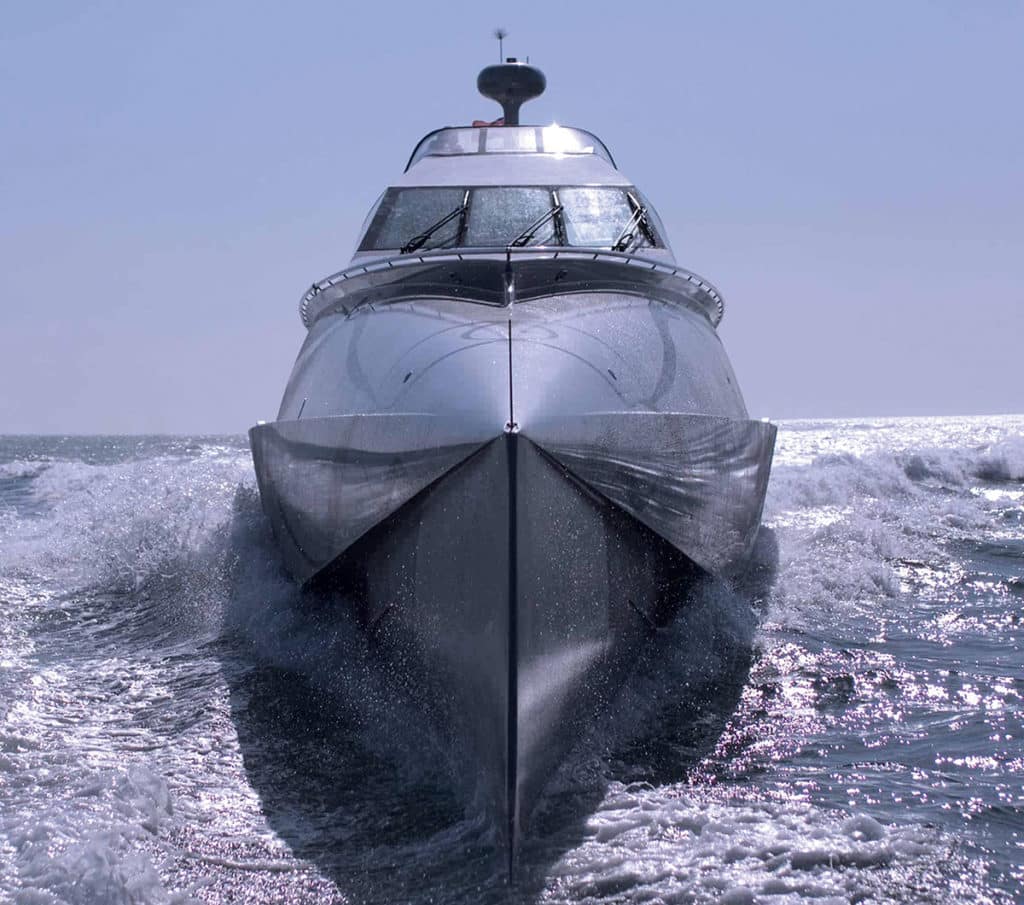
Wave-Piercing Hulls Most accounts cite wave-piercing technology as coming on the scene around the start of the 20th century. However, it has been employed as far back as the times of the Phoenicians and ancient Romans. The design concept consists of a bow with little buoyancy, a hull that slopes inward from the waterline and, ergo, a large reduction in wave-making resistance. While it works well in heavy seas, the drawbacks include reduced interior volume forward and a very wet ride because the waves come up and over the bow as a matter of course. Wave piercers fell out of favor for a period of time due to these same drawbacks but have recently enjoyed a resurgence of popularity because of their dramatic fuel-efficiency gains.
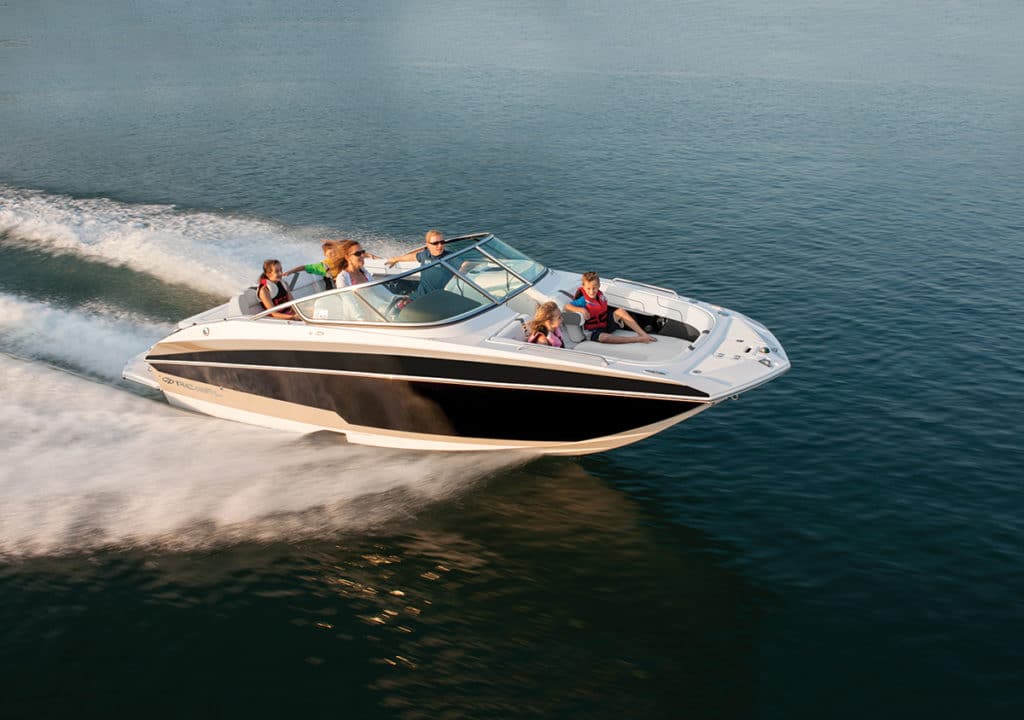
Stepped Hulls OK, this hull form has achieved a certain level of acceptance in our recreational boats, mostly in performance boats or offshore center consoles. But why isn’t it more popular? The stepped bottom has been around as a V-bottom refinement since at least 1912. Steps are grooves in the hull stretching outward from the keel to the chines. Most hulls sport one or two steps per side. And a vessel should really be capable of cruising in excess of about 30 knots for a stepped hull to be worthwhile. Steps work by allowing air to be “injected” against the running surface, breaking contact between part of the hull and the water, which in effect turns the running surface into numerous short, wide planes, rather than one long, narrow one.
How much the hull surface contacts the water directly determines the amount of drag a hull suffers. Steps (also called vents) decrease the amount of hull contacting the water (called the wetted surface), thereby decreasing drag, increasing speed for the same horsepower, and increasing fuel efficiency. It all sounds good. But steps also come with potential drawbacks. Though modern deep-V designs have enough deadrise to counteract the problem in most cases, stepped hulls have been known to suffer from transom slide in sharp turns at speed. They also require attention to loading and trim because the steps need the proper angle of attack to function correctly; they don’t offer an advantage in flat, calm water; and they require a special trailer.
Most owners of stepped-hull vessels are experienced and want to travel at high speeds in moderate to heavy seas, and/or achieve good economy and range. Yet to date, performance and center console builders aside, only Regal Boats, with its FasTrac hulls, and Formula have committed to using steps in production cruisers and sport boats.
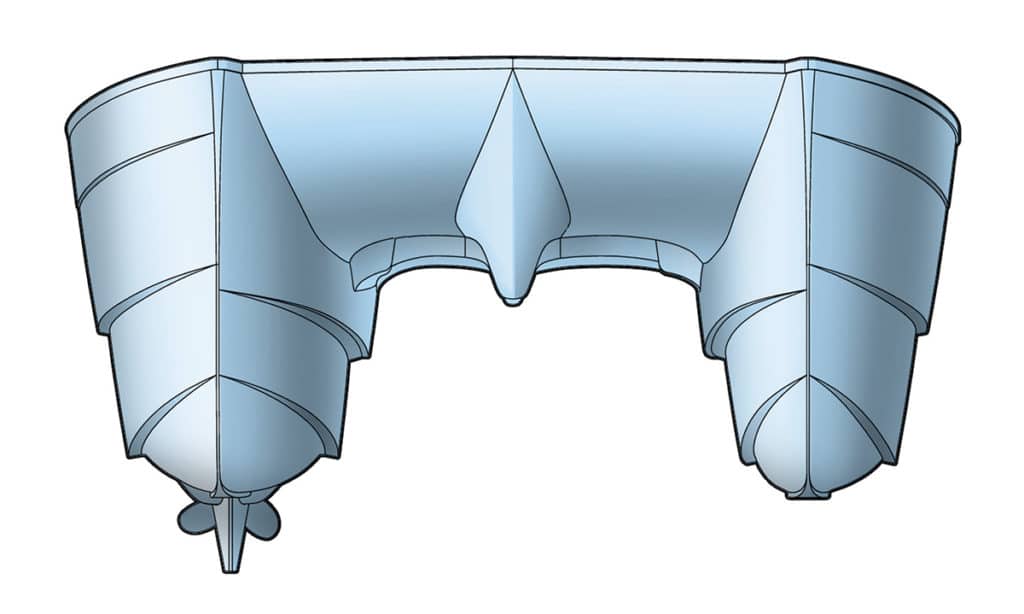
Asymmetrical Twin Hulls This unique design concept comes from the drawing board of Larry Graf, the pioneer who put power catamarans on the map here in the U.S. when he founded Glacier Bay Boats in 1987. His new company, Aspen Powerboats, employs a cat design where one hull is narrower (35 percent) than the other. His patent calls it a Power Proa, and it relies on a single engine in only the wider of the two hulls. The hull shapes, alignment and placement compensate for the offset propulsion thrust, allowing the vessel to run straight and true. With only one set of running gear in the water, inherent appendage drag is reduced by 20 percent. Combined with the efficiency of the hull designs, overall fuel efficiency of the Aspen rises to an impressive 70 percent over monohulls of comparable size. Aspen won an award for the best 30- to 39-foot catamaran in the world in 2014.
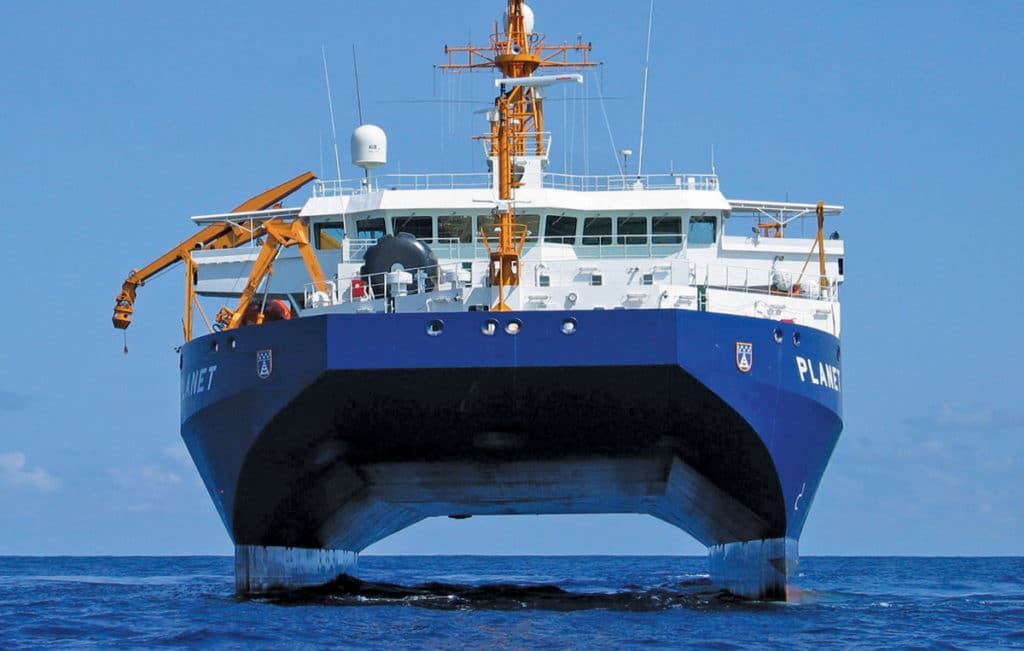
SWATH A quick glance might lead you to believe that a SWATH (small waterplane area twin hull) vessel is a catamaran. And it is but only to the extent that it has two hulls in the water with a bridge across the top. But that’s where the hulls’ similarities end.
Consider a submarine. Once under the surface, it runs stable, with no roll or pitching from wave action. All that wave energy remains on the sea surface. That basically explains how a SWATH design functions.
If you’ve ever dived under a wave at the beach to avoid being smacked by it, you know that the water beneath the wave is calmer. SWATH minimizes a vessel’s volume where the water meets the air (which is where all the wave energy is at its peak). The bulk of the vessel’s displacement and buoyancy runs beneath the waves, affording amazing stability, even in big seas and at high speeds. Please think of high speeds as a relative term here, as this is not a planing hull. What SWATH does provide, however, are a wide, stable deck and unsurpassed ride quality, especially in rough seas.
Drawbacks to SWATH designs include the fact that each hull must be custom designed. Draft runs deeper than standard hulls (especially planing hulls). The underwater “torpedoes” providing buoyancy must run parallel to the water’s surface, which requires a fairly complex trim-control system. And the underside of the deck must be far enough above the sea surface to avoid waves slamming up into it. Finally, SWATH vessels cost more to design and build than conventional hulls.
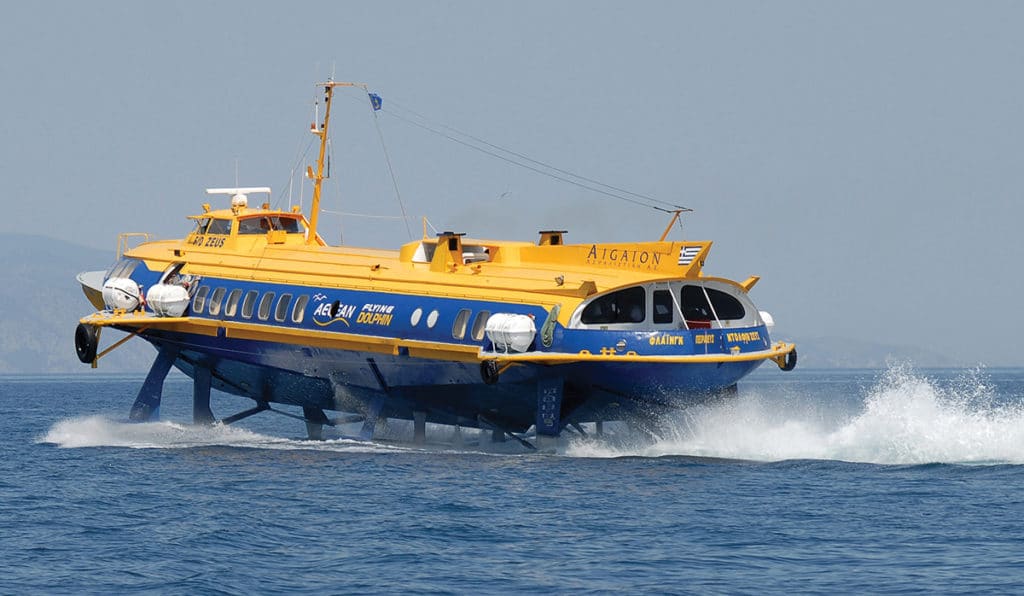
Hydrofoils Once the strict province of commercial ferries and a few high-speed military vessels, the most recent America’s Cup has spurred hydrofoil acceptance to new heights. Will it catch on with powerboats?
The hydrofoil design acts exactly like an airplane wing, providing more lift than the drag coefficient the vessel produces, thereby lifting the entire hull out of the water. Only the hydrofoils remain in the water, unaffected by surface wave action. In fact, hydrofoils cut inherent resistance to zero while the hull is out of the water. In the case of power-driven boats, you still suffer drag from the propulsion system (prop, shaft or the like).
The most significant disadvantage to this system on recreational boats is definitely the deployment of the foils. Unless you want the added draft of these struts sticking down below your hull all the time, you must be able to extend and withdraw them — a complex engineering feat. There is at least one recreational powerboat employing hydrofoils: Twin Vee builds a catamaran with foils that don’t actually lift the hulls completely out of the water. It does improve fuel economy and ride stability nonetheless. Still, boats ride more smoothly in a sea and go much faster with hydrofoils. With the dramatic acceptance of this technology in sailing, is it only a matter of time before recreational powerboats incorporate foils into their designs?
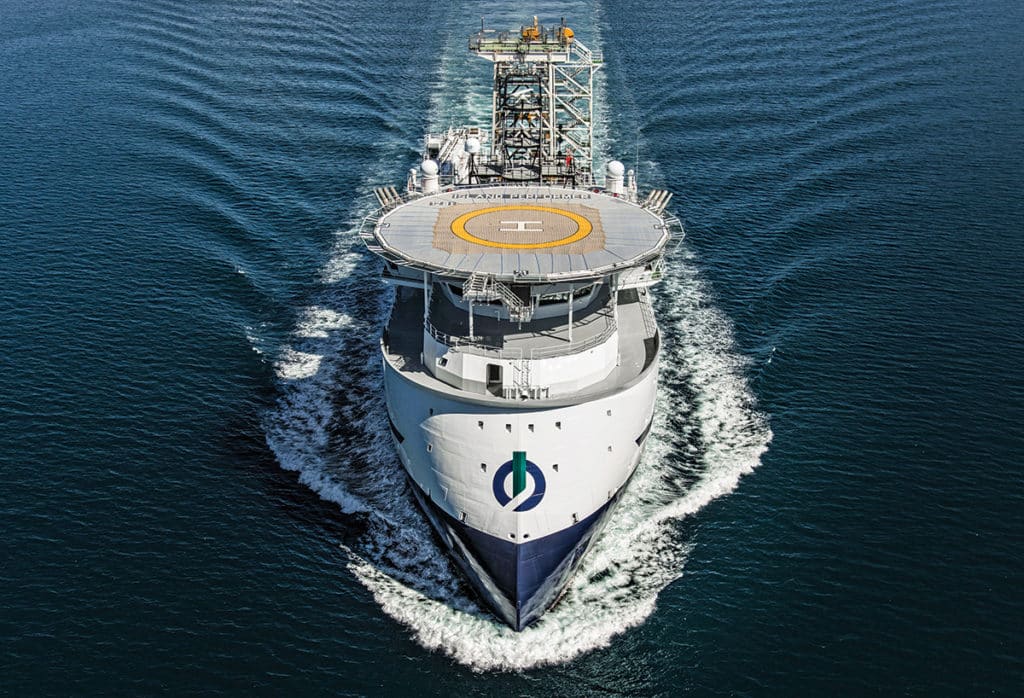
Ulstein X-Bow The Norwegian Ulstein Group has been designing offshore vessels since 1917. Presently, it has the notoriety of creating the most advanced bow design in history. The Ulstein X-Bow looks like it might be upside down, but it’s proven itself in more than 100 offshore support vessels to date. The X-Bow allows higher speeds and smoother rides in even the worst seas. Gone are the slamming and vibration that occur when the bow of a ship drops off a wave. It functions better on all points of sea, and its lower hydrodynamic drag substantially decreases fuel consumption. The X-Bow has proven so successful that Ulstein is in the process of creating an X-Stern design now.
You won’t ever see this on small recreational boats, but you can nod knowingly when someone points one out on a mega-yacht in the near future.
- More: Boats
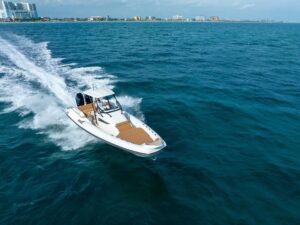
Boat Test: 2024 Nuova Jolly Prince 33 CC
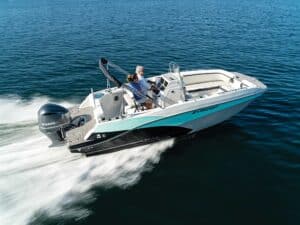
Boat Test: 2024 Starcraft SVX 231 OB CC
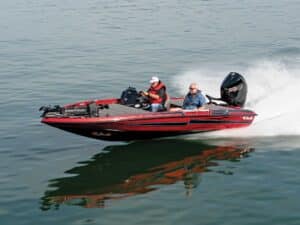
Boat Test: 2024 Bass Cat Caracal STS
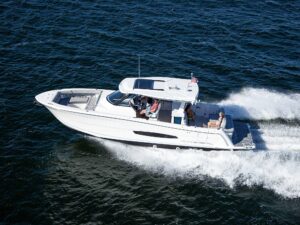
Boat Test: 2024 Regal 38 Surf
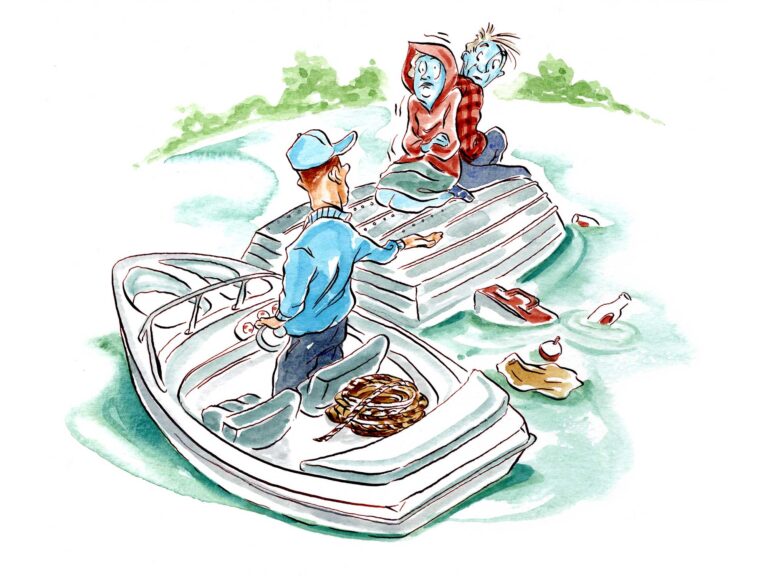
I Learned About Boating From This: Capsize, Rescue and Lessons Learned
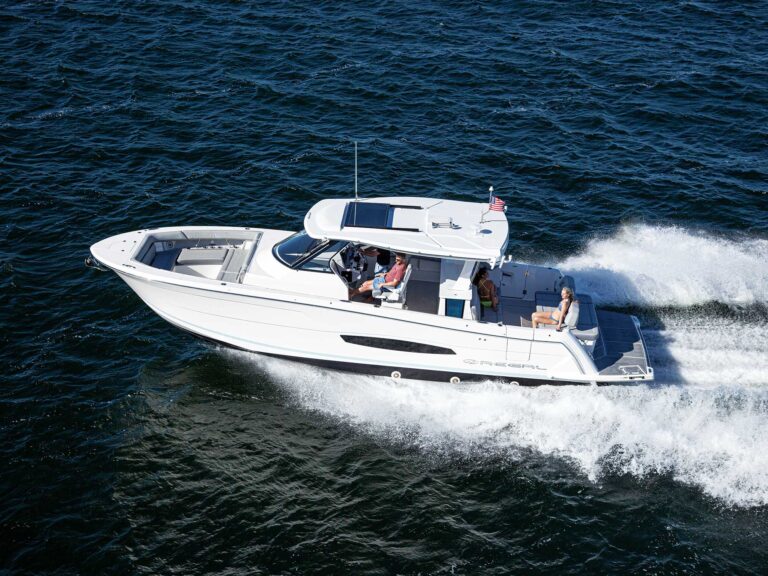
Using Hydrofoils to Improve Boat Performance
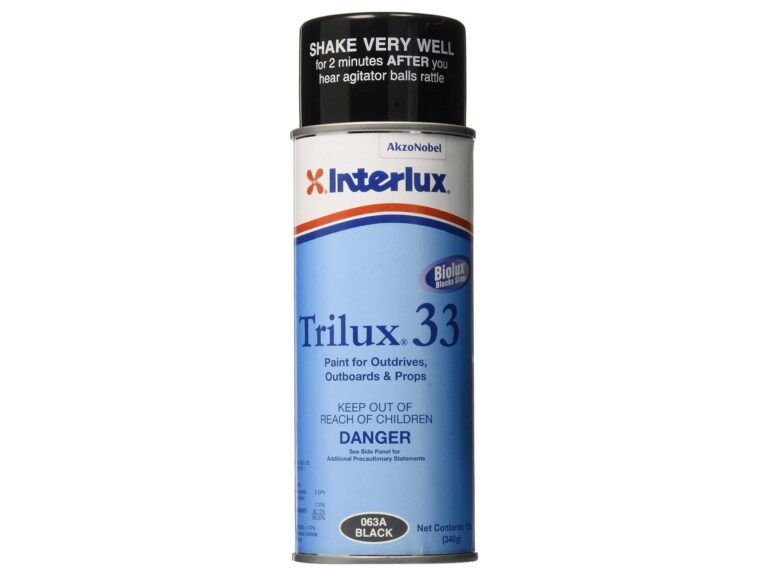
We Test Interlux Trilux 33 Aerosol Antifouling Paint

- Digital Edition
- Customer Service
- Privacy Policy
- Cruising World
- Sailing World
- Salt Water Sportsman
- Sport Fishing
- Wakeboarding
Many products featured on this site were editorially chosen. Boating may receive financial compensation for products purchased through this site.
Copyright © 2024 Boating Firecrown . All rights reserved. Reproduction in whole or in part without permission is prohibited.
- Lost password
Please Support TheBeachcats.com
- Forums index page
- :: Catamaran Sailing Discussion
- :: Getting Started
- View latest posts
- Search forums
Hello from San Jose, CA
- Print topic
- Rank: Lubber
- Registered: Oct 09, 2014
- Last visit: Dec 31, 2014
- Rank: Administrator
- Registered: Jul 19, 2001
- Last visit: Jan 19, 2024
- Posts: 3426
No HTML tags allowed (except inside [code][/code] tags)
- Submit Preview Cancel
Font size: Tiny Small Normal Large Huge
Your browser does not support javascript or you turned it off. The BBCode interface has been disabled.
Your browser does not support javascript or you turned it off. The bbsmile interface has been disabled.
Users on-line
This list is based on users active over the last 60 minutes.
Search The Beachcats
[ Add New Beachcat Event ]
Upcoming Beachcats Events
VIEW FULL CALENDAR
- June 6, 2024
- "Live on the Edge" Multihull Regatta and Race Clinic, Eugene, Oregon
Copyright TheBeachcats.com
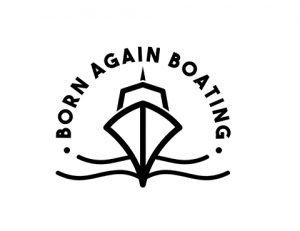
How To Get Rid Of A Boat: Disposing An Old Boat!
The real question that many people have asked is, how long is that boat going to sit there? We’ve all heard that the worst thing for a boat to do is to sit. Which is extremely true, it is the first step to becoming a problem in the boat owning world. So…
How To Get Rid Of A Boat or Dispose Of An Old Boat? There are only four real options to get rid of a boat. You can either sell it, donate it, recycle it, or have it taken to your local trash dump.
Getting an old boat out of your yard can be a grueling process. Here are your best options on how to begin and complete the process of getting that old boat gone!
Going Over Your Options, Where is the Title?
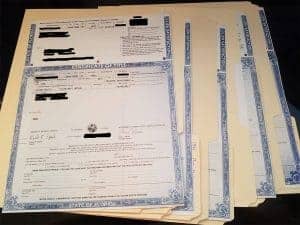
First things first, we need to know what your situation is. Addressing what kind of situation you are in will dictate how you get rid of your boat.
Things like, how important is it to get rid of? Where is it? Is the boat in your yard causing you frustration, or is it at a storage facility costing you money? What kind of boat is it? Fiberglass, aluminum?
All of these things are important to consider. Aluminum boats are easy to recycle, where fiberglass boats have to be sent to the dump.
What kind of shape is the boat in? Is the hull in decent shape, or does the engine run? If the hull is decent and the engine runs, you probably aren’t to the point of trashing the boat and taking a total loss on it.
What does the trailer look like? Will it make 10 feet and the axle fall off or is it road worthy?
Beginning with this type of assessment is going to really put your situation in perspective so you will know where to begin in order to dispose of the boat properly. Possibly even getting some cash out of it and just getting rid of it!
One other thing that you want to think about, is that infamous title! The big question, where is that title? Is the title in your name? Is it a clean title?
Selling The Boat
Having a clean title in hand will make a difference in how you get rid of the boat. If you have the title, the hull isn’t trashed, and the engine runs. Then you are in a position to sell the boat and actually get some cash out of the whole process!
One thing I will mention about this whole “getting cash” here, we need to be conscious of the end goal. If you have landed here on this article, chances are your bigger goal is to get rid of the boat. Not fund your retirement account!
Granted the little bit of money you get would be wisely placed in a retirement account. Generally, though we aren’t talking about a ton of money here. Selling a project boat generally doesn’t bring the big bucks!
You should read this if you want to know more about Whether A Boat Is A Good or Bad Investment?
When trying to dispose of the boat, remember, it’s either an expense right now at a storage yard or a nuisance sitting in your yard! So, unless your boat is in pristine condition and lake ready. Don’t price it out like we are selling gold here.
We are ultimately just trying to get the thing gone! Before sinking any more money into it.
Talking about boats that have been sitting for a long time. ( If you think the engine is viable, follow this procedure here to see if you can get the engine running again.) It might end up costing you money to get rid of it, so don’t get wild and just be happy if you can get a couple hundred bucks out of it!
Donating The Boat
If the boat is definitely not worth any money; then donating it would be the next option to investigate and pursue.
In some places, you can find schools, programs, foundations, and other companies that will take the boat as a donation. You can get yourself a tax break on this one, as well as getting the boat out of your yard and off of your books!
Now, some of these donation programs are going to require the title. Actually, in most cases, you will have to have the title in order to do this.
So, if you don’t have the title. You will need to get it. Depending on what your situation is, will determine how this process goes. If the title is just lost but is in your name. You can go to the DMV and file for a lost title.
This will vary depending on where you live. So, you will want to start by calling your local DMV and asking them what you will need to do to get the boat title in your hand again.
As far as the trailer goes, sometimes and in some states, the programs will take the trailer. Even without the title!
Depending on what kind of shape everything is in, this can be a great option if at all possible for you.
Recycling The Boat
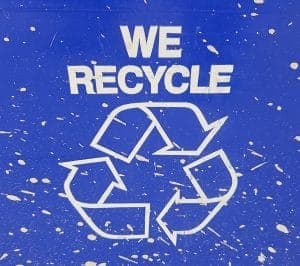
If you can’t sell the boat, and there is nowhere that we can donate it to. We are narrowing down our options to get this boat gone! Depending on what kind of boat you have, it might be recyclable.
If we are talking about an aluminum hull, then it will be best to recycle the boat and actually get a little money this way too!
If it is a fiberglass hull, then getting the recyclable parts off of the hull before we move onto the next step is a great idea as well.
Fiberglass hulls are not recyclable and must be taken to the dump. That is just the sad part about it. Which is what we will talk about next.
For a little more on recycling a boat read our article about How Much Can You Scrap A Boat For?
Trashing The Boat
We can’t sell it, we can’t give it away, it’s not recyclable. This leaves us with hauling it off to the dump and trashing it! Unfortunately, this is the sad fate of a lot of boats that are left to rot for many years.
Sometimes you can scrap the boat for money, or even sell it to scrappers for a little money. Here’s an article we wrote about the most important details when trying to Scrap a Boat for Money.
We talked about it a little bit already, but a fiberglass boat is not recyclable. The hull has to be taken to the dump.
Depending on where you live and the local waste companies that are in your area. You might be able to have someone come out and remove the boat. Sometimes you can find scrappers that will haul it off for you.
They will cut it up and part out the engine with its parts.
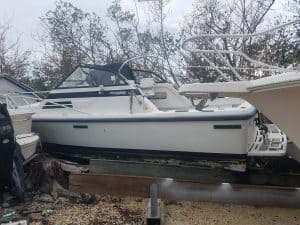
Then take off all of the other parts that are valuable to them to sell off.
This is something that you could do as well if you would like to. Take off all of the metal, rod holders, cleats, T-top, bow rail and everything else that is aluminum or metal and a recycling place will pay you for it.
Then you could also try and sell these items as well. That is if you would like to take a long time to get rid of the boat. Sure, you will get more money out of it, but it will take a lot longer to get rid of.
You will still then be left with the hull that has to make it to the dump, one way or another. You can pay someone to haul it off or you can load it up yourself and take it to the dump. That is if you have the trailer, truck and time to do all of this.
The scrappers will take it for free usually because they get the value out of being able to part out the boat and engine. Otherwise, there is no incentive for them if you have removed all of the valuable items.
Then you will be stuck paying them money!
Where To Begin
You should have a pretty good idea of what you are looking at in order to get that boat out of your yard. Beginning with assessing your situation and what your options are. The best thing to start with is figuring out that situation.
Then moving onto the title issue, and resolving that if it is in your best interest.
If the title is not a priority. It’s time to hit the phones. Call the local dump and ask if they provide services that fit your situation.
Then asking them if they know of any scrappers that would be interested in this. You can also look in the paper, on craigslist, or Facebook in yard sale pages.
Begin networking your way through the “scrapping or dumping” industry to find the right person that will come and get rid of the boat for you.
Then take a look at our Post It Note Goal’s article to get your to-do lists organized and complete your goals more effectively.
Check Us Out!
If you’ve got any questions or comments, let us know by subscribing to our YouTube Channel!
And if you would like to support us to continue bringing you great content, please click the link below to Amazon where we get a commission from anything you are already going to buy!
Click Here To Amazon!
And you can also donate by clicking the donate button here or on the right hand of the screen!
It really helps us out and we thank you so much for your support!
Thanks for reading and we look forward to reading your responses and comments.
Hopefully, this helped you out and gets you started in disposing of your old boat. If you have any questions, just ask us in the comment section below, and tell us about your old boat and how you got rid of it.
We’d like to invite you to come and check us out on our YouTube Channel: Born Again Boating! We make all kinds of helpful how-to and DIY boating videos. Along with in-depth outboard service tutorials.
Get subscribed to the channel and add us to your favorites so we can become your go-to resource when it comes to completing all of your DIY boating projects!
Aaron Hilligoss
Aaron has been working in the Marine Industry for over a decade and holds certifications for Yamaha and Mercury Marine. It is not uncommon for him to own and be working on at least three different boats at any given point in time!
Recent Content
Accidentally Put Boat In Reverse While Driving?
When running a boat. Things can pop up in the water in the way at any moment! And our first reaction is to pull out of gear. But. If You Accidentally Go Too Far And Put Boat In Reverse While...
Can I Run My Outboard Without A Poppet Valve?
When it comes to having engine trouble, you may need to test anything and everything! Even a poppet valve! Can You Run An Outboard Without A Poppet Valve? Yes, you can run the engine for...
There was a problem reporting this post.
Block Member?
Please confirm you want to block this member.
You will no longer be able to:
- See blocked member's posts
- Mention this member in posts
- Invite this member to groups
- Message this member
- Add this member as a connection
Please note: This action will also remove this member from your connections and send a report to the site admin. Please allow a few minutes for this process to complete.

VIDEO
COMMENTS
The most important catamaran design hull shape factor, is the Prismatic Coefficient (Cp). This is a measure of the fullness of the ends of the hull. ... It would be easy to prove one way or the other though. A catamaran hull is much like a frigate hull (similar SLR, L/B ratios and Froude numbers) and there is plenty of data available for those ...
Have you ever wondered the processes that go into Catamaran design and building a Catamaran? Maybe. Maybe not.However for those of you who are contemplating ...
Strike 15 trimaran at speed. 28ft Skoota in British Columbia. 10ft 2 sheet ply Duo dinghy. 24ft Strider sailing fast. 36ft Mirage open deck catamaran. Hull Resistance and Hull Shape Comparisons. Introduction. As I've said elsewhere, I only like to design boats that are fun to sail.
Catamarans As one of the oldest hull shapes (imagine two logs tied together), catamarans occupy a small niche in America and larger niches in some other areas of the world. Using two hulls bridged by a deck, the catamaran design provides additional beam, increased stability and, at the same time, increased speed (the slim twin hulls have little ...
T c = 0.57. Here we put B TR = 1.9 to minimize boat resistance (for her size) and get the draft calculation for a canoe body T c (Figure 1). Midship coefficient - C m. C m = A m / T c (x) B WL. We need to estimate a few coefficients of the canoe body. where A m is the maximum cross section area of the hull (Figure 3).
In the third part of our series, we talk again to Antoine Richer, the Naval Architect at Seawind about how bow shape, hull volume and freeboard affect the pe...
A third number that we can plug in as a constant if we want to is the prismatic coefficient which describes bow much volume there is end the ends relative to the cross section shape in the middle of the boat, but in sailing boats this is of less importance compared to other factors. The hull lines for Design 256, 8.5m Cat.
The Prismatic Coefficient (Cp), a measure of how full the ends of the hull get, is the most essential design hull shape factor for any catamaran. A high Cp equals high speeds, although you can still use a lower Cp if you have fine hulls. Nevertheless, the key to a good Catamaran design is a higher Cp for fast sailing.
Hull. A boat's hull shape and the distribution of volume are key factors in determining how it will behave in varying wind and load conditions. The underwater characteristics of a vessel are responsible for allowing a multihull and its cargo to travel through the water. The faster and more effortlessly the twin hulls can displace the ...
One has to be very careful when analyzing the Hull Fineness Ratio of a cruising catamaran, because other factors such as the actual shape of the hull cross sections (Prismatic Coefficient, PC) can throw the analysis off balance. Go-fast sailors like to think that fine hulls are always fast. That is not necessarily true because a slim hull could ...
Newer Lagoon catamarans use polyester and vinylester resins, also infused with balsa cores above the waterline and solid below. Catana. With a carbon fiber inner skin, Catana also uses Twaron aramid fibers in the sandwiched hull over a foam core. Fontaine Pajot. Primary hull construction is resin-infused vinylester with a balsa cored hull and deck.
An existing hull shape of a sailing catamaran currently being produced in South Africa could be used, or a standard hull shape of suitable characteristics could be used. In either case, a representative hull shape would need to be found in order to determine these characteristics. 2.4.1 Finding a Hull
Schionning Designs use three hull types for our range of power catamarans, each with different design and performance characteristics. The hull shapes are: Prowler Semi-displacement. Prowler VT (Vapour Trail) Growler Whisper. The semi-displacement hull is a slim hull shape with a canoe-end underwater aft, meaning this hull simply slides through ...
The unique shape of the Teknicraft catamaran hull lifts and enhances the performance of the vessel while maintaining a smooth ride and industry-leading efficiency. The catamaran hull form is a semi-planing type catamaran and employs a combination of symmetrical and asymmetrical sponson shapes, thereby combining the attributes of both shapes ...
There are five common boat hull types: Round-bottomed hulls - handle well in rough water: sailboats. Flat-bottomed hulls - very stable for calm inland waters: fishing boats. Multihulls - very stable and buoyant: catamarans. V-Shaped Hulls - fast and comfortable in chop: powerboats.
Long ago some genius in the Pacific joined two fast, easily driven canoe hulls into a beamy raft shape, giving a new type of sailing craft with the stability of the broad beam raft and the high-through-the-water speed potential of the single canoe. ... Catamaran B's Static stability, i.e. hull lifting point, lies on the borderline between force ...
On the other hand, the catamaran has extremely high form stability, but once the boat heels, it has little ultimate stability. In other words, beyond a certain point, there is nothing to prevent it from capsizing. Both catamarans and modern monohulls' hull shapes use their beams to reduce the amount of ballast and weight. A lighter boat can ...
Displacement, hull shape, and sail power are the key design features of an OE. The advanced hydrodynamic shape of the hull, designed by world-renowned naval architect Germán Frers, utilizes the optimal length to beam ratio to minimize the wetted surface and deliver true performance. ... The catamaran is designed for shorthanded sailing, and ...
With only one set of running gear in the water, inherent appendage drag is reduced by 20 percent. Combined with the efficiency of the hull designs, overall fuel efficiency of the Aspen rises to an impressive 70 percent over monohulls of comparable size. Aspen won an award for the best 30- to 39-foot catamaran in the world in 2014.
Catamaran sailing repair tips, pictures, forums and classified ads catamarans for sale by owner Hobie, Nacra, AHPC, Solcat, Aqua Cat for sale.
What kind of shape is the boat in? Is the hull in decent shape, or does the engine run? If the hull is decent and the engine runs, you probably aren't to the point of trashing the boat and taking a total loss on it. What does the trailer look like? Will it make 10 feet and the axle fall off or is it road worthy?
Boats and Yachts in California. YachtWorld presently offers 2,806 yachts for sale in California from well-qualified yacht brokers and new boat dealers who can often offer yacht financing solutions and extended boat warranties. Of these listings there are 887 new watercraft and 1,919 used boats and yachts for sale right now.
6590 Catamaran St, San Jose CA, is a Single Family home that contains 1000 sq ft and was built in 1970.It contains 3 bedrooms and 1.5 bathrooms. The Zestimate for this Single Family is $1,042,500, which has increased by $16,300 in the last 30 days.The Rent Zestimate for this Single Family is $3,399/mo, which has decreased by $110/mo in the last 30 days.